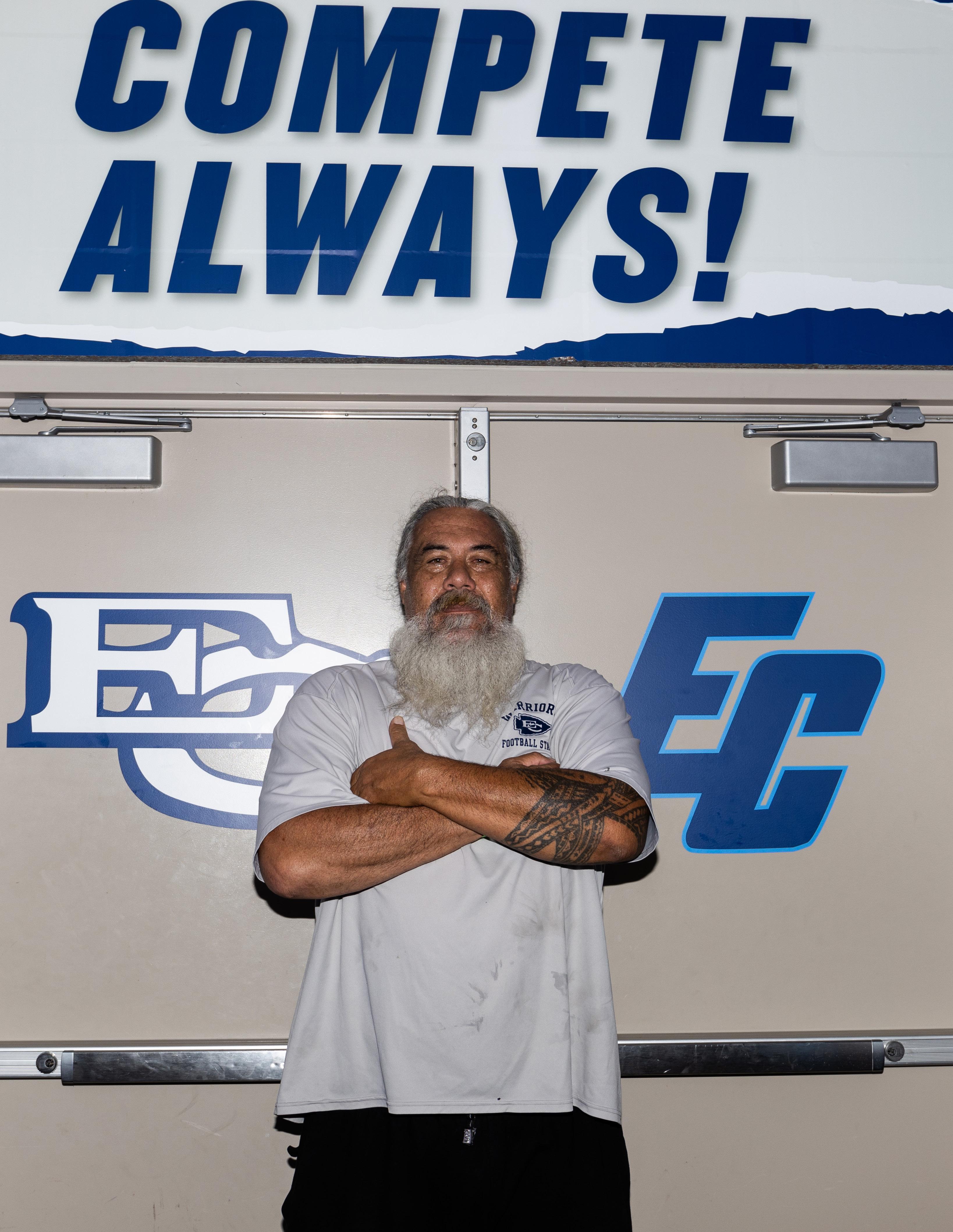Warrior Life
Meet Brenda Thames
Coach Ken Talanoa
Marcus Rodriguez
director
performance at



Brittany Parris
Elsa Rosales
Evanson Franck Love Gary Kohatsu Greg Fontanilla* Ivan Zermeno Jesus Canche Chan Jesus Cortez Jonte Williams Jose Tobar Katie O’Brien Kevin Marquez Khoury Williams Matheus Trefilio Maureen Linzaga Safia Ahmed Sharlisa Shabazz
Emily Bourassa Jesse Miranda Maureen Linzaga Safia Ahmed
Brittany Parris Elsa Rosales
Gary Kohatsu Greg Fontanilla* Jesus Cortez Jose Tobar Kim McGill* Matheus Trefilio Maureen Linzaga Safia Ahmed Sharlisa Shabazz
Jose Tobar
Editor-in-Chief
Elsa Rosales Adviser
Stefanie Frith
Amy Gaskin Gerard Burkhart
Chris Viola Doug Morino Jack Mulkey Kate McLaughlin Ryan Ritchie
These past few semesters I've been on the magazine staff have been challenging, but rewarding.`
The staff tried to get a good mix of stories. We tried to recognize long-time faculty. We looked for students doing something out of the ordinary. I think we did pretty good.
We hope you enjoy this issue. A lot of work was put into it. This is our yearbook, of sorts. This magazine shows who we are and we are diverse.
You can also also read these stories, and those that didn't make it into this issue, at www.eccunion.com.
Warrior Life is a student-run magazine. El Camino College students interested in being a part of the magazine must enroll in Journalism 9 for fall 2022 or contact Stefanie Frith at sfrith@ elcamino.edu for more information. Contributors marked with an * means thay are in other journalism classes.
Top 5 boba cafes in the South Bay
Young actress and high school senior is a rising star
Sunsets and fireworks
L.A.’s go-to broadcaster
Top 5 skateparks in the South Bay
A meticulously catalogued ECC family history
(Un)welcome to Lake Havasu City
Top 5 karaoke bars near El Camino College
Finding belonging across different spaces through art
You can’t beet ‘em! Top 5 vegan restaurants in the South Bay
Maestra
Top 5 Brazilian spots in the South Bay
Gone, but not forgotten
At the beat of his own drum
Dedicated to the sport of volleyball
I became a mom at 40
A story analysis of a murder victim: my dad
Just getting started
The fundamentals of sound
Top 5 public libraries that serve the ECC ccommunity
Crying in In-n-Out
Practicing self-care through naginata
5 places to get chickin wings within 5 minutes of ECC
Finding photography
Top 5 fabric stores within 15 miles of ECC
A sweet science dream
Back on her toes
Top 5 doughnut shops near ECC
Football Coach transcends the game
 El Camino College President Brenda Thames pauses at the construction site of the future Arts Complex Building at ECC on April 21. Brenda will have served one year as president in July.
El Camino College President Brenda Thames pauses at the construction site of the future Arts Complex Building at ECC on April 21. Brenda will have served one year as president in July.
As an 11-year-old girl, she grew up working on farms with her family, picking apricots and peaches as early as 3 a.m. during the summertime. Her family got paid by how many pallets of fruits they had laid out by the end of each shift and split the money between themselves. 13 siblings worked tirelessly on these farms: five brothers and sisters, five cousins and her two parents.
In her free time, she would play and frolic through cornfields where her family raised pigs in the central valley smalltown of Modesto, California. Now, Brenda Thames is the president and superintendent of the El Camino Community College District. Initially, Brenda never had aspirations of becoming a college president and taking on the title's many responsibilities.
Brenda's parents did the best they could with what they had. Growing up she did not have access to everything a child could want, however, Brenda had everything that she needed and that was enough for her. As a first-generation college student, much of Brenda's college life experiences were discovered independently. She had to adapt on-the-fly by learning about financial aid applications and how to fill out required documents for dorm rooms and registration.
After missing out on UC Berkeley's lottery system, she showed up on her first day of college without a place to stay or any money in her pockets. Left without options and a clear path ahead, she reached out and called her mother for help. Immediately after that call, Brenda's mother had set her up with a place to stay thanks to her connections formed through their church.
administration and the other in social work from USC and lastly, she earned her doctorate from Oregon State University.
“Someone told my parents, if she goes to Berkeley, she can write her own ticket,” Brenda said. “For someone to tell your parents that as a first-generation college student…the significance and the weight of that opportunity was not lost on me and they were right. I was essentially able to leverage that [first] degree to open up many doors."
After years of being accustomed to working with her family on different farms, The first job opportunity that Berkeley opened up for Brenda was in social work.
“I started out as a social worker and I was going to save the world and give back through social work. I wanted to spend the rest of my career helping people improve their lives and I thought social work was the way that I was going to do that,” Brenda said.
Through social work, Brenda started out doing county-specific investigative caseworker jobs such as working with Child Protective Services. Recognizing that the public’s perception of Child Protective Services is negative, Brenda enjoyed her time working with the organization due to its correlation with her passion for helping people.
...I was going to save the world and give back through social work. I wanted to spend the rest of my career helping people improve their lives and I thought social work was the way that I was going to do that "
— Brenda Thames“Most people hate Child Protective Services but I loved it. I enjoyed helping those families reunite and helping parents with getting to become better parents and helping children to adjust and navigate their trauma,” Brenda said.
UC Berkeley was the place that allowed Brenda to grow both personally and academically into the woman that she is today. Attending college is where Brenda discovered her passion for helping others to improve their livelihoods; a trait that would follow her throughout her entire career. Brenda said that she is a people person who enjoys watching people from afar just as much as she enjoys getting up close to know each individual and learning about their stories and needs.
Brenda would eventually graduate from Berkeley with a bachelor’s degree from double-majoring in sociology and social welfare. Brenda would also go on to achieve many different accolades from a variety of colleges after her time at Berkeley. Brenda received two master’s degrees from USC, one in public
After working for Child Protective Services, Brenda received an opportunity to work for the Corrections Department. She felt inspired by the idea of helping those who were wrongly convicted, however, a big change in her life made Brenda change her entire career course.
“I loved working in corrections until I had my kids, then working in the prison became a little less appealing. After I had my daughter, I had a different view. I was writing parole recommendations for people that I didn’t want out on the street or living next to me,” Brenda said. “After I had my daughter, I couldn’t be objective and that wasn’t fair to [the inmates] because they weren’t my clients and it wasn’t fair to me.”
Brenda is a married mother of two children, a daughter (25) and a son (18). Brenda holds her family very close to her. Brenda's experience working throughout her entire career, including her
social work, she hopes to pass on the values of humanity and respect to her kids.
“I hope that I have and continue to instill in [my children] that you always recognize the humanity in the person that’s sitting in front of you…and that you remember how important it is that you share that space with civility and respect,” Thames said. “Sometimes you have to give up space to allow somebody else the equity they need to occupy the same space with you.”
With a renewed outlook on life that still adheres to her original dreams of “saving the world”, Thames embarked on a new career journey outside the field of social work and into public education. Thames accepted an opportunity at Modesto Junior College to become an adjunct instructor and also to direct TRIO Student Support Services, a program designed specifically to support lowincome first-generation college students.
Brenda would eventually work at a total of five community colleges throughout the state of California, spanning over 20 years' worth of experience. After Modesto Junior College, Brenda went on to work as the Director of Transfer and Articulation for the Los Rios Community College District.
After the Los Rios Community College District, Brenda moved on to American River College in 2009, where she started off working as the Director of Matriculation and Assessment, a position where she garnered a lot of respect and support from her colleagues. Eventually, when American River’s district started looking to hire someone for their vacant Department Chair position, Brenda won the position by write-in vote, beating out all other candidates.
Brenda also received her first administrative positions as Interim Dean of Student Development and later Dean of Counseling. After her time at American River College, Brenda would go back to
Modesto in 2012 before accepting her first superintendent position as president of West Hills College in Coalinga, California from 2017 to 2021.
After some encouragement from her friends, Brenda got notice that El Camino College was looking for a president to replace El Camino’s previous presidential position held by Dena Maloney, who served as the college’s superintendent for five years before her contract expired in June 2021. Being more accustomed to the quieter small-town life, Brenda was initially hesitant about vying for the position.

“I cannot afford to live in L.A., I don’t want to live in L.A., I don’t even like L.A….and [my friends] kept encouraging me. When I started to look at [El Camino College], I saw how diverse it was, the beautiful campus. I saw some of the programs and things that El Camino was doing with social justice and equity,” Brenda said. “It feels like it might be a good fit.”
Equity was a big driving force for Brenda to prioritize the presidential position at El Camino College and it remains one now that she has the position. Although talks of equity have seen tremendous growth in recent years, Brenda views equity as a true actionable outcome more than its popularity as a word. Equity plays a huge role in Brenda's dream to give back to the world.
“I came to join El Camino and what it was doing because it’s doing a lot of things that I believe in and I think there’s not a lot to fix here. Every place has got its problems but it wasn’t broken. You don’t get a chance to go somewhere and really take what’s done and move it to the next level very often,” Brenda said.
On May 17, 2021, Brenda was officially announced as the next president of El Camino College.
Stepping in to lead a college during the middle of a global
El Camino College President Brenda Thames stands in front of the college's Schauerman Library on April 21. The majority of Brenda's favorite places to visit on campus are linked to El Camino faculty and staff members that she enjoys working with and greeting, like the librarians.pandemic is a hard task on its own, but adding the collective trauma from recent incidents of racial injustice and social unrest combined all makes that leadership role a tougher challenge, however, Brenda was ready and willing to take on the task at hand. She knew that the El Camino College community would require connection, support and healing.
“I think [the college] is doing some amazing work but I don’t ever want us to think that we’re done because there’s always so much more work to do. Some folks have been marginalized and disenfranchised for so long that we have to do educating and bring awareness through events and things,” Brenda said. “We also have to do some healing and I don’t know that we’re quite there yet.”
Brenda hopes that El Camino College can get to a place where all students that attend El Camino College can feel supported and accepted no matter their ethnicity, background or financial status.
Colleges throughout the state of California and across the nation are facing the same challenges that have been brought on by both the pandemic and racial injustice. Fullerton College’s Interim President Gilbert Contreras said that he and his administration are similarly prioritizing healing and a sense of safety in their community.
“On [Fullerton College’s] campus, there was a lot of difficult
conversations around race following George Floyd and our participation around equity alliance through USC. There was a real need to reinforce our values through respect and collegiality,” Gilbert said, “We are actively redesigning our support services and our campus to meet the needs of safety and a sense of belonging for our community as they gradually return.”
Brenda said that part of her equity-focused plans at El Camino College is to hire a Director of Success specifically to help men of color due to men having lower success rates on average than women of color, in addition to adding more educational and support programs.
In her free time, Brenda is an avid reader that consumes mostly self-help books over all other genres. In her office, Brenda has a grand collection of books. Brenda reads books that highlight African American women’s contributions to American culture, books about teaching and engaging men of color in community colleges and most recently, she finished a book about establishing trust in all aspects of life called “The SPEED of Trust” by Stephen Covey.
Brenda got accustomed to working without keeping many personal items around because it was not allowed during her time working with the California Department of Correction Office. Over her 20-year service to various community colleges around the state, Brenda slowly began adding more personal items from her books to the graduation plaques that she received from all of the colleges she attended. One personal belonging that Brenda holds very near to her is a picture frame drawing of her and her family that was illustrated by one of her mentors, Manuel Pérez.

“I know that [Brenda's] close-knit relationship with familia is very important to her. I think many might interpret [the drawing] as a disconnect but what I learned from my relationship with Brenda is that it’s quite the opposite,” Manuel said. “I think Brenda loves and cares so deeply that she wants to ensure what she presents forward is precisely what she wants folks to know of her and what it means to bring others into her sacred world."
Manuel, now Vice President of Students Services at Cañada College in Redwood City, first met Brenda while working as the Dean of Student Development at American River College in 2009. Manuel interpreted the drawing through Brenda's words and experiences she shared about her family and envisioned the illustration in a way that most family portraits are depicted.
The illustration was given to Brenda as a parting gift in 2012 when she returned to Modesto Junior College to become Vice President of Student Services and Instruction. Manuel often refers to Brenda as his “hermana” due to their close relationship as colleagues and friends. They both looked out for each other while working as people of color in administrative positions and would constantly push one another.
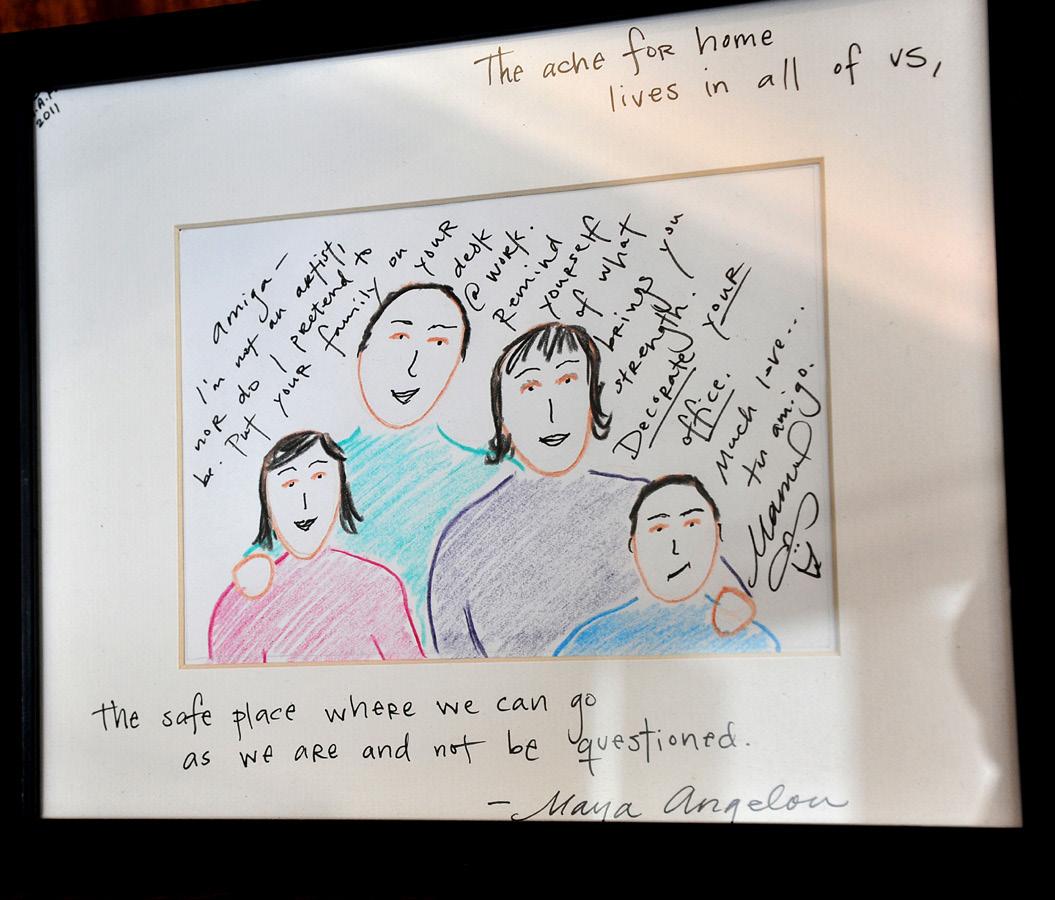
El Camino College President Brenda Thames shares a smile with a student as she tours the campus to visit her favorite places around El Camino on April 21.

As important as it is to form close bonds with colleagues from work, both Brenda and Manuel emphasized the importance of getting to know the student population that they serve both individually and collectively. The only way to know about a student’s needs is by talking with them and for students to reach out and speak with their administrative leaders.
“Getting to know administration and leaders at a college campus is one way to further anchor our humanity and the heartbeat that brings out our shared values. These moments to learn more about the stories, background and humanity of folks seen as holding authority in institutions is a way to destabilize power that becomes toxic,” Manuel said. “It’s a way to remember that we’re all folks trying to make our communities stronger.”
Since taking office in July 2021, Thames has held multiple community-wide town hall meetings to discuss public matters regarding the campus and the college institution as a whole. Thames is currently working with El Camino’s Student Services office to find a platform where she and Student Services can
This work is like my life song. To impact 20,000 lives through giving back and making their lives and their communities a better place just for having shared this place with them. I think it's saving my part of the world.
"
address students’ needs on a more private and individual level.
With a 10-year plan and vision set in place, El Camino College is where Thames plans on retiring, with a total of 30 years of service with community colleges by the end of her career. Her ultimate goals for El Camino College are for the institution to become an Aspen Prize-winning college in community excellence, to erase the equity gap and for the college to be nationally known as an incubator and talent provider for men of color in both Science, Technology, Engineering, Math and in aerospace programs.
Having first worked on a farm with her family at 11-years-old to venturing out on her own as a first-generation college student, Brenda discovered a passion for helping people to improve their lives through social and a 20-year career serving five community colleges throughout the state of California, Brenda remains hopeful and excited on her never-ending pursuit to save the world.
“This work is like my life song. To impact 20,000 lives through giving back and making their lives and their communities a better place just for having shared this place with them," Brenda said. “I think it’s saving my part of the world. That’s what I’ll say.”

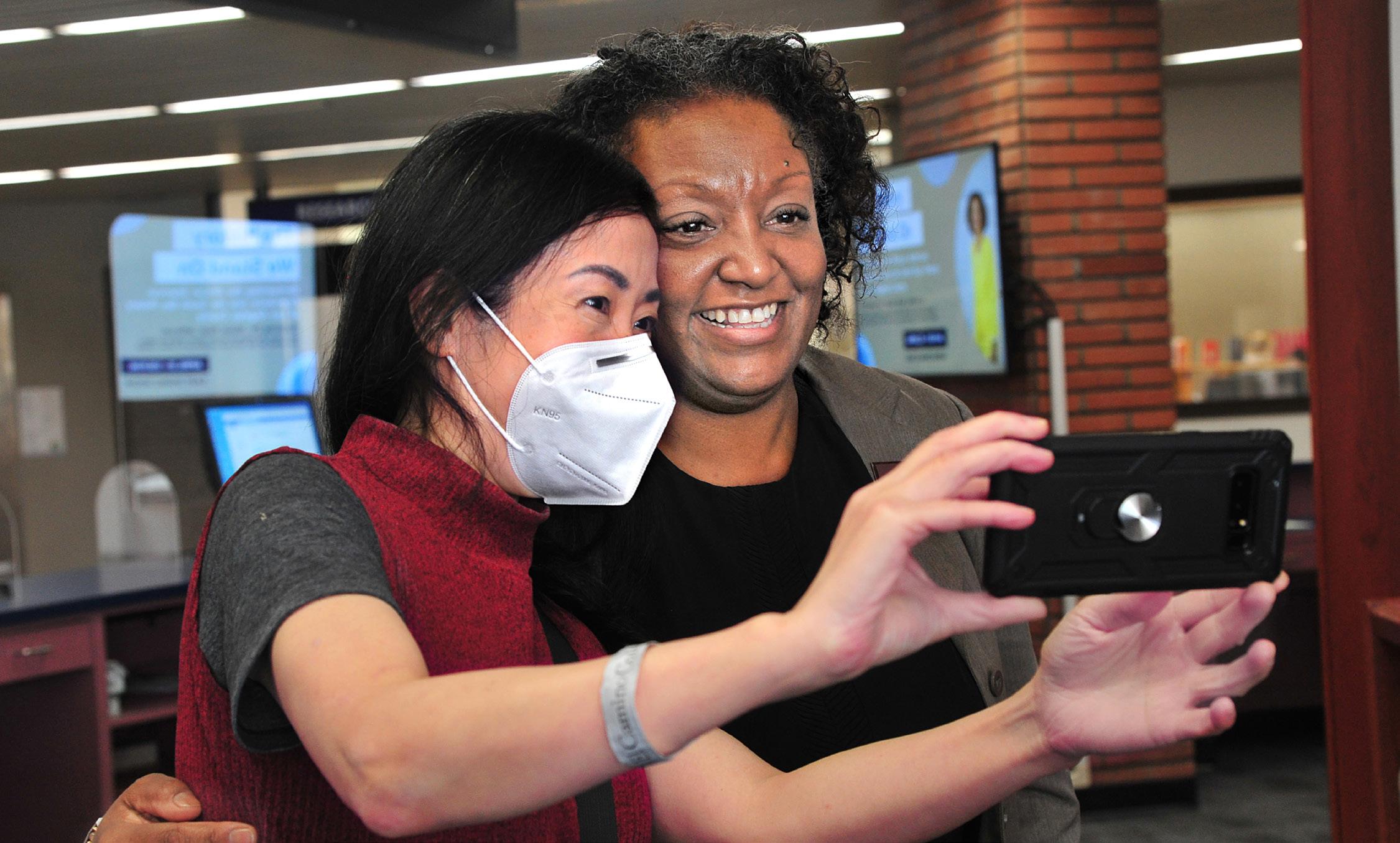 El Camino College President Brenda Thames, left, visits with Kim Cameron of the El Camino Warrior Pantry and Greg Toya, director of the Student Development Office on April 21. The Warrior Pantry is open Tuesday's and Thursday's from 11 a.m. to 2 p.m.
El Camino College President Brenda Thames, left, visits with Kim Cameron of the El Camino Warrior Pantry and Greg Toya, director of the Student Development Office on April 21. The Warrior Pantry is open Tuesday's and Thursday's from 11 a.m. to 2 p.m.
Here are some of the top boba places within 6 miles from El Camino College. Boba is chewy chunks derived from tapioca starch that is used in bubble teas. Boba, when combined with tea and milk, makes a rejuvenating drink.
Story and photos by Safia AhmedKokoroll Cafe in Torrance is a 15-minute drive from El Camino College. The cafe is elegant, yet minimalistic. A casual cafe that serves both beverages and food with a variety of boba drinks from milk teas to fruity teas. You may modify the sweetness degree of the bobas, which gives a signature touch to the tea while keeping it savory. Not only does the cafe sell bubble teas, but the cafe also serves meals including bowls, burritos, nori hand rolls, taiyaki, slushies, miso soup and smoothies.
Address: 22749 Hawthorne Blvd., Torrance Phone: 424-360-6341
The interior of Kokoroll Cafe in Torrance, a cafe that serves both food and beverages. It’s located six miles from El Camino College.

Hours: Tuesday-Thursday: 11:30 a.m. to 7 p.m. Friday-Saturday: 11:30 a.m. to 7:30 p.m. Sunday: Noon to 7 p.m. Monday: Closed Website: https://kokorollcafe.com/torrance Instagram:@kokoroll_torrance

Gong Cha in Gardena is an 8-minute drive from El Camino College. Gong Cha provides a rose-filled backdrop for customers to take photos with. In addition, the cafe offers a set of toppings for drinks. Toppings include pudding, rainbow jelly, milk foam, herbal jelly, ai- yu and basil seeds. Gong cha is one of the best spots for smoothies and milk teas. The employees create their own blend of various beverages such as coffees and smoothies. The cafe is clean and organized with seatings. The customer service is great and the drinks are served within minutes.
Address: 18203 S. Western Ave., Unit 103, Gardena Phone: 424-528-2113
The front of Gong Cha in Gardena, a lively cafe with an aesthetic setting. It’s located two miles from El Camino College.
Hours: Open daily: 11 a.m. to 9:30 p.m. Website: https://gong-cha-usa.com/ Instagram:@gongchatea
It’s Boba Time is a boba cafe that serves a variety of beverages including, but not limited to, acai bowls and shaved ice. It’s located four miles from El Camino College.

7 Leaves cafe in Torrance is an 8-minute drive from El Camino College. 7 Leaves is a tiny cafe that offers coffees, boba teas and macaroons. With a small menu, the process of ordering is less time-consuming. You have the opportunity to sample drinks before ordering them. The most popular boba drink is Thai milk tea, which has a proportionate amount of boba and tea, allowing the drink to be more consistent.
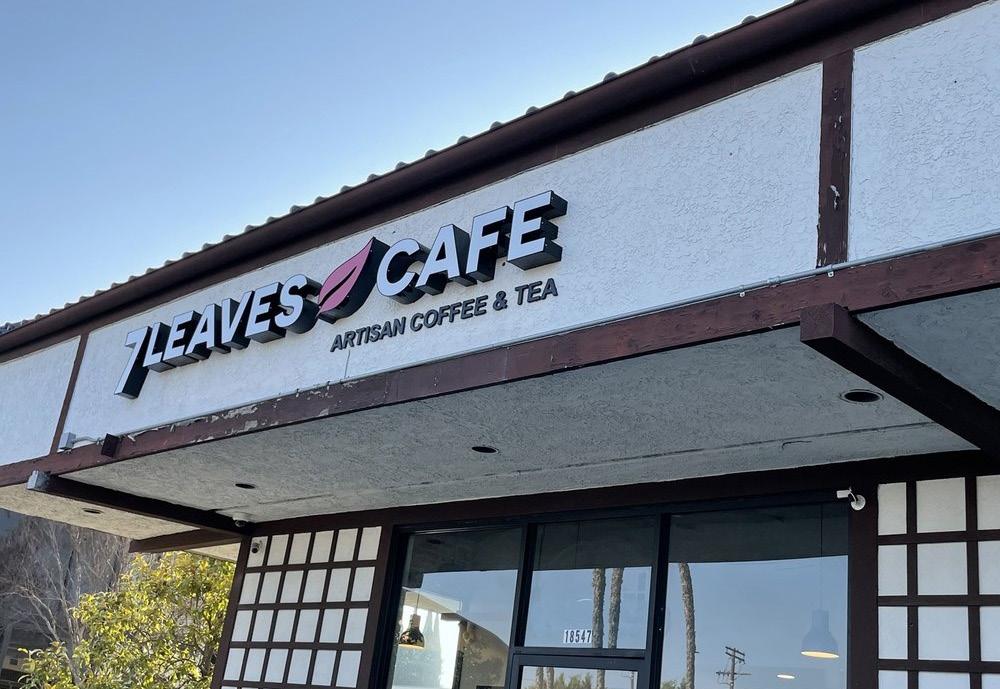
Address: 18547 S. Western Ave., Torrance Phone: 424-329-0538
Hours: Monday-Thursday: 7 a.m. to 10 p.m. Friday: 7 a.m. to 11 p.m. Saturday: 8 a.m. to 11 p.m. Sunday: 8 a.m. to 10 p.m. Website: https://7leavescafe.com/ Instagram: @7leavescafe

Sharetea in Torrance is a 14-minute drive from El Camino College. It's a popular tea house with several locations on universities in Southern California. The serving size for bubble tea is 24 ounces. Sharetea offers mojitos as their signature drink. The mojitos are offered in a variety of flavors such as lime, mango, peach and strawberry. The drinks range from milk teas, ice-blended teas, unbrewed teas and fruit teas. Customers can customize the sweetness level of the boba and select boba alternatives such as lychee jelly and red bean.
Address: 24208 Crenshaw Blvd., Torrance Phone: 562-241-6473
Hours: Monday-Thursday: Noon to 9 p.m. Friday-Saturday: 11 a.m. to 10 p.m. Sunday: 11 a.m. to 9 p.m. Website: https://www.1992sharetea.com/ Instagram:@sharetea
It's Boba Time is located in Torrance with a 13-minute drive from El Camino College and sells a wide range of the sweetest of beverages, including frappes and teas. The menu has a variety of smoothies, slushies, teas, acai bowls and shaved ice all prepared in a 16-ounce cup or bowl. The prices for bubble teas range from $3-5 (call to verify) and the environment is friendly. The boba has the ideal flavor to complement any beverage you choose.
Address: 2370 Crenshaw Blvd., Suite J, Torrance Phone: 424-558-3699
Website: https://itsbobatime.com/torrance/ Instagram: @itsbobatimehq
An artistic backdrop at Sharetea Cafe in Torrance, known to serve on several universities in Southern California. It’s located less than six miles from El Camino College. 7 Leaves Cafe in Torrance offers coffees, bobas and macaroons. It’s located just over two miles from El Camino College.Olivia Sullivent wears her vampire fangs from the Disney Launchpad short film "Growing Fangs" at El Camino College on April 28, 2022. Olivia is a dual-enrolled student, attending high school and community college at the same time.

Olivia Sullivent has been working toward her big break in acting since her first project at 10 years old — “The Flamingo Lounge” – a college student’s short film.
Finally, it came after years of auditioning for Disney when she was cast in the network’s 2021 short film, “Growing Fangs.”
But before she fell in love with acting, she fell in love with costume design — designing shoes was a passion. She used to want to work behind the scenes in a costume department, rather than center-stage. This changed when she discovered acting.
She found acting after she and her brother were adopted out of a bad situation in Tulsa, Oklahoma and eventually moved to Denver, Colorado. As a way of getting Olivia out of her shell, Olivia’s adopted mother enrolled her in acting classes.
Olivia immediately knew she loved acting. The ability to become another person was an incentive to her, from being able to understand how a character can say things to how they can move.
She’s had to get used to memorizing up to nine pages of a script in a short time span, such as 20 minutes, for projects like commercials. However, that wasn’t always a natural talent.
“I started off doing musical theater and summer camps and youth productions where it was very repetitive and coaches would have you play games to memorize,” Olivia says.
However, by the time she went to her art school in Colorado, “they would give you a scene at the beginning of the week and you would have three days to memorize it, they kind of left students to their own devices.”
Now, she says she can look at a script once and have it down in minutes after years of practice.
Since then, the 18-year-old has played the role of Dora in the Disney movie while attending online high school at Redondo
Union and taking classes at El Camino College.
She took journalism and political science classes in fall 2021 and sociology and communication classes in spring 2022.
She plans to attend ECC full time as an undecided major after graduating high school in 2022, but is drawn to journalism and French as it’s her second language. As for pursuing El Camino’s theater classes, she isn’t as sure if she wants to do that, as she says she has already gained experience at an acting school.
Olivia honed in on her acting skills growing up in Denver at The Denver Center for the Performing Arts but had a hard time fitting in class in Denver and high school after moving to Redondo Beach.
Upon her enrollment in ninth grade at Redondo Union High School, Olivia had great friends, but not everybody understood the reality of her commitment to acting, especially not RUHS.
In her first semester, she used up all her absences for the entire school year due to auditions. Her social life and academics struggled to stay afloat, but Olivia knew that pursuing acting was worth it and she decided to move to online schooling to better balance acting and academics.
The time commitment for Olivia not only meant missing her friends and school, but having to decide to give up a side interest in dancing for now and focus solely on acting instead. However, the most harsh aspect of the industry was the rejection.
She can’t recall how many times she was turned away for “not looking the part” even though every other girl who auditioned for the part looked exactly like her. She can’t remember how many times she was typecast as the “nerdy girl” because of her glasses and tall stature.
She can’t remember how many times she’s been told that she
just isn’t what a project is looking for.
As a teenager, she knows the rejection has changed her. But more importantly, she understands that she has an abundance of experience and success in an industry that isn’t always so welcoming.
Anyone who doesn’t come from the entertainment industry doesn’t have an understanding of what you need to have to make it as an actor or actress, experts say.
Holly Sneed, an adjunct theater instructor who’s been teaching at El Camino for about 14 years says that “more than anything, flexibility” is what makes an actor or actress good.
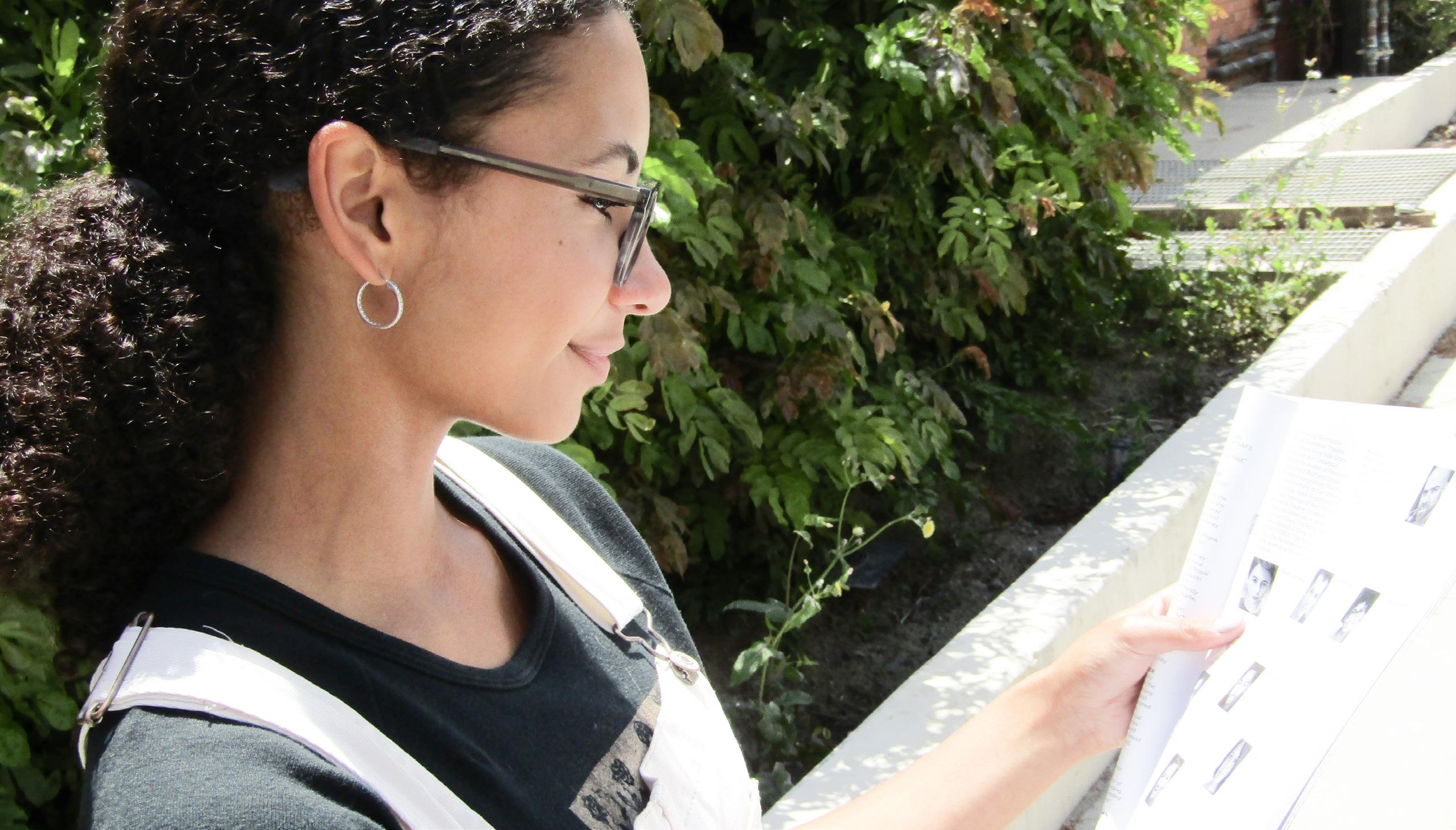
Making it as a star is rarely about being in the right place at the right time, it’s about rolling with the punches more often than not, Holly says.
“When you prepare for an audition, they give you the words ahead of time, but when you go in, nine times out of ten they’ll say ‘OK, now do it this way,’” Holly says.
What it comes down to is flexibility in terms of direction, but flexibility seems to be Olivia’s strength, and her portfolio is a dead give away when you look at all the projects she’s been involved in.
Olivia has grown her portfolio on and off camera. She’s been in theater productions of “A Christmas Carol” and “Who’s Tommy?” in Denver where she worked with people including Andy Mientus who was in “The Flash” and “Les Miserables” as well as Sara Capner, a Broadway star.
She’s worked on over 200 commercials, modeled and of course has starred in the Disney short film.
This June she will play a part in “Stages,” a musical created by Karen Tobey, her vocal coach and Colorado Children’s Theater owner, which is where Olivia and Karen met.
The musical is set to premiere for one night in Denver on June
17.
The 71 year-old coach has had record offers, has had leads in musicals, but “life just kept taking [her] to be a teacher,” Karen says.
Before she began teaching in Colorado, Karen says she taught in Los Angeles, producing over “100 working actors” today, including A-listers like Juliett Lewis, Brie Larson, and Joseph Gordon Levitt.
“Stages” has been in the works for 35 years, with the first premiere being 15 years ago with a third of the play completed, the second in 2017 being half completed, and the one in June being the first full production to premiere.
The musical follows a popular dyslexic teenager who moves schools after going through a difficult time; upon joining the new school he has a hard time adjusting until he meets a girl and joins the drama club where he learns from the “rejects” within it.
Olivia is playing a cheerleader named Maddie who is learning to love herself and those around her after realizing she won’t find it by sleeping around and being used by men. She’s “one of the emotionally crippled kids,” Karen says.
Before she flies out to Denver, Olivia is working on her craft. She has acting classes with William James on Thursdays and is one of the only teenage students who is in such an advanced class. On Fridays she works with Karen.
Olivia’s coaches and teachers say she is a rising star and she’s already getting recognized.
“Olivia is my best student,” Karen says.
She’s moved her way up in Nickelodeon’s casting process as she was one of only a few to be selected for the network’s training. She’s been recognized by Uber drivers who tell her she “looks familiar,” but the most heartfelt example of recognition to her
Olivia Sullivent shows her casting credit in a theatre program for "The Who's Tommy" performed at The Stage Theatre in Denver in 2018. Olivia has appeared in over 200 commercials, including Ford Motor Company's "We Lead."

were people reaching out to her on social media from her role in “Growing Fangs.”
However, making it as a star when you’re a teenager isn’t easy. Holly says it’s “not often,” but it helps “if you’re over 16 and you look younger than your age because you have a better chance of getting work.”
This is simply because of legality; a child under 16 years old can only work on set for so many hours due to child labor laws and the fact that they also need to attend school, often on set.
Another huge legal issue is Coogan’s law, which is upheld in California, and requires that the earnings a minor receives from their work is the minor’s money, not their parents, and that 15% of their earnings must be set aside in a trust account, or a Coogan account.
Before Olivia turned 18, she needed a child supervisor or guardian on set. This came with shorter hours and less pay.
“My mom had to be everywhere with me and the set teacher did too, I had to do school for three hours and I couldn’t get lunch by myself,” Olivia says. “Someone would have to have their eyes on me at all times.”
Needless to say, being over 16 comes with its perks if you consider how many restrictions are removed while you look young enough to still play teenage roles.
Since Olivia turned 18 in July, she says that being on set is easier now.
“There’s a lot of restrictions that are lifted, I don’t need a guardian on set and I can basically do whatever I want in the compounds of the rules that are established,” Olivia says.
She can drive herself to auditions and be there by herself without a supervisor or guardian today, and she often does during the week.
Olivia can confirm that it’s much easier to get cast if you’re a legal adult but can still play younger roles.
“All my auditions now are 18 plus because casting loves people that are 18 but look younger,” Olivia says.

While she’s enjoying the perks that come with being an adult on set, she says she’s also trying to re-brand herself away from the child she was as “a little skinny twig with big curly hair and glasses.”
“It’s a bigger deal now that I’m older and my agency and
(Left) Olivia Sullivent appears in a theatre program "The Who's Tommy." She has also appeared in "A Christmas Carol."
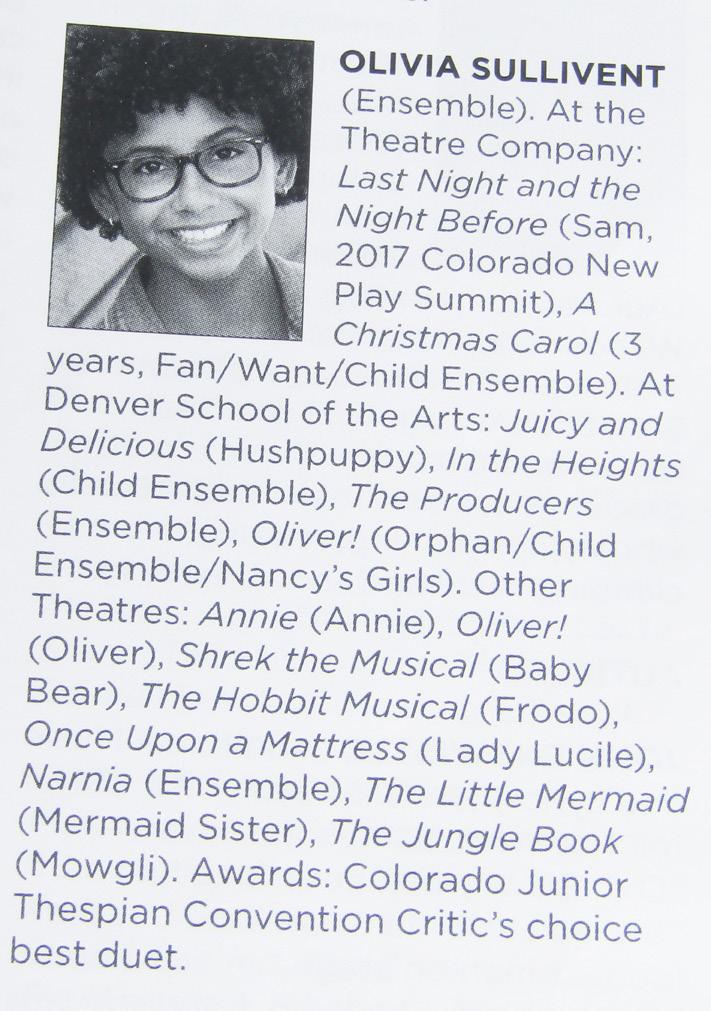
manager are very direct in telling me to look how I’ve branded myself,” Olivia says, “now I wear my hair back and my style is edgier… but everyone is on board and supportive.”
As for how a usual project process may go for Holly and Olivia, they start with an open call that are usually found on websites nowadays which provide a breakdown of character names and descriptive words.
Next is a “side,” or in other words a piece of a script they want you to prepare and memorize for an audition. After that would be a “call-back” where actors are paired with other actors to read scenes together.
People are typically cast after such call-backs, and a “readthrough” follows suit with stage directions and a group script reading. The rehearsal process usually begins after the “readthrough.”
For Olivia, “usually in a week you audition and get a call back a few days later,” but that isn’t always how it goes.
During the process for a printing project, she auditioned a few weeks prior to getting the part, but after not hearing back about anything, she assumed she didn’t get the gig.
Along with Tobey and James, Olivia credits her manager April Baker, her agency, Osbrink, her vocal coaches Marin Hill and David Kaufman, who voiced Danny Phantom on the selftitled Nickelodeon show, and her friends for being nothing but supportive.
Olivia’s talent and optimism radiates from her, and it’s obvious to everyone who’s been around her.
“She is going to go out and make the world a much better place,” Karen says, “her positivity is going to affect everything and everybody she touches.”
(Right) Olivia Sullivent in the music quad at El Camino College on April 28, 2022. Olivia graduates from Redondo Union High Shcool in June.

Hermosa Beach. We met one sunny afternoon to grab a bite to eat and walk around. The Lighthouse Café was our original destination because I wanted to show her the live music. I was hoping for a jazz band to be playing, but instead it was a pretty loud rock band.
The band’s volume being excessive led us to walk out and find somewhere else to eat. We roamed around for a bit. We were indecisive on whether to eat Brazilian or Italian food at first, but then decided on Italian and ate some slices of pizza plus some ice cream for dessert.
The food filled us up and left us wanting to relax. We noticed the beautiful sunset, so we walked toward the pier. The two of us stood silently standing at the pier admiring the sunset across the horizon. The silence was interrupted when she asked me, “Do you want to kiss me?” What came next felt like it was straight out of a movie. It seemed like the beginning of a fairytale.
Dialing it back to the previous month is where this relationship started. For the sake of anonymity, let’s call this woman Alexa. She was mesmerizing in my eyes. Long jet black hair, great taste in music, kindhearted and the most intelligent girl I knew. Alexa and I were good high school buddies turned lovers. I know, right? Friends to lovers arc that you have seen countless times.
I had invited her to a Paul McCartney concert knowing about our shared love for The Beatles. This night of fun is where it started by attempting foolish moves to hint at wanting to escalate the friendship to something bigger. A little bit of hand-holding during some of the songs and compliments of the flirty nature. The night ended with fireworks shining over the crowd at Dodger Stadium, but the real fireworks were in my heart.
These attempts ended successfully as the next week we scheduled a movie theater date which solidified the
relationship. I was filled with every positive emotion imaginable: elation, joy, happiness, etc. Now that I look back on it, I should have noticed the red flags, but it’s true what they say about love being blinding.
Alexa didn’t want anyone to know about us dating. I shrugged it off as testing the waters and that eventually, we would get to that point of being public. Little did I know that would never come to fruition.
I don’t regret diving into this relationship and hurting myself in the end by ignoring the troublesome signs. Experiencing the one month of having someone to build an emotional connection with was great. I got to live out what I had seen on the big screen. A movie romance with The Beatles as the soundtrack made life seem a little brighter.
All was going well until one day I had gotten a message to have lunch one August afternoon. I figured it was a quick lunch date to have before I had to head out for my upcoming classes at El Camino College. I was instead greeted with a conversation of ending the relationship to save the trouble of it crumbling later while we were both at our respective colleges.
I was speechless and confused at the same time, being left with a hug and a promise of staying friends. Alexa and I did end up staying as friends and even tried a second time to reconcile the romance, but that’s a story for another day.
The relationship taught me a lot. My approach now with relationships has changed a bit. I’m way more cautious when I talk to a potential partner and haven’t been in a relationship since it ended. I still see love the same way, in that it is something beautiful and I want it to be shared with everyone.
There was a lot to learn from this teaching moment. The lesson was that life isn’t always like the movies and that a happy ending is not always happy at first. Love falls apart in unexpected ways and even though it might be heartbreaking and cruel at first, it’s better for the long term.
A movie romance with a Beatles soundtrack made life seem a little brighter, but life isn’t always like it is in the movies

Beto Duran attends a baseball game between the El Camino College Warriors and the Harbor College Seahawks at El Camino's Warrior Field on March 22. Beto, who attended El Camino College, is an ESPN reporter based in Los Angeles.
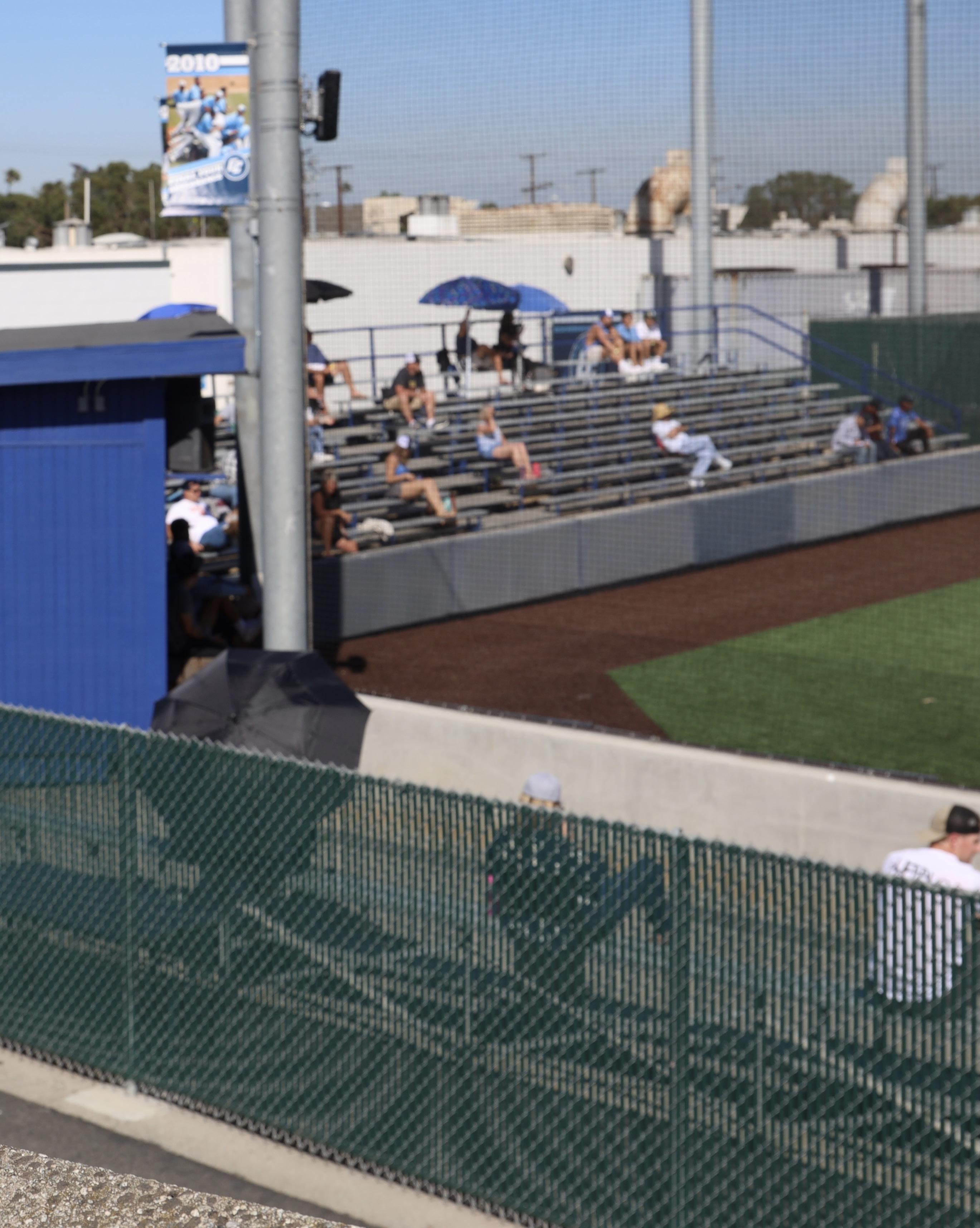
It is easy to tune into your favorite sports team and watch your favorite players. However, there are those, such as Beto Duran, who would much rather broadcast games.
Beto Duran was not always aware that he would be covering major sports teams. Before graduation in 1996, Beto enjoyed his time as sports editor of The Trailblazer newspaper at Carson High School, but he had not considered pursuing a career as a sports journalist. Instead, he covered his school's athletics in order to get free admission to games.
“It got me into the football games for free,” Beto says. “I would write the stories of this football team and basketball team. But it was just cool to do and it was easy.”
Following high school, Beto, like many students entering college, still had no notion of what career he wanted to pursue. Deciding to follow in the footsteps of his siblings, some of whom attended El Camino College, Beto decided that it was a wise move to also attend El Camino.
“I came to El Camino because it was cool because my siblings came here. I’m number five of seven. And all of us went to [junior college] because it was a smart financial choice,” Beto says. "I didn’t want to come here. I wanted to go to a university, but when I graduated, my brother asked me what I wanted to major in and I said ‘I don’t know.’"
However, Beto knew for a long time that his intention was to be a part of the sporting world. It is because of this fact that Beto explored many avenues when it came to searching for a career path. Going from sports medicine classes to law classes ultimately landed Beto in a journalism class.
"El Camino was a fun time in my life. I, like a lot of other students, came here not knowing what I wanted to major in. I thought I wanted to be a doctor,”
Beto says as he leaned over the concrete parking lot wall, overseeing the El Camino baseball game, “I thought I wanted to be a lawyer. I thought I wanted to be a politician. I had no clue what I wanted to do. All I knew is I wanted to work in sports.”

With no idea of a career path in mind at the time, Beto gained motivation from former ECC journalism professor Lori Medigovich.
"There was no example for me showing me I could do this,” Beto says. “This was the late 90s, so there were no Latinos on TV on English TV. It wasn’t that I needed it. But how am I going to go about being a reporter? That’s a job and it’s like how do you find that job? I don’t know anybody that does those jobs.”
In his early years, Beto saw many of his curiosities become interests. However, he saw those interests come and go. But it was one particular course that grasped his attention.
A Friday morning class with Lori, an adviser for The Union, saw Beto’s interest. The only problem was that Beto says he was a “terrible student” who showed up to class yet never completed the work.
“I loved the class so much that I never missed a class. But I also didn’t do the work so I’m pretty sure I failed the class,” Beto says.
Beto did not always shine in many aspects of his academic years, however, one thing remained true. Journalism had grasped his attention.
“I took chemistry and failed it. I took a biology class and failed it....
...I was a terrible student because I wasn’t interested in them. I was smart and I was curious, but I lost interest quickly. It wasn’t until I took a journalism class that the light bulb went on and I thought it was cool,” Beto says.
Due to having a natural attraction to sports, sports journalism ultimately captured Beto's undivided attention.
“I could not write a term paper. I could not write you a 20-page research paper, but if you need me to write you a game story in 15 minutes, I’ve got you,” Beto says.
With regular appearances on major athletic networks including SportsCenter, ESPNews, and First Take, Beto, 44, has earned a reputation as the expert on all things Los Angeles sports. He covers top sports teams, including the L.A. Lakers and L.A. Chargers.
Despite frequently appearing on major networks and podcasts, Beto has made an effort to reach out to community college students and offer them the opportunity to learn from his experiences.
Beto Duran overlooks a baseball game between the El Camino College Warriors and the Harbor College Seahawks at El Camino's Warrior Field on March 22. Beto played baseball and ran cross country in high school.Inviting Beto to speak to multiple classes in hopes of motivating the students in the same way Lori motivated Beto, Gary Metzker, a journalism professor at Long Beach State University, had nothing but high praises for him.
“I asked him [Beto] if he would come and speak to my sports journalism at Long Beach State,” Gary says. “And from there he embarrassed the shit out of all of the students because they weren’t doing anything.”
Daniel H. Birman, a professor of Professional Practice at the University of Southern California who specializes in teaching students documentary as a journalistic pursuit, sees the complexities of students interested in pursuing a career in journalism.

“What we look for in a journalism student is someone who is a critical thinker. Someone who is curious, someone who is fair," Daniel says.
It's difficult enough to break into journalism. Beto, on the other hand, takes it upon himself to offer guidance to those who are prepared to listen.
“El Camino was a fun time in my life,” Beto says reminiscing of his time at El Camino College.
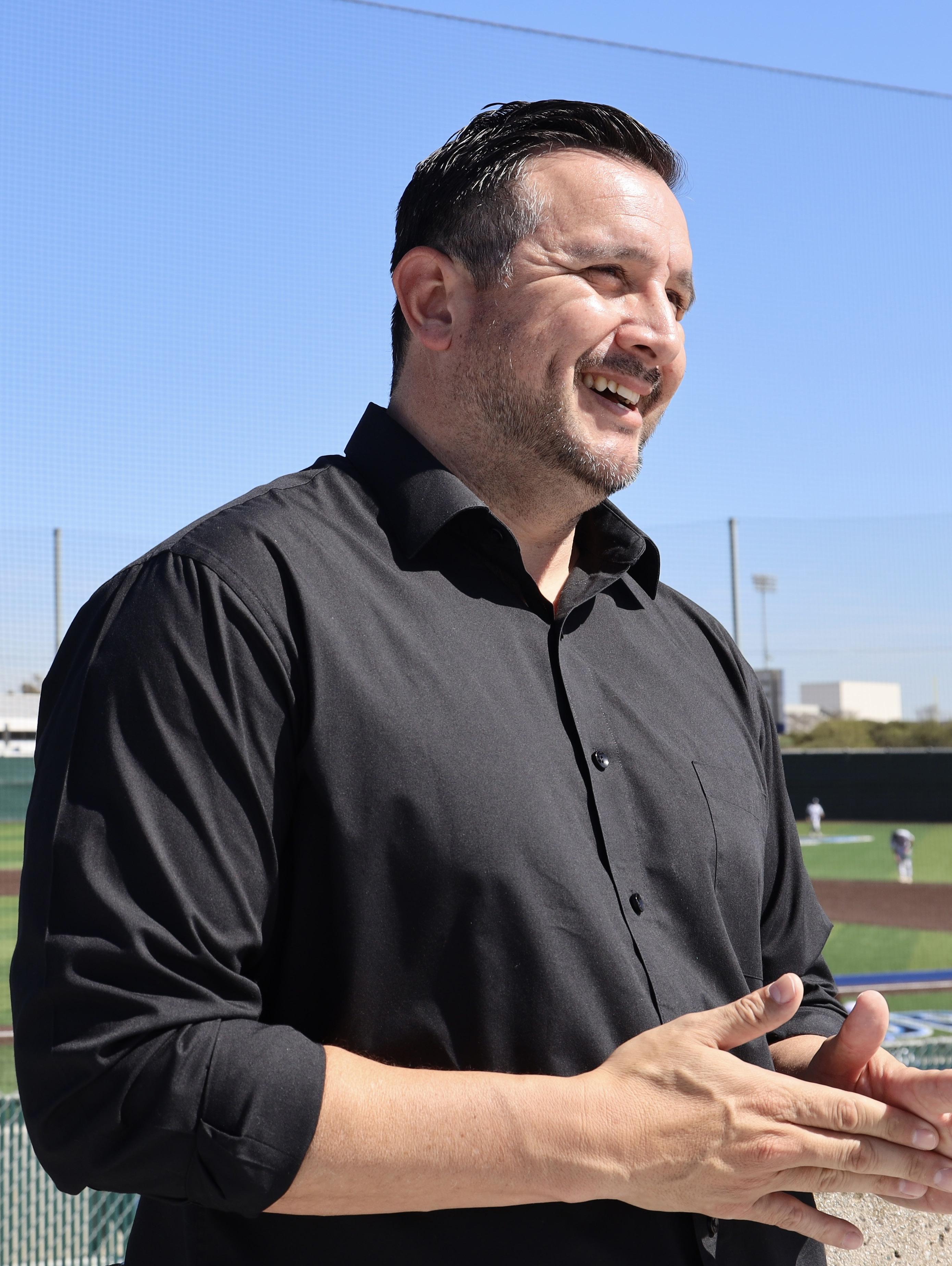
"I want to inspire the next generation of journalists," Beto says. "I go to these conventions to give the real talk about the stuff you are not going to learn in class. The classroom information is very, very important, but I give the real-world talk of what I’ve dealt with in my 20 years in business."
Individuals in sports broadcasting must be able to venture outside of their comfort zones. Beto hopes to share his experience with students who want to follow in his footsteps in this class. In this profession, curiosity is indeed important, he says.
Beto does a lot of things behind the scenes, in addition to visiting conventions and giving advice. Beto wishes for many of his peers to achieve success in the same way that he did.
Rahshaun Haylock, a KTLA 5 sports reporter who has worked with Beto since spring 2007 and covers the L.A. Sparks as a play-by-play announcer, recounts occasions in their working relationship when Beto reminded Rahshaun of himself striving toward the same goal.
“The first time I met him I just thought he was someone like me, just trying to come up in the business. It wasn’t until after that I first met him that I realized that he was doing some work for ESPN Radio and I realized there were more similarities between us,” Rahshaun says.
Even when working with Beto for the first time, it seemed normal for him to offer assistance to his fellow reporters. So much so, that when one of his peers struggled to form coherent sentences in front of the camera, Beto would do what he always does and offer assistance.
“He was working at ESPN and I was at CBS KCAL as a production assistant. And we were at a Clipper game and after the game, we attempted to shoot a stand-up,” Rahshaun says. “It was inside of Staples Center and I was trying to shoot this stand up and the words would not come out. I was so nervous. Beto was there and after about maybe three or four takes he came from behind and pulled me to the side and tried to calm me down and gave me words of encouragement.”
Rahshaun says Beto is passionate about the next generation
of journalism students, especially those where Beto grew up.
“He’s taken me along with him to a couple of different high schools. However, he doesn’t sugarcoat anything. He’s going to give it to you raw and tell you exactly what it is that you’re getting yourself into,” Rahshaun says.
After years of hard effort, Beto says he is now able to enjoy the moment, which is something Rahshaun cherishes with his friend.
“Both of us coming up and we’re able to attend and work a lot of Laker games and so, just our post-game festivities after those games, whether back at one of our houses or at the JW on New Year's Eve night after a Lakers game,” Rahshaun says.
While Beto may now reflect fondly on a 20-year career in sports broadcasting, he is now focused on not just continuing his stellar profession, but also inspiring the next generation of journalists in the same manner that many have done for him.
“I’ve been blessed to do this business for 20 years and I’ve gotten so many great opportunities to make great experiences ‘cause I’ve had great mentors to show me the way. If I inspire you to chase your dream, whether it be a doctor or lawyer or whatever you want to be you know, that’s great. That way people who come from Carson or who come from a junior college can also say they chased their dream and they got to experience that,” Beto says.
Internship at CNN 2000 Democratic National Convention. Internship Los Angeles Clippers 2001- 2002 season.
Appeareances on SportsCenter, ESPNews, and First Take. Senior Reporter 710 ESPN Radio Los Angeles.
"He doesn’t sugarcoat anything. He’s going to give it to you raw and tell you exactly what it is that you’re getting yourself into,” Rahshaun says.

 Written by Jose Tobar Photos by Jose Tobar, Elsa Rosales and Gary Kohatsu
Written by Jose Tobar Photos by Jose Tobar, Elsa Rosales and Gary Kohatsu
While not an exhaustive list, and in no way offer the infinite possibilities of the beloved concrete jungle, these skateparks can at least provide for some temporary respite within their controlled environments in which tricks can be improved and perfected by all stages and ages without the nuisance of the daily battle outside for the public space. But always remember folks, “Skateboarding is Not a Crime.”
Located inside of Alondra Community Regional Park and within skating distance from El Camino College, Alondra Skatepark is open daily from 10 a.m. to 7 p.m. It features two concrete bowls for vert skating (pool ridin’) and a street arena with manual pads, handrails, a fun box, ledges and stairs. And when you finally tire of all of that, you can take a break by feeding the ducks and squirrels while taking a stroll around the lake in the park with your friends or that loved one.
Address: 3353 Redondo Beach Blvd., Gardena Phone: 310-532-5303
Hours: Open daily: 10 a.m. to 7 p.m.
Tucked within Arthur Lee Johnson Memorial Park at 170th Street and South Park Lane is the Marc Johnson Skate Plaza, located next to the basketball courts in Gardena. Built in 2012, you will find yourself launching off a five-step Hubba reminiscent of the Embarcadero’s legendary skate spot before it met its demise at the hands of San Francisco city leaders who had it demolished in an effort to get rid of those pesky skateboarders of yore. The plaza’s 7,000 square feet boasts of gaps, banks and stairs, that according to Spohn Ranch, the park’s builder, is a favorite amongst pros “as a warm-up spot before hitting the streets.”
Address: 1235 W. 170th St., Gardena Phone: 310-217-9563
Hours: Open daily: Sunrise to sunset
Silhouetted stencils of skateboarders adorn the walls at Alondra Skatepark in Gardena, Calif., on Nov. 30, 2021. (Elsa Rosales | Warrior Life) Local skater Damian Turcios, 19, Kickflips up the Euro-Gap at the Marc Johnson Skate Plaza in Gardena, Calif., on Nov. 27, 2021. (Jose Tobar | Warrior Life)
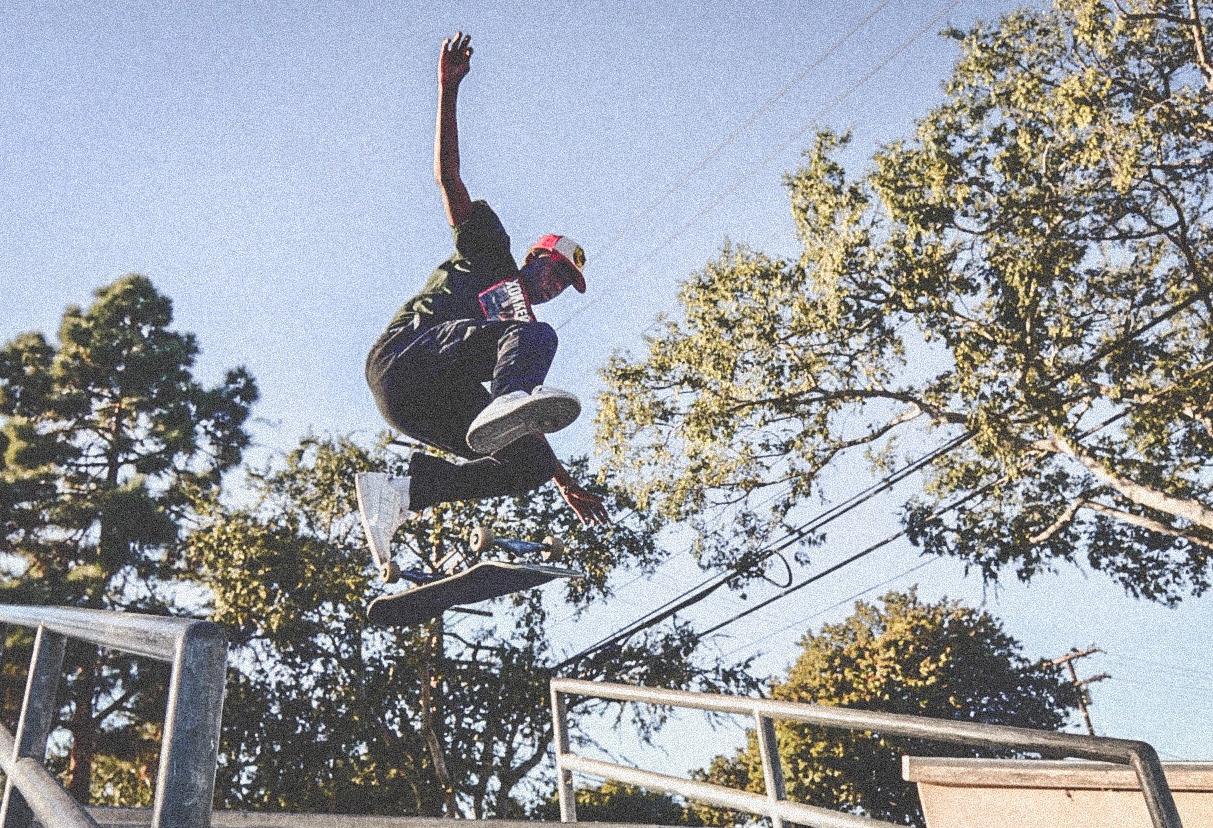
Tired of coming up against that nasty, hostile architecture designed to thwart skateboarders from gliding through life from spot to spot with tiled, studded sidewalks and clamps attached to what can otherwise be some pretty waxable and grindable ledges? Head to Harbor City Skatepark. Its 11,000 square feet skate terrain welcomes you with open arms.
Address: 24901 Frampton Ave., Harbor City

Although the last SUS Sundays skate jam event hosted by the If Skate Company happened here in March 2021, the spirit and the vibe of the movement created to inspire skateboarders of all ages, sizes and biological makeup to simply skate and have fun is still fresh in the air. The obstacles and terrain offers enough ledges to get your grind on for days without losing your bearings.
Address: 13220 Van Ness Ave., Gardena Phone: 310-217-9562 Hours: Open daily: Dawn to dusk
Within Eucalyptus Park is the skatepark known to locals as “the dirty.” It hosts both a big bowl and a little bowl and ample room for all. This park usually has a mix of bikers, roller skaters and skateboarders all existing as one big happy family enjoying its various skate amenities like banks, platforms, volcanoes and rails.
Address: 12022 S. Inglewood Ave., Hawthorne Hours: Open daily: 24 hours
Skateboarders and scooter riders are entertained with plenty of handrails, launchers, a staircase and a bowl at Harbor City Skatepark in Harbor City, Calif., on May 25, 2022. (Gary Kohatsu | Warrior Life) Anthony Bailey, 15, busts a 360 Kickflip off a set of stairs at the Rowley Park Skate Plaza in Gardena, Calif., on Nov. 27, 2021. (Jose Tobar | Warrior Life) Inglewood resident and skateboarder Abraham Hernandez, 24, skates “the Dirty” at Eucalyptus Skatepark in Hawthorne, Calif., on Nov. 30, 2021. (Elsa Rosales | Warrior Life)
Specialist Laurie Pelayo shares a photo of her children (L-R)
Alyse Pelayo, Alec Pelayo and Lessa Pelayo-Lozada on Wednesday, Oct. 20, 2021, in ECC Schauerman Library. Laurie, her father, mother, brother and all three children attended ECC.
In 1984, she was a 21-year-old student in her third year at El Camino College and working part time as an assistant in the ECC library.
She married in 1985 and had her first child that same year. She had planned on getting her associate degree,but her focus at that point was her family and making a living.
Laurie Pelayo, 58, is a library and learning resources specialist, now in her 40th year of employment at ECC. She has dedicated her career to the ECC library, meticulously cataloging and processing new material, which includes entering computer records, barcoding and labeling books.
And 17 years ago, in 2005, she got her degree in history. “Everything kind of happened in 2005,” Laurie says. “The cool thing is (my) kids were pretty understanding and I think I set a good example for them.”
Her hazel eyes gleam behind cat eye-framed glasses, accompanying a friendly and energetic demeanor. Dark brown, wavy shoulder-length hair frames her fair complexion. She spends her days surrounded by books and wears the school name with pride.
Laurie has been married for 37 years to husband Alden Pelayo. She has three grown children and all attended ECC. Her eldest daughter, Lessa Pelayo-Lozada, 36, followed in Laurie’s footsteps, and what’s even more unique, is that Laurie got to graduate together with Lessa.
“We both graduated in 2005. So we marched together, except she was (on) the honor roll and I was not,” Laurie says.
Lessa went on to graduate from the University of California, Los Angeles. She is an adult services assistant manager for the Palos Verdes Library District and was recently elected president of the American Library Association. Her term starts in June.
Son Alec Pelayo, 31, has a culinary degree from The Art Institute of California, Santa Monica, but changed careers and was in the paralegal program at ECC in fall 2021.
Her youngest daughter Alyse Pelayo, 22, studied anthropology at ECC, then transferred to UCLA in spring 2020. She graduated in June 2021 and is working part time at ECC as an assistant library and learning resources specialist in the ECC Music Commons.
Laurie’s children aren’t her only family members to attend ECC. It started with her father Robert Pooler, who was in the United States Army Air Forces during World War II. When he got out of the service, he took community college classes in New York, then relocated to California.
“He wanted to continue (his education) here and El Camino was
brand new, so he started taking classes in probably 1949 or ‘50,” Laurie says.
Robert appeared in two of ECC’s early theater productions on campus. He starred in the lead role in the Shakespearan play “King John” after being recruited for his strong skills in speech class. He also appeared in “Finian’s Rainbow” in a supporting role as a leprechaun, but ultimately graduated from ECC with a degree in chemistry in 1952.
Her mother Ruth Pooler saw the opportunity to take classes at ECC and would accompany Robert.
“She would ride with my dad. While he was in class, she’d take sewing classes,” Laurie says.
Laurie’s brother Michael Pooler, who is 17 years her senior, was in the United States Air Force during the Vietnam War. Michael studied Russian at ECC and did intelligence work for the Air Force.
“When he got into the service, they found out he had taken Russian and they were like, ‘Hey, what would you like to do? We have a plan for you,’” Laurie says.
When he got out of the service, like his dad, he studied chemistry at ECC, then transferred to California State University, Dominguez Hills, where he graduated in 1972.
Laurie has been researching her family tree since she was a student at Torrance High School and has traced it back to the 1600s. She even travels once or twice a year to the Family History Library in Salt Lake City, and through her research she discovered she had ancestors that were on trial for witchcraft.
“There was an article on some students back in Salem, Massachusetts that were trying to clear this particular woman that was accused of witchcraft,” Laurie says.
Laurie is a direct descendant of the woman’s sister and mother,
“‘Do you ever not go to a library?’ and I’d say, ‘Well, no, not really,’”
- Laurie Pelayo
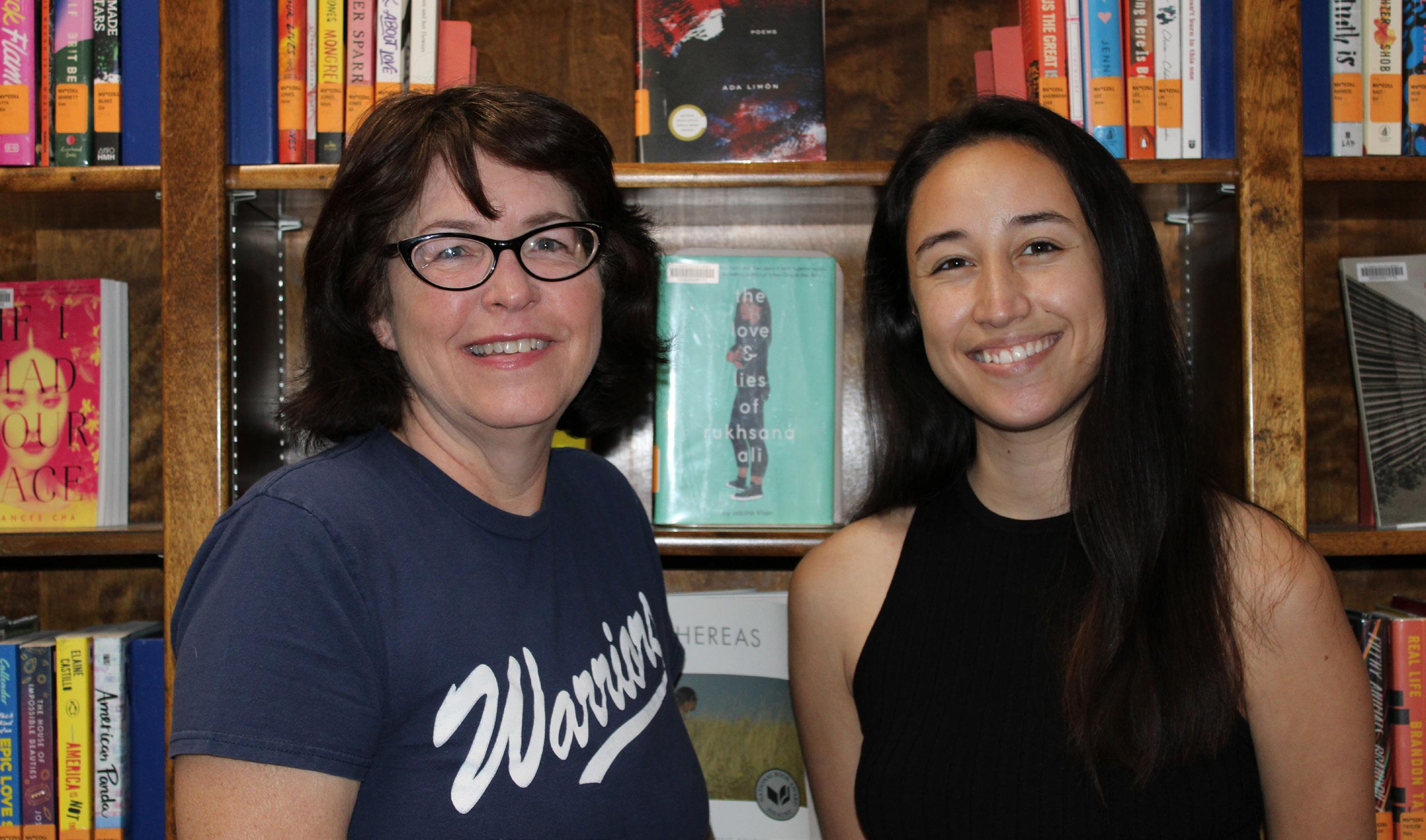
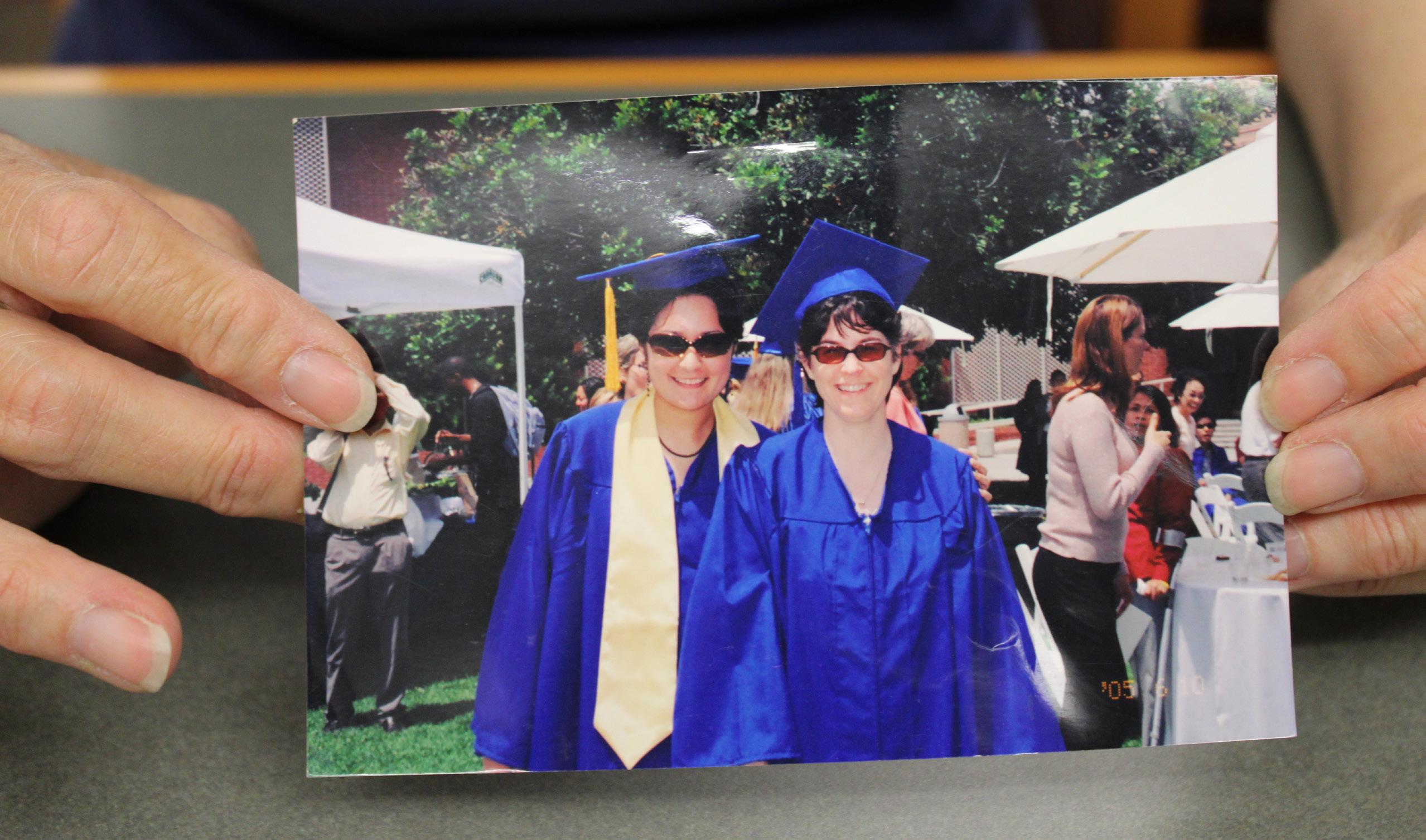 (Above) El Camino College Library and Learning Resources Specialist Laurie Pelayo (L) and daughter Alyse Pelayo meet up in the library on Thursday, April 7, 2022. Alyse, who attended ECC in 2019, works part time as a library and learning resources assistant in the ECC Music Commons,
(Below El Camino College Library and Learning Resources Specialist Laurie Pelayo (R) and daughter Lessa Pelayo-Lozada graduate from ECC in 2005. Lessa was recently elected president of the American Library Association. Her term starts in June. (Photo courtesy of Pelayo family)
(Above) El Camino College Library and Learning Resources Specialist Laurie Pelayo (L) and daughter Alyse Pelayo meet up in the library on Thursday, April 7, 2022. Alyse, who attended ECC in 2019, works part time as a library and learning resources assistant in the ECC Music Commons,
(Below El Camino College Library and Learning Resources Specialist Laurie Pelayo (R) and daughter Lessa Pelayo-Lozada graduate from ECC in 2005. Lessa was recently elected president of the American Library Association. Her term starts in June. (Photo courtesy of Pelayo family)
who were also accused, but cleared. The woman was one of the few that weren’t cleared.
“When you think about the fact that genealogy can take you to something so historical that you wouldn’t expect, genealogy is fascinating,” Laurie says.
But not all family members agreed. Some were willing to talk about family history, while others were not.
"My grandpa would tell you anything. It didn’t bother him in the least, but my grandmother was like a closed book," Laurie says.
Genealogy was also a topic that came up with her in-laws.
"My in-laws are (Native) Hawaiian and my father-in-law was a genealogist, so he and I kind of bonded," Laurie says.
Laurie’s love of history and passion for genealogy led her to volunteer some time to the South Bay Cities Genealogical Society, where she was a librarian, secretary and former president.
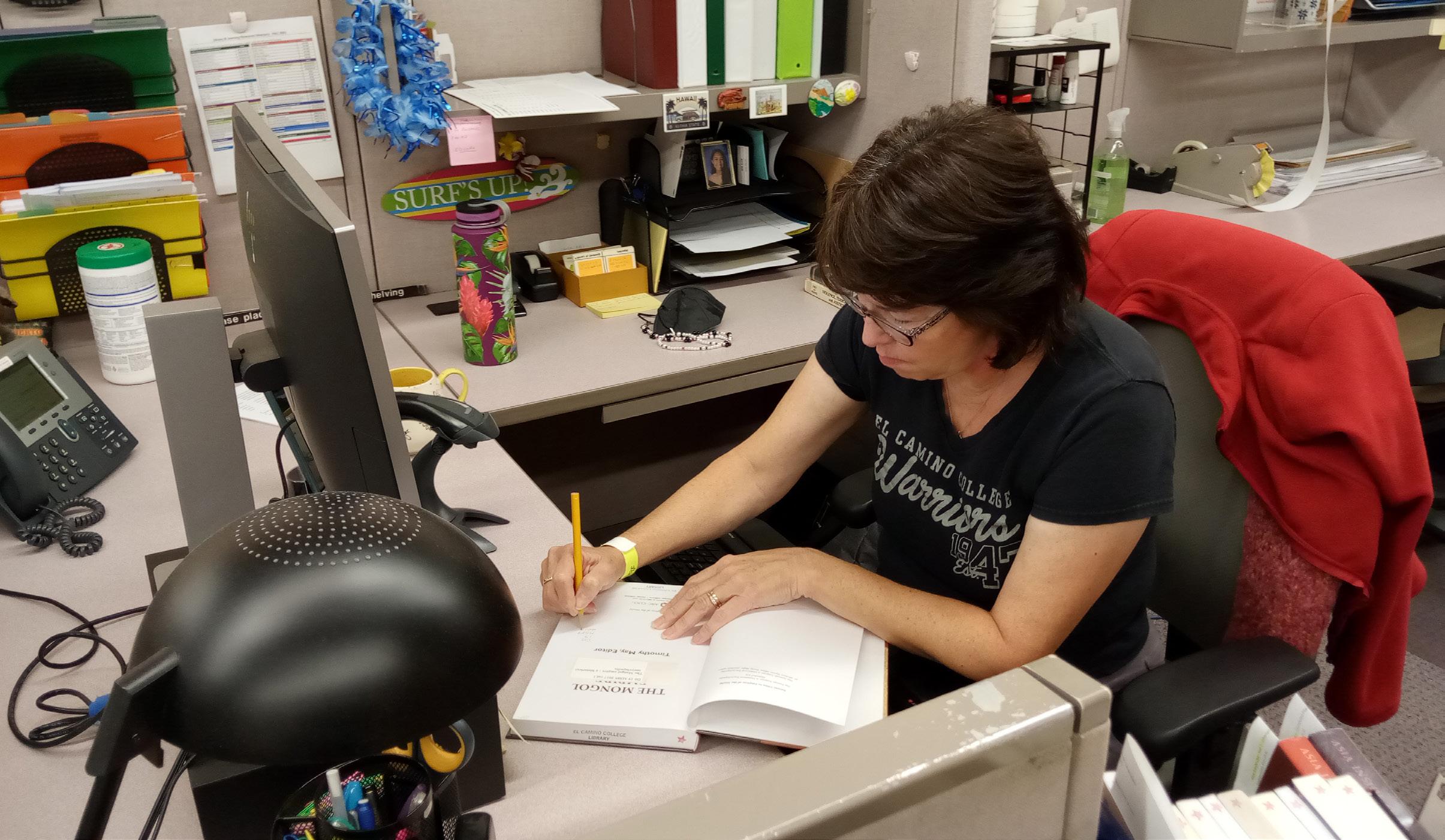
And, if her dedication to the library wasn’t enough, Laurie has authored “The Lydia Proctor Mystery” series, a series of five genealogical mystery books.

“Laurie has a very specialized job. She, as a cataloger, probably has the highest technical skill set of probably anybody in the whole building, and without Laurie we couldn’t have, as successfully, migrated from one library system to another, which we did just before COVID,” Crystle Martin, dean of library and learning resources, says.
Lorna Rice, associate director of the Torrance Family History Center says she is a big fan of Laurie's.
Throughout her time at ECC, the Genealogical Society and writing her books, libraries have been a constant. Friends would grow weary of learning where she was going on vacation.

“‘Oh, I’m going on vacation.’ ‘Oh, where?’ ‘The library at Salt Lake City.’ ‘Do you ever not go to a library?’ and I’d say, ‘Well, no, not really,’” Laurie says. “I can’t escape my rich history.”
El Camino College Dean of Library and Learning Resources Crystle Martin smiles in her office on Wednesday, April 27, 2022. Crystle is in her fourth year as dean at ECC.
El Camino College Library and Learning Resources Specialist Laurie Pelayo catalogs a book at her desk on Wednesday, Oct. 20, 2021, in ECC Schauerman Library. Laurie is in her 40th year of employment at ECC.A view of Lake Havasu City, Ariz., shows an empty beach and lake before the crowds arrived in summer 2021. The ideal conditions were not enough to keep a family trip from being ruined.

The disappointing aspect of my family vacation trip last summer still casts a shadow over the best moments I spent in Lake Havasu City, Arizona
Story and photo by Jesus CortezThis was to be the best summer in recent memory, but a look at our skin color from the locals made our trip take a turn for the worse.
What started off as a promising getaway from Los Angeles fulfilled its purpose as the first day saw us soak in the pool of the Airbnb we rented. It was like a home full of entertainment for people of any age and it was just what our family needed.
The next day, after getting ourselves ready for the lake, we headed to a nearby gas station to fuel up the boat. I entered to pay for the fuel and was second in line. There were no other customers in the store except for me and the man first in line.
The man in front of me thanked the cashier and was about to walk out until he saw me. He then took a few steps back to the cashier and threw a bag of chips on the counter to buy. While they scanned his item, he called his kids out of his truck and told them to get anything they wanted from the store.
“Take your time,” he said as they looked around the mart. He then proceeded to give me a dirty stare and spoke for a few minutes with the cashier, not bothering to move out of the way for me to pay for the gas. It was then that I realized this man had something against me.
I walked up to the cashier as the two spoke and slammed the cash on the counter, telling him what fuel pump it was for, then I headed back to the truck without saying a word.
We had already gotten dirty looks from a few people when we first arrived in this predominantly white city, but we thought nothing of it since we were visiting for a good time. After the situation at the gas station, however, I concluded that we were in for racist treatment from the locals.
My theory was put to the test, and it was confirmed when we found a nice two-sided beach area on the lake to settle down. While my dad went to launch the boat into the lake, we set up a canopy for shade in the sand and then jumped into the water a few feet away.
Just moments later, however, the white family that had set up
right next to us asked us in a rude tone to move farther away from them. We were not close enough to them to be bothersome, however, we decided to move out of their range because we did not need to be around problematic people like them.
About half an hour later, we started to hear the word “boo” in unison from the crowd and wondered what was going on. None of the boats that had passed received a negative reception from the crowd, but I knew immediately that the boat being taunted was being driven by my dad.
He finally reached us, and as he aided us in getting into the boat while wearing his straw hat, he smiled. “They do not like us,” he said. I looked around and we were surrounded by white faces of people who did not appreciate our visit, the only colored family around.
We had never been racially targeted to this extent, so it came as a shock to all of us. There was no way the color of our skin could garner this much negative attention. It must have been the culmination of hatred from a town seemingly devoid of diversity.
As we rode on in the boat, my fists were clenched with anger and never in my life did I want to give anyone a piece of my mind more than at that moment. I gave it a rest and thought for a second. I knew that giving in to anger would be just how they wanted us to react.
We headed back the way my dad came, and on both sides there were people sticking the middle fingers up with both hands. None of the other boats received this treatment, so we were all angered and even annoyed. My dad, however, kept his cool and did the most prideful thing I had seen in a situation like this.
He handed my brother the steering wheel, turned up the hip-hop music that was playing and started dancing in the face of hatred. The number of fingers we received increased, but that did not stop him.
As we rode on, I could not grasp the reason for racism or discrimination in the world. It lowered my morale for the rest of the trip, and I realized how small my world was back home.
All you need is a mic, music and a group of friends, family, and colleagues. If you’re a music lover, love to sing or just like to have fun with your peers, consider a karaoke spot near El Camino College’s campus. These are the top 5 establishments near El Camino.
Muse Karaoke is 8.5 miles and 18 minutes away from El Camino. The Muse has happy hour 50% off from 6 p.m.to 8 p.m.The last call for happy hour is 7 p.m. If you bring food it would be an additional charge of $1. Price is per room size, small (2-4) people $30 medium (5-9) people $40, and large 10-16 people.
Address: 1555 Sepulveda Blvd., Ste. T, Torrance Phone: 310-325-4408
Hours: Open daily: 6 p.m. to 2 a.m.
Website: https://www.yelp.com/biz/astro-karaoke-torrance
San Franciscan is well known for its famous clam chowder bread bowl and steak. The steakhouse restaurant/bar has karaoke on Tuesdays and Thursdays from 8 p.m. until close and live entertainment on Fridays 9 pm until 1am.They offer large group reservations of up to 16 guests. Karaoke is free as long as you buy a drink and food. Gifts cards and 4.6 miles from El Camino campus.
Address: 2520 Sepulveda Blvd., Torrance Phone: 310-325-5231
Hours: Monday-Thursday: 3-9 p.m. Friday-Saturday: 3-10 p.m.
Website: https://www.the-sanfranciscan.com/karaoke-and-livemusic/
Forever Music karaoke is(5 minutes away).This location has a nice sitting area with chairs and couches in the receptionist area. Prices are $20 an hour for room size two people, five people for medium rooms $25 an hour and 17 people in large rooms for $40 an hour.
Address: 15208 S Western Ave., Gardena Phone: 310 324-7770
Hours: Open daily: 6 p.m. to 2 a.m.
Website: https://www.yelp.com/biz/forever-music-studiogardena
Near the entrance, there are six rooms, a bar, and three archery arcade games.Visitors can take advantage of great bargains and low pricing at this place.This place is 1.3 miles from campus and the arrival time is 5 minutes away. The rooms are open for walkins and reservations. Prices range from $20 to $50 depending on the size of the group.
Address: 2212 Artesia Blvd., Torrance
Phone: 310-329-9006
Hours: Tuesday-Sunday: 7 p.m. to 2 a.m.
Social media: FB: https://www.facebook.com/ASTROkaraoke2/
Artesia Bar is a 21 and over LBGQT bar in Redondo Beach with free karaoke on Sundays, Tuesdays, and Thursday at 8 p.m. as long as you purchase a drink. DJs on Fridays and Saturdays at 10 p.m.They have themed events,trivia nights, birthday bashes, outdoor seating, and reservations are required for groups. The arrival time is 12 minutes and 3.2 miles from El Camino’s campus.
Address: 1995 Artesia Blvd., Redondo Beach
Phone: 310-318-3339
Hours: Sunday, Tuesday-Thursday: 7 p.m. to 2 a.m. Friday-Saturday: 6 p.m. to 2 a.m.
Website: https://www.artesiabar.com
Social Media: FB: https://www.facebook.com/ArtesiaBar-2398733403674606/
IG https: //instagram.com/artesiabar?igshid=NjY2NjE5MzQ=
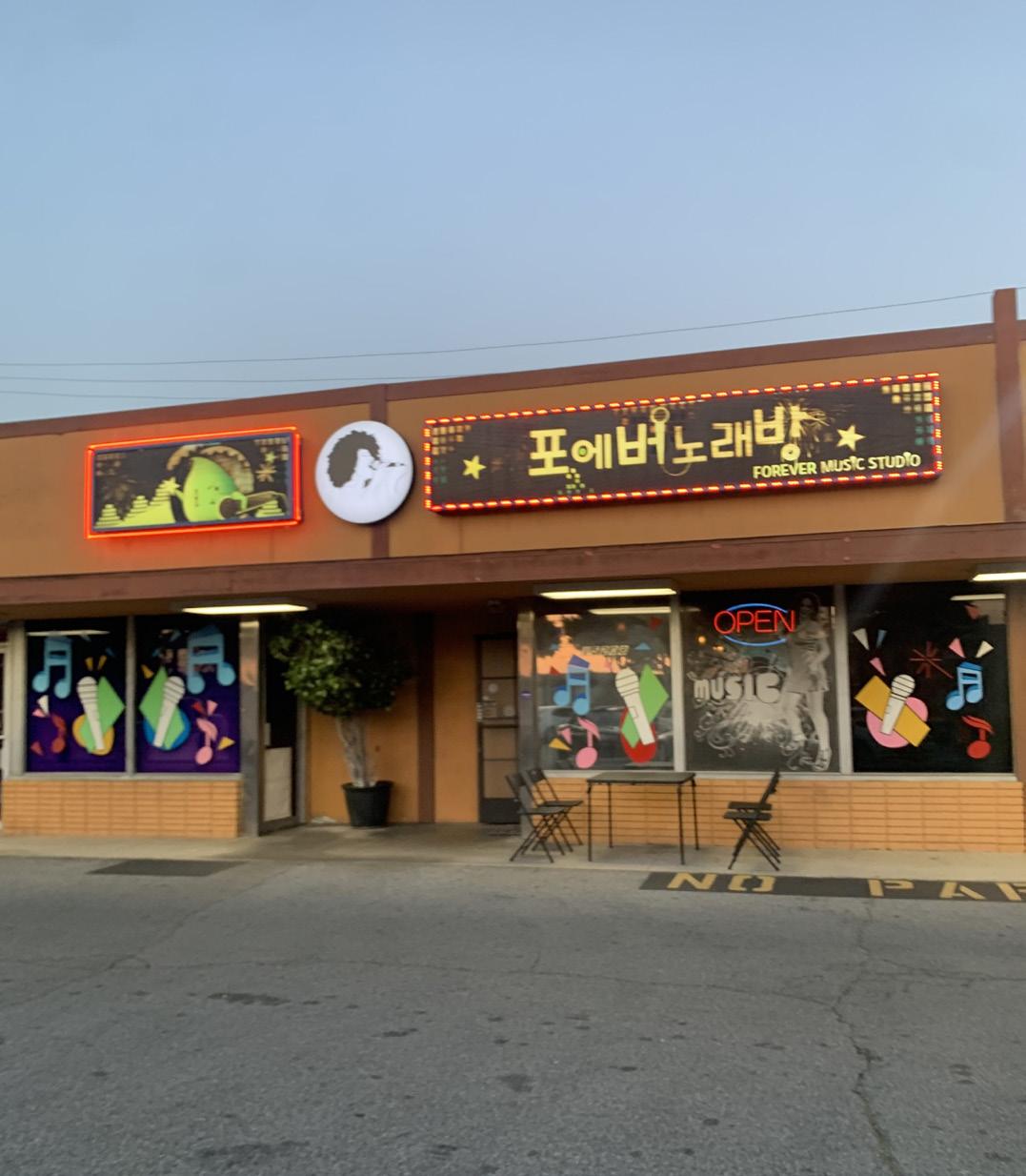
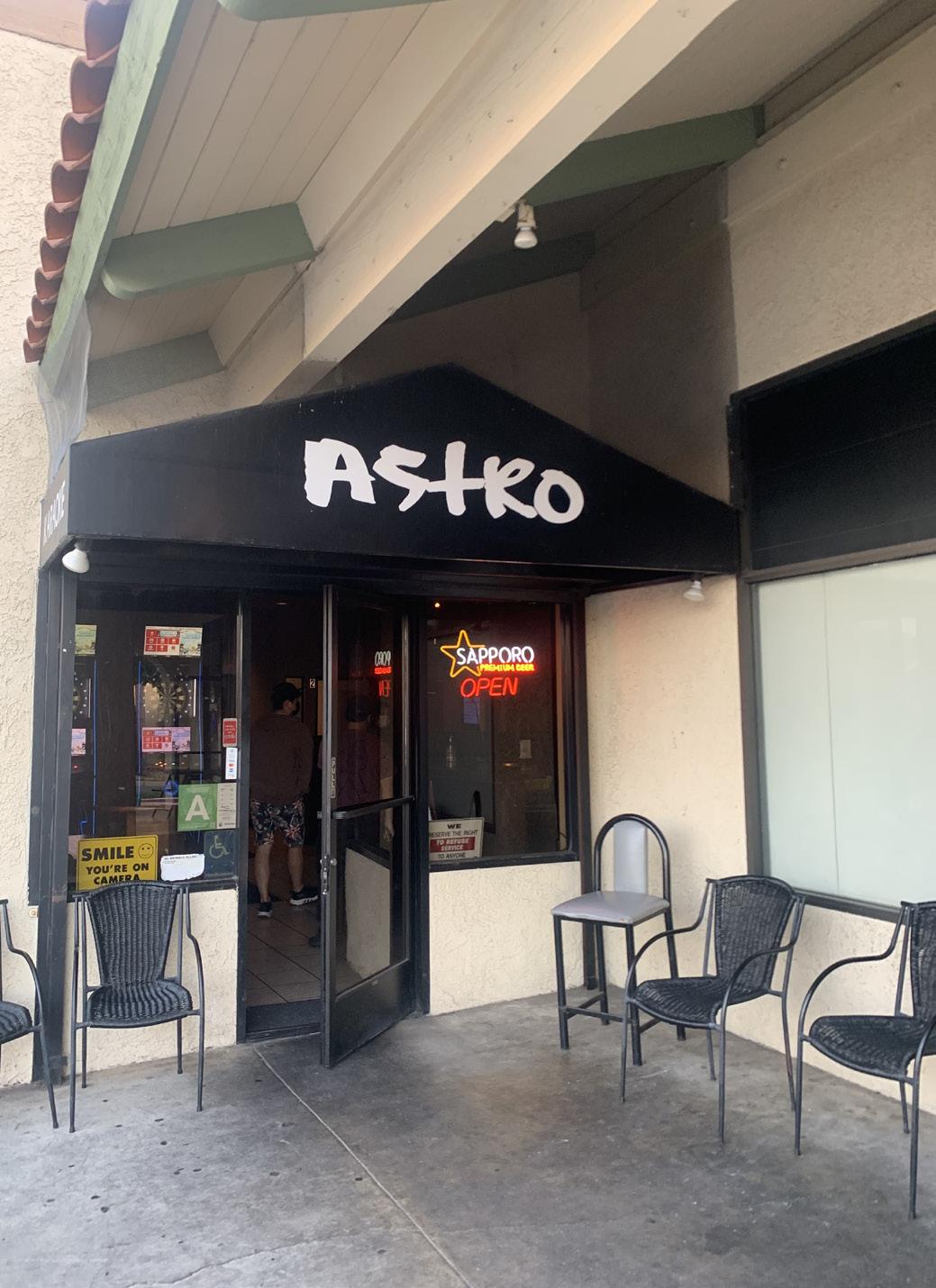


Marcus Rodriguez stands in front of Offering III, an archival pigment print by artist Matt Lipps. Marcus curated the art gallery "Closer Now" in Torrance Art Museum that ran from April 2 to May 14. (Maureen Linzaga | Warrior Life)
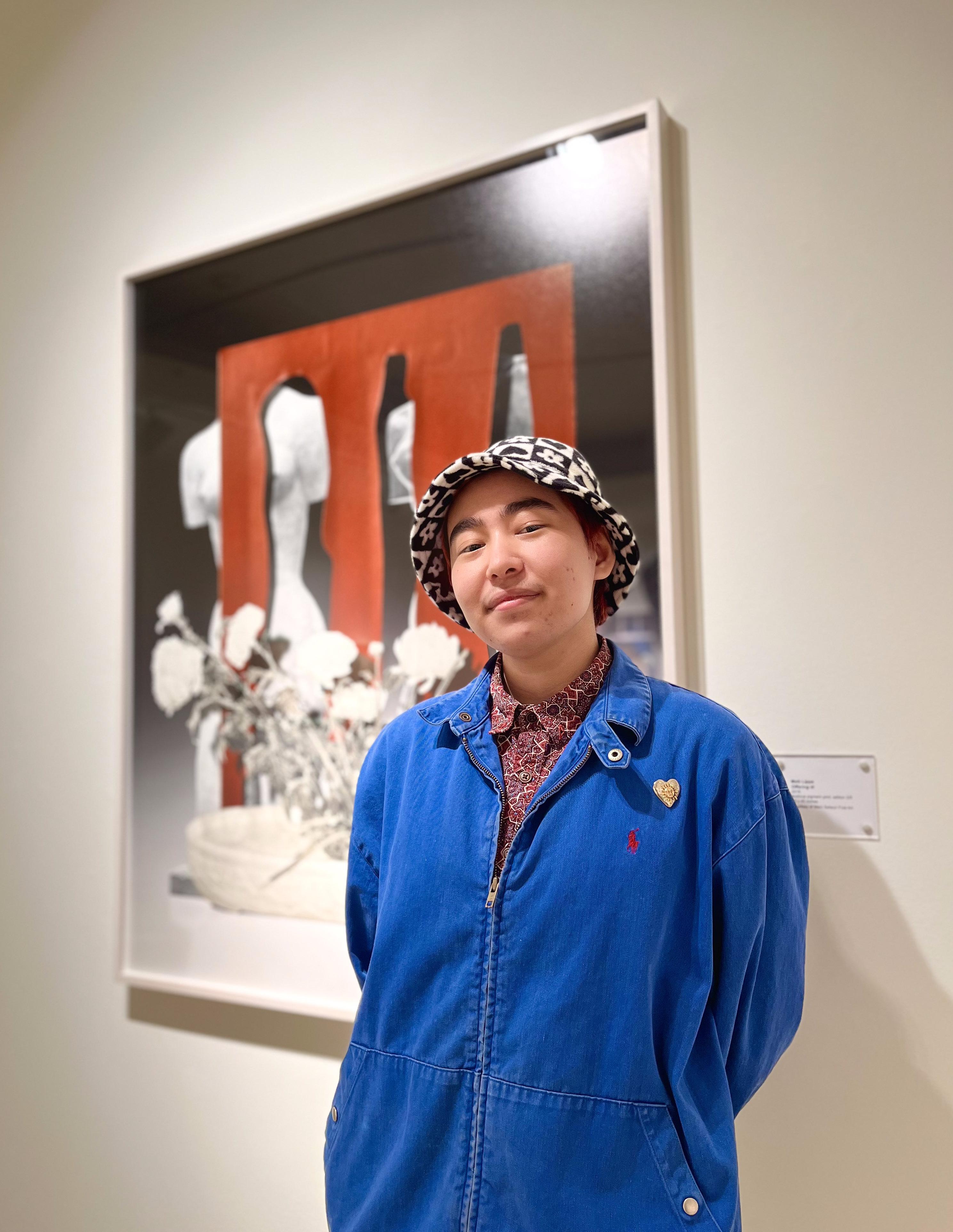

His journey in art began in the first space he occupied – his own home.
The ceramic mug that holds his coffee. The textiles of the plastic cover draped over the dinner table. The engraved kitchen tiles. The religious images such as the Crucifix on the walls. The sculptures of the Virgin Mary adorning the altar.
Even from simple objects one can make practical use out of every day, Marcus saw works of art in his Mexican household at an early age.
“Those are pretty to look at, but they're also things that you wrap yourself around and feel comfort with,” Marcus says. “My hope, my vision is that kind of art could bring comfort and solace to the human experience.”
Through the emphasis of cultural identity and individual belonging in art, El Camino College studio art and psychology student Marcus Masaki Rodriguez tells stories of domesticity across many spaces – whether in a classroom, the museum or his own abode.
Born in Los Angeles to a Japanese mother and Mexican father, Marcus spent a lot of his life navigating two cultures and seeing how concepts of intimacy and domestic life differ from home to home.
“Growing up like that, the idea really stuck with me, like how do we find a home? And what constitutes as a home?” Marcus says.
Outside his biological family, he found a deeper sense of belonging in a “found family” as a queer individual. Valuing domesticity and vulnerability through his experiences, such themes ultimately inspired the art gallery Marcus later curated for the Torrance Art Museum.
“Cultivating a space where you can be yourself and be vulnerable with people around you - that’s an important idea to me,” Marcus says.
His parents met in a cosmetology school in Hollywood, where
both studied creative careers such as movie production and doing actors’ makeup. This exposed him to the world of aesthetics and creativity at a young age.
Marcus’ dad is now a writer of children’s books who creates detailed pen-and-ink illustrations of creatures in the fantasy stories, which further encouraged Marcus’ imagination as a child.
“I think my art style’s very, very different,” Marcus says. “But I definitely have that same love for the arts and the same artistic eye.”
His mother no longer pursues the arts and is now working as a social worker among the Asian homeless population in Downtown Los Angeles.
Like her, Marcus felt a strong fondness for his Asian roots.
Marcus recalls sitting in the backyard of his grandparents’ house in Osaka, Japan, letting his curiosity run free by making ‘plant soup’ or makeshift tea by cutting grass, putting in water and telling his mom to eat it.
“Although obviously she wouldn’t,” Marcus adds with a laugh. “I was always curious, always enjoyed beauty, I found a lot of value and comfort in aesthetic practices.”
Marcus spent most summers visiting his Osaka home, observing Japan’s culture of communally living with extended family and relatives.
“In Japan, there’s such a big emphasis on the collective and working with other people. In America, my experience has been very individual, it’s a very ‘Man for himself’ kind of idea,” Marcus says. Marcus says the biggest similarities in both his Japanese and Mexican homes are the environments where a lot of people lived closely, allowing him to spend time with many generations of different cultures.
Marcus moved from his Mexican household at 13 years old to now live with his mom and brother in Torrance, which he finds more suitable as an adult who values independence. His dad currently lives in another area of California for work.
“As an introvert, I didn't really like it. I really liked my own space. I think I much prefer this environment that I'm in now ... I have much more freedom and control,” Marcus says.
Occupying an even broader space in his art career at 21 years old, Marcus curated his first art show “Closer Now: Intimacy in a Rehabilitating Society” which was available to be viewed for free in Torrance Art Museum (TAM) from April 2 to May 14.
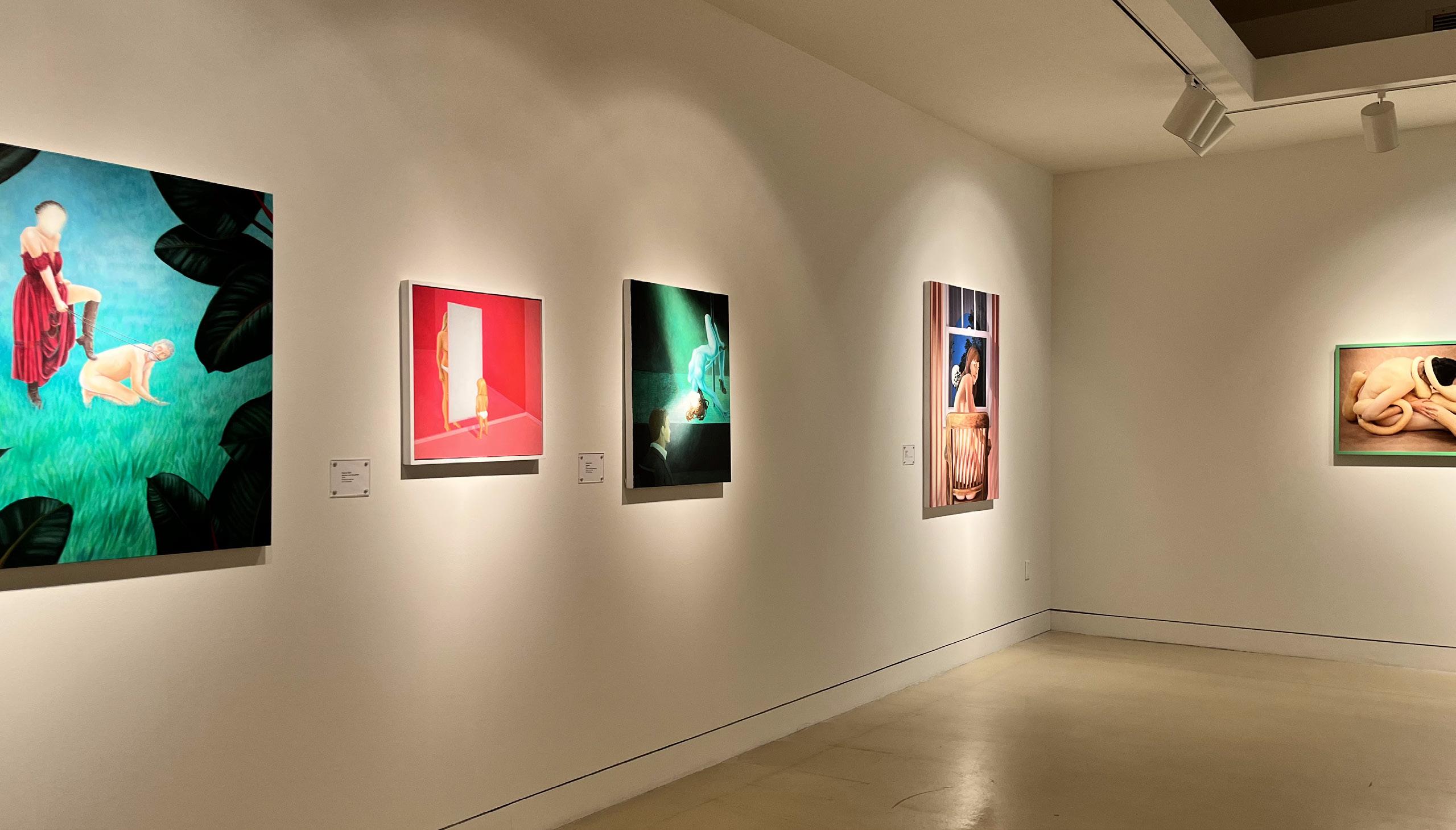
With zest as bright as the artwork mounted to the four walls surrounding Marcus, his irises of deep mahogany roam over the colorful textures of Phyllis and Aristotle’s story as told through acrylic paint.
“Closer Now” featured artwork surrounding themes of intimacy, gender dynamics and domestic relationships, especially in regard to the COVID lockdowns that have altered many relationships whether public, private, or even with the self.
“I know at least from my experience, [COVID] drove me and my family a little crazy,” Marcus says, a smile apparent behind his face mask. “As we're living in close proximity, we have this very personal idea of what it means to relate to others, and how that kind of helps us learn about ourselves in the process.”
Marcus says the painting by Palmer Earl of Phyllis and Aristotle is his personal favorite artwork in the gallery, as it shows a unique relationship that challenges gender dynamics and the woman is seen as more dominant.
Ryan Schude, a 43-year-old photographer from Chicago whose work was also featured in the show, highlighted similar themes of vulnerability and gender dynamics in relationships. One of the photographs entitled “Kitchen” captures him and his wife portraying a couple arguing over the dinner table.
“I think it’s an amazing opportunity for [Marcus] to have, to be able to get that well-established of an institution to curate a show at that age,” Ryan said. “Being the age the I am, I was pleased to have any sort of connection with a whole different generation that I generally don’t have chances to work with except for shoots.”
In June 2021, Marcus received a Getty Marrow Undergraduate Internship to work at TAM, the first grand opportunity that made his curation possible.
Selene Preciado, program associate at the Getty Foundation, says the internship is one of many efforts made to make museum staff reflect the demographics of Los Angeles and address the lack of diversity in more prestigious institutions like Getty.
In the Getty Marrow Undergraduate Internship, interns such as Marcus gain a stipend of $6,400 for a consecutive 10-week work period between June to August for around 120 interns annually.
The foundation will celebrate 30 years this summer, as its genesis was marked by a historical period of Los Angeles riots following the beating of Rodney King.
“The region was serving in upheaval. Many cultural institutions,
Gallery 2 of the Torrance Art Museum is holds the "Closer Now" gallery curated by Marcus Rodriguez and TAM staff. From left to right: "Phyllis and Aristotle", "Mother and Daughter" and "Salome" by Palmer Earl, "Starling" by Laura Krifka, "Untitled" by Heather Rassmussen. (Maureen Linzaga | Warrior Life)"As we're living in close proximity, we have this very personal idea of what it means to relate to others, and how that kind of helps us learn about ourselves in the process."
- Marcus Rodriguez studio art and psychology student
including the Getty, had conversations about how to help our community in different ways,” Selene says. “One of the ways was to open the museum doors.”
As an artist with different backgrounds and identities, Marcus applied after being drawn by the program’s emphasis on diversity.
“Walking into a museum as a young man of color, as someone with a queer identity, it’s hard to either feel like I can relate or feel a sense of belonging in the space,” Marcus says.
Numerous alumni of the internship program now work at similar institutions such as Cameron Shaw, director of the California African American Museum.
“Obviously, an internship is not going to solve systematic issues, because field-wide, the arts are very much like an elite sort of field, but the internship is sort of like the catapult that helps them get started” Selene says.
Selene also resides in Torrance and has years of curatorial experience. Being of Hispanic heritage herself, Selene says she sees herself in Marcus and the young professionals starting their art careers.
“I read like over 100 resumes and I'm just blown away by the brilliance of everyone every year and it is very humbling,” Selene says. “As a professional of color, by offering my experiences and my struggles and my successes in the arts, I also hope to help younger generations.”
At the beginning of the internship process, Marcus recalls being in a Zoom meeting with around 120 other interns and being one of the only community college students.
“Most of them were like, ‘Oh, yeah, I just got my bachelor's from UCLA and went to Stanford.’” Marcus says, eyes wide in disbelief as he reminisces. “I was like ‘Oh my god, like what am I doing here?’”
Selene agrees, and says that the Getty Internship program is not only competitive for the students, but also for the organizations because organizations go through extensive review processes.
As part of the internship that lasted from June to August of 2021, Marcus was asked to create a hypothetical exhibition.
Max Presneill, a Los Angeles-based artist from the United Kingdom and director of TAM for 13 years, was so impressed with Marcus’ gallery proposal that the museum pushed to bring the exhibit to life.
The experience was TAM’s first time ever offering the chance to curate to an intern. With the help of the museum curators and staff, Marcus was aided in the process of putting the pieces together.

“I think what he's done a good job here, he's looked into intimacy in an off-kilter way that makes us reassess what we might mean by ‘intimacy’ – such as what does it mean in a pandemic? And what does it mean to us individually,” Max says.
Max says that the key characteristics that they saw in Marcus when interviewing interns for the museum is that he was responsible, can get the job done and was a self-starter. What also impressed Max from the beginning is that Marcus asked very “intelligent, pertinent” questions.
“No offense to young people, but that isn’t that common,” Max says. “There's a lot of questions from people that’s like ‘Really? Is that all you’re gonna ask me when you have the opportunity?’”
In the internship, Marcus had roles of volunteer orientation training, directly examining art pieces to see if any were damaged along the shipping process or as they are exported back out, doing research on artists and galleries, writing articles and conditioning reports and even promotional aspects through updating the museum’s website and social media.
Going up and down a five-story building in August 2021, Marcus
Marcus Rodriguez stands at the "Closer Now" exhibit entrance at the Torrance Art Museum on April 14. Marcus curated the show with the help of Torrance Art Museum staff which could be viewed for free from April 2 to May 14. (Greg Fontanilla | Warrior Life)
 Marcus Rodriguez evaluates the perspective drawings created by students of a drawing class taught by art professor Joseph Hardesty. Student drawings line the walls of Room ARTB207 in the El Camino College Art Building on May 2. (Maureen Linzaga | Warrior Life)
Using a ruler guideline for a perspective drawing, Marcus Rodriguez aids student Maria Garibay in her class project. Marcus is the teaching assistant for art professor Joseph Hardesty in the drawing classes held in Room ARTB207 in the El Camino College Art Building on May 2. (Maureen Linzaga | Warrior Life)
Marcus Rodriguez evaluates the perspective drawings created by students of a drawing class taught by art professor Joseph Hardesty. Student drawings line the walls of Room ARTB207 in the El Camino College Art Building on May 2. (Maureen Linzaga | Warrior Life)
Using a ruler guideline for a perspective drawing, Marcus Rodriguez aids student Maria Garibay in her class project. Marcus is the teaching assistant for art professor Joseph Hardesty in the drawing classes held in Room ARTB207 in the El Camino College Art Building on May 2. (Maureen Linzaga | Warrior Life)
also did these tasks in the pop-up show “Nomad”, which featured around 500 contemporary artists at Del Amo Crossing Medical Center Building.
A week after the “Closer Now” opening night, although his 2021 internship was over, Marcus took a group of disabled individuals from the city-based non-profit organization Diverse Journeys on a tour around the gallery.
Marcus, however, originally did not want to pursue art when he went to college. After graduating from high school, he went to El Camino with hopes of pursuing a psychology degree.
After taking his first-ever drawing class, he felt supported in the beginning of his art journey and decided to pursue a studio art major.
Marcus was set to transfer in fall 2021 after getting his art certificate, but COVID decreased studio art classes he could take. He instead took the chance to continue his psychology certificate at El Camino to be finished in June 2022.
“Art and psychology are definitely still related because at the end, my root purpose, desire or drive is to understand people,” Marcus says. “Art, music, dance, literature, anything like that can directly speak to how we interact with the world on an emotional basis.”
As Marcus pursues both art and psychology degrees, many encouraged him to go into art therapy as it is a helpful tool for dealing with mental health through creativity. But Marcus says he wants to pursue each area separately.
Ultimately, one of his main goals is to be an art educator. Now, Marcus is gaining mentorship experience as a teacher's assistant for El Camino art professor Joseph Hardesty in the very same intro to art class he was in.

And yet again, he occupies another space, this time the very
classroom that deepened his love for art.
Joseph says he was teaching beginning drawing when Marcus voluntarily gave his time, suddenly started showing up early and staying after classes to help.
“I’ve always got way too much crap to do,” Joseph laughs. “I needed a TA and he was so helpful and so amazing … so he started working for me as a TA before the pandemic.”
Marcus eventually became part of MyPath, a program in El Camino College that Joseph says essentially attaches the course to a counselor and a student who's already taken the class. Marcus serves as a tutor and helped students in their art projects, navigating campus and much more. He then became the vice president of the Future Teachers Club comprised of El Camino students pursuing education fields.
Marcus says Joseph, through MyPath and his mentorship, was one of the reasons why Marcus felt supported in his journey as an art educator. He was even the first to let Marcus know about the Getty internship during winter 2021.
“Marcus is so hard working, so talented and smart and all that stuff, but none of that would mean anything if he wasn't willing to put himself out there. That would be my advice to students,” Joseph says. “Even if you don't get it, you learn something from the process and you're more prepared for the next opportunity.”
Marcus certainly took another opportunity. He had the honor of receiving the Getty Undergraduate Internship once again to work at the Museum of Latin American Art (MOLAA) at Long Beach in summer 2022.
Being assigned to a museum focusing on Hispanic artistic works this time around, Marcus aims to learn more about his culture and Mexican descent, carving more of his identity into yet another space.
“I remember [MOLAA] has galleries with religious iconography because Catholicism is like a big part of [Hispanic] culture too,” Marcus says. “It's going to be interesting seeing how not only I relate to the works that we're going to be showing, but also what kind of works that I'm going to be specifically drawn to. I'm excited to explore that as well.”
Marcus hopes to continue employing spaces that value belonging and creative expression to motivate his future students into doing the same in the process.
“That idea of comfort really feeds into the greater sense of intimacy and an environment where you're able to just be yourself without worrying about how you're being perceived,” Marcus says. “Because you're like, ‘With these artworks in the background, and visual items I find beauty in? Oh yeah, this is my space.’”
"Art, music, dance, literature, anything like that can directly speak to how we interact with the world on an emotional basis."
- Marcus Rodriguez studio art and psychology studentMarcus Rodriguez stands with art professor Joseph Hardesty in his office at the El Camino College Art Building on May 2. Marcus is the teaching assistant for Joseph's drawing classes. (Maureen Linzaga | Warrior Life)
Whether you’re vegetarian, vegan, or just want to try something new, it’s nice to have options. Warrior Life has created a list featuring the top 5 vegan restaurants in the South Bay. From Pad Thai to the classic California roll, you can enjoy these and more with plant-based options. The possibilities are endless and these local spots will leave you satisfiedThe possibilities are endless and these local spots will leave you satisfied and wanting more.

Specializing in Vietnamese cuisine, Happy Veggie prides itself on using only the freshest ingredients while being high in protein and heart-healthy. Dishes are around $10 each and offer many colorful entrees. Try the heavenly salad and eggplant tofu.
709 N. Pacific Coast Hwy Redondo Beach, 310-379-5035
A walkable distance from Manhattan Beach’s shoreline, Rice is a vegan-friendly spot that offers its twist on the classic sushi roll. Their Green Wave Roll ($18) consists of sliced avocado and sweet soy sauce. Save some room for dessert to enjoy their layered green tea cake ($11) or double chocolate cake ($11) (vegan and glutenfree).
820 Manhattan Ave. Ste 105 Manhattan Beach, 310-798-7722, ricemb.com
Green Temple is a hidden gem. They have been a staple in the community for more than 20 years and get most of their produce from local farms. Try their super veggie burger with walnut bread ($14) or their veggie quesadilla ($11).
1700 S. Catalina Ave Redondo Beach 90277, 310-944-4525, greentemple.net
This tiny spot is a great take-out option that serves 100% vegan Thai dishes. A majority of their menu stays under $15 and offers significant portion sizes that you can enjoy for leftovers. You can’t go wrong with a classic pad thai ($12.50) or try their green curry ($14.50) and basil fried rice ($13.50).
3255 W. Rosecrans Ave. Hawthorne 90250, 424-374-8317
Established in 1977, The Spot is one of the oldest vegan/vegetarian restaurants in Los Angeles. The Spot is one block away from the Hermosa Beach Pier and was awarded one of South Bay’s Best of 2013 in the Daily Breeze. The must-try item is their awardwinning Spot veggie burger and savory sauce ($8.95).
110 Second St. Hermosa Beach 90254, 310-376-2355, worldfamousspot.com
 Vegan Nova’s popular menu items, feature vegetable tempura and Panang curry in Hawthorne, CA on May 22, 2022.
Vegan Nova’s popular menu items, feature vegetable tempura and Panang curry in Hawthorne, CA on May 22, 2022.
 Joanna Medawar Nachef is the first female conductor of the Middle East. The Palos Verdes resident has been the director of choral activities at El Camino College since 1996. A native of Lebanon, she and her family immigrated to the United States in 1975.
Joanna Medawar Nachef is the first female conductor of the Middle East. The Palos Verdes resident has been the director of choral activities at El Camino College since 1996. A native of Lebanon, she and her family immigrated to the United States in 1975.
 Story and photos by Gary Kohatsu
Story and photos by Gary Kohatsu
She has a “performance” before noon and her preparation starts with a choice of shoes — understandable, since she has an admitted shoe fetish.
Her footwear today will be a pair of red Longchamps pumps, open-toed, with ankle straps and thick soles.
“Everything begins with the shoes. It’s how I match my wardrobe,” she says. “I’m vertically challenged, so I like heels. The soles are thick for comfort, because I’m on my feet so much.”
Joanna Medawar Nachef cuts no corners when it comes to purchasing gorgeous, quality shoes. As a child in Beirut, her feet were “crooked and flat.”
“From ages 5 to 13, I had to wear [Dr. Scholl’s] boots with arches,” Joanna says. “I wore pretty dresses with those ugly boots. I never saw pretty shoes on my feet and I think now, I have gone the other way.”
In recent years, shoes with thick soles for comfort and sturdiness have become as important to her as style.
For Joanna, 63, her shoes, wardrobe and makeup are synonymous with a beautiful presentation.
“I never leave the house without (black) eyeliner,” Joanna says. “The Lebanese have significant, expressive eyes. They are the windows to my soul.”
She also never goes anywhere without cherry-red lipstick by Chanel (Long Wearing) — her preferred shade and brand.
Bright colors, like music, can lift the human spirit, she says.
Joanna is preparing for her Thursday choral class at El Camino College, where she teaches full-time, four days a week.
“When I step into the classroom, I give a performance,” Joanna says. “My motto is ‘life is a performance, not a rehearsal.’ Today I’m going to give my best effort. I believe in presenting and
expecting excellence, (although) not perfection.”
For Joanna, ECC’s director of choral activities, it’s a typical morning. A native of Lebanon, she immigrated to this country at 17 and now at 63, is a professional musician and conductor who has performed with chorus groups and orchestras in seven countries.
As a self-appointed “ambassador of harmony,” she believes God has blessed her with the gift of music to help unite people and cultures.
“My responsibility is huge because I want to dissolve these misconceptions that people from the Middle East are terrorists. We are not,” Joanna says. “It may be extremists, governments (that are to blame). People are not like that. Music is the universal language and the best tool to unite us all.”
A devout Christian, Joanna is a member of the Peninsula Community Church in Palos Verdes, where she served as minister of music from 1980 to 1997 and then as choir director from ‘97 to the present.
Her journey is inspired by the Bible, but fueled by a passion for fashion.
“I come (to concerts) in beautiful outfits,” Joanna says. “Because vibrant colors give the audience something to visualize and enjoy. And why not? It’s extravagant, yes. But I want my audiences to experience it all.”
At 5 feet, 2 inches high, Joanna says she might appear taller because she stands straight.
“Erect posture is crucial,” Joanna says. “I teach that and I live that. (Good posture) gives our breathing mechanism a chance to work naturally.”
Correct posture was instilled in her as a youth.
“My grandmother, who had excellent posture, had a good friend with osteoporosis,” Joanna says. “She would say to me, ‘(Yuwanna), don’t sit like her. Sit like me.’ And I have never forgotten that. (Good posture) is the key to singing and playing (instruments) accurately.”
Having developed an eye for spectacular wardrobes has brought out both her personality and confidence as a performer.
In 1989, she became the first female conductor of the Middle East when she conducted the Pacific Symphony Orchestra at the
Joanna Nachef has recently assumed the teaching duties of the El Camino orchestra, which meets in Marsee Auditorium. With a return to in-person activities, the orchestra performed a holiday-themed musical at ECC in 2021.
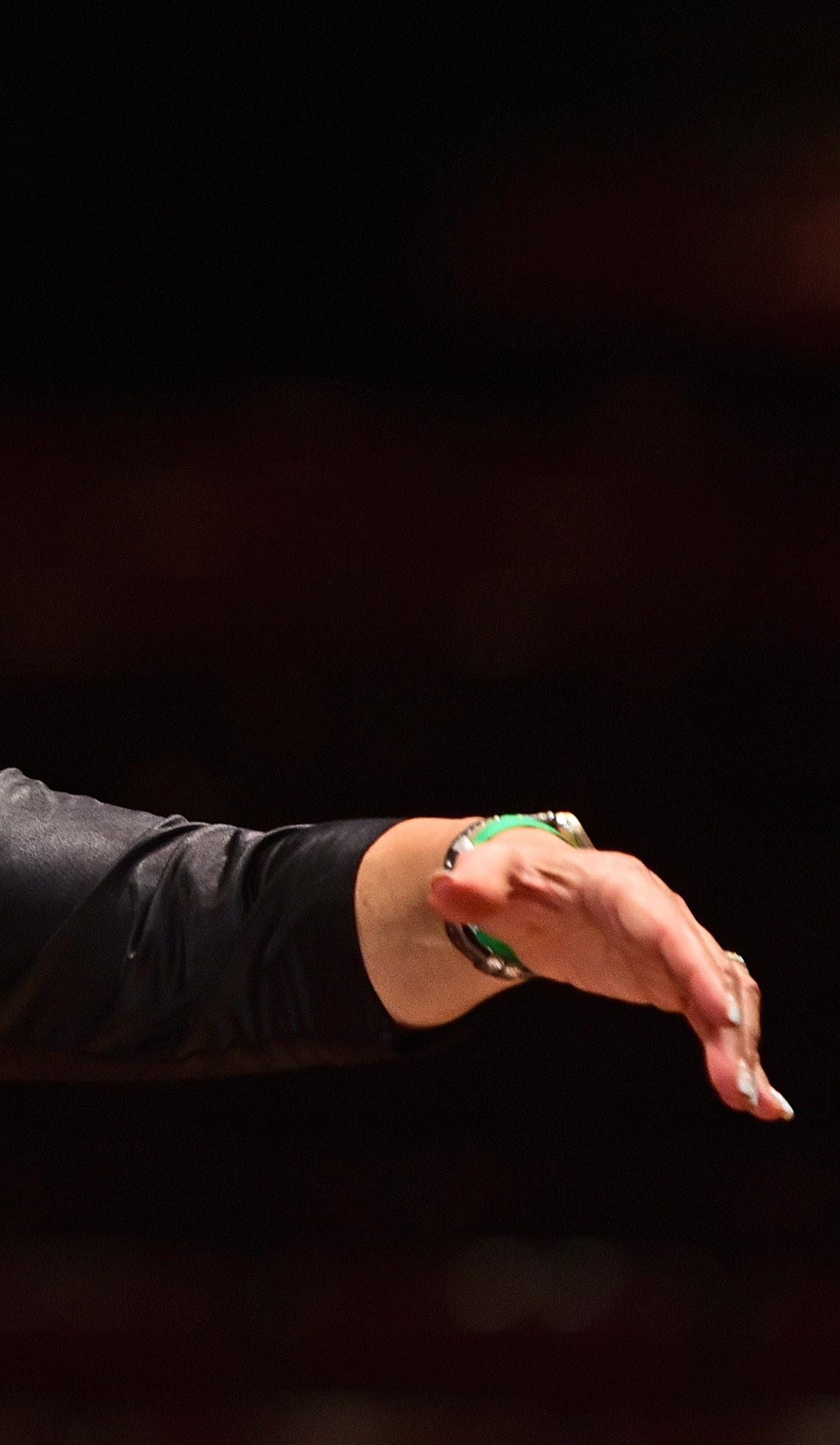
“
My responsibility is huge because I want to dissolve these misconceptions that people from the Middle East are terrorists. We are not... music is the universal lan guage and the best tool to unite us all.— Joanna Nachef
Above, a student makes changes to her music sheet in preparation for a holiday concert at Marsee Auditorium.
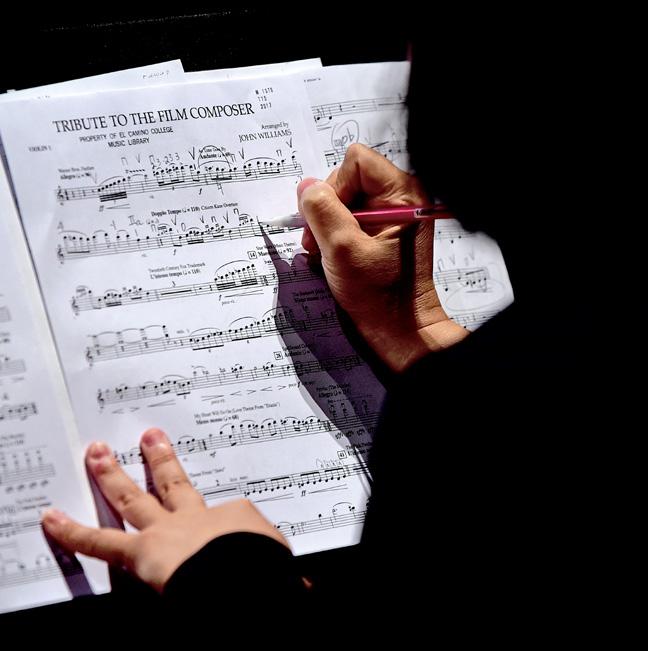
At left, Joanna Nachef conducts her Tuesday night orchestra class with focus and energy. The orchestra class was preparing for a holiday concert in December 2021, after a year of no live performances due to the coronavirus.
Orange County Performing Arts Center (Segerstrom Performing Arts). The occasion was a performance for the 500 Club LebaneseAmerican Organization.
Since that historical concert, several other Middle Eastern women have joined her as professional conductors, she says.
Born in Beirut, Lebanon, Joanna is the second oldest of four children to parents Michel and Yolla Medawar. She and her family fled Lebanon in 1976, during the early stages of Lebanon’s civil war. They traveled to America and settled with relatives in Los Angeles’ South Bay.
Joanna enrolled at El Camino College in Torrance to study music with instructor Jane Hardester. But in 1977, Michel and his family returned to their beloved home country in hopes that the war was subsiding.
Jane, who was the college’s choral director, thought about the young Lebanese girl with big dreams of conducting an orchestra. She dashed a letter to Joanna in Beirut.
“So what are you doing about your conducting?” Jane wrote.
The war in Lebanon was escalating and Michel Medawar, a third-generation jeweler-clockmaker, chose to remain politically neutral which was not viewed favorably by Lebanese authorities. For their security, the Medawars left their homeland for good in 1977 and settled in Palos Verdes, California.
Joanna was happy to return to ECC and complete her lessons.
After studying music conducting with Jane, Joanna earned her bachelor’s degree in piano performance at California State University, Dominguez Hills. She credits both Jane and Frances Steiner at CSUDH for being major influences on her career.
At 22, Joanna continued her education at the University of Southern California. She earned her Doctor of Musical Arts and Master in Music degrees in choral music
She started as a part-time music instructor at ECC in 1989 and
was hired as a full-time director of choral activities in 1996.
Her honors have been abundant over the decades. She was selected as one of the Outstanding Young Women of America in 1986, one of 1996’s Who’s Who Among America’s Teachers, 2008 Who’s Who Among America’s Women and 2010 Who’s Who in the World.
In 2014, she received ECC’s Distinguished Faculty Award.
She retired as artistic director of Los Cancioneros Master Chorale in 2015, after 24 years. In 2017 she started the Joanna Medawar Nachef Singers (comprised of many former ECC singers) and in 2018, was chosen to revive the defunct Torrance Pops Orchestra.
Joanna has maintained a consistent physical appearance, blending fashion and comfort with professionalism for much of the last 30 years.
She has worn her natural “blue-black hair” in a style she describes as a “half-do, off the shoulders.” Her hairstylist since 1999 is Zouhair Itani, a friend she met in America more than 40 years ago.
Zouhair also fled with his family from war-ravaged Lebanon in the mid-1970s. By chance, he studied cosmetology at EC before turning professional.
Toni & Zouhair Salon in Redondo Beach has been owned by the Itani brothers since 1979. Their shop is a quick jaunt from the Nachef home, Joanna says with a smile.
When conducting music on a stage, Joanna says she wants to be seen, admired and respected for her femininity, as much as her conducting prowess.
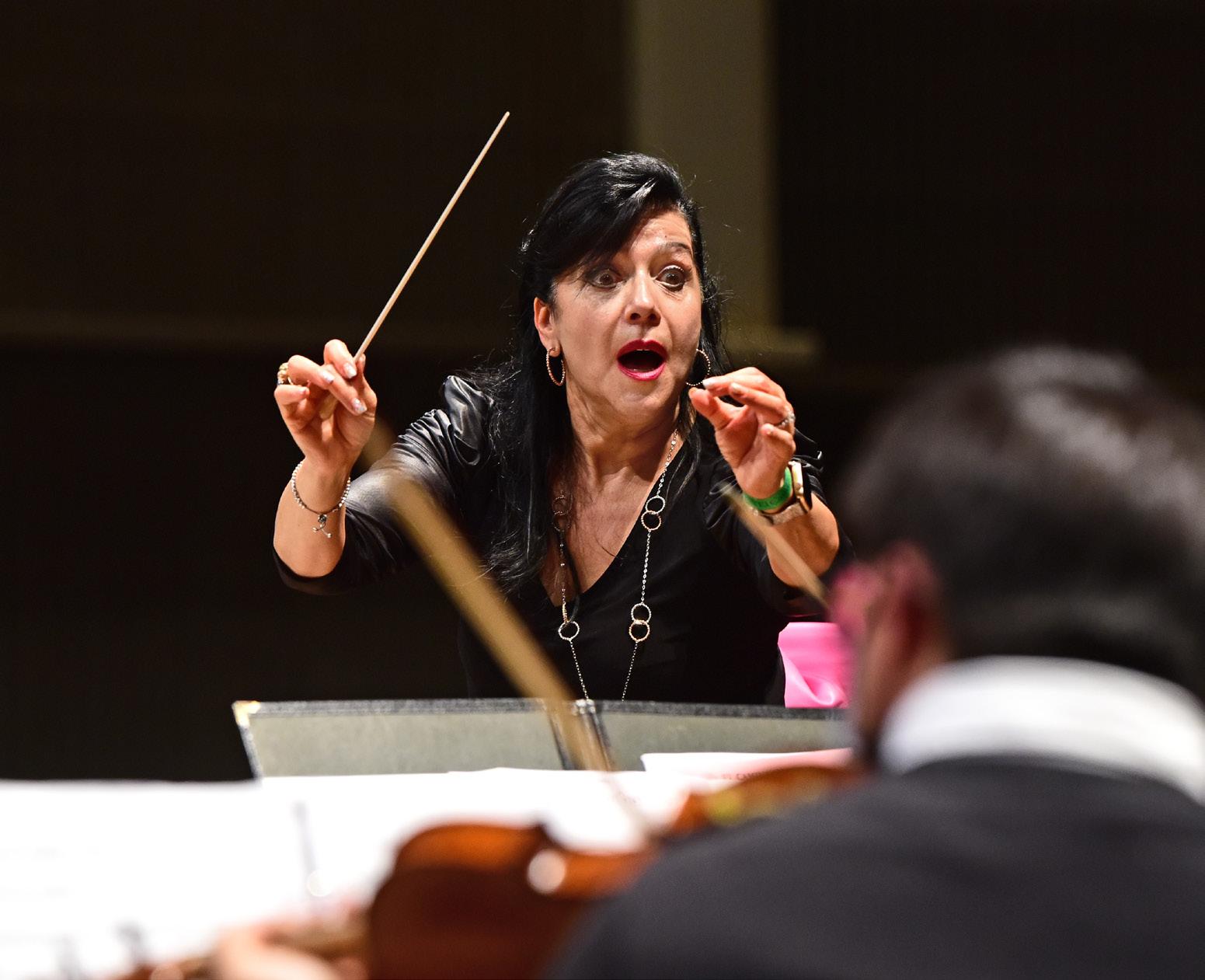
“I’m not trying to replace a man, I’m trying to complete the circle,” Joanna says. “I wear elegant dresses and look attractive because I want the audience to see beauty on the stage. That’s why I insist my singers are also dressed (impeccably).”
Rodney Rose, an ECC music student of Joanna’s in 1997 and now a member of her JMNS chorus, marvels at her sense of style.
“She is a force of nature,” Rodney says. “Joanna has a great
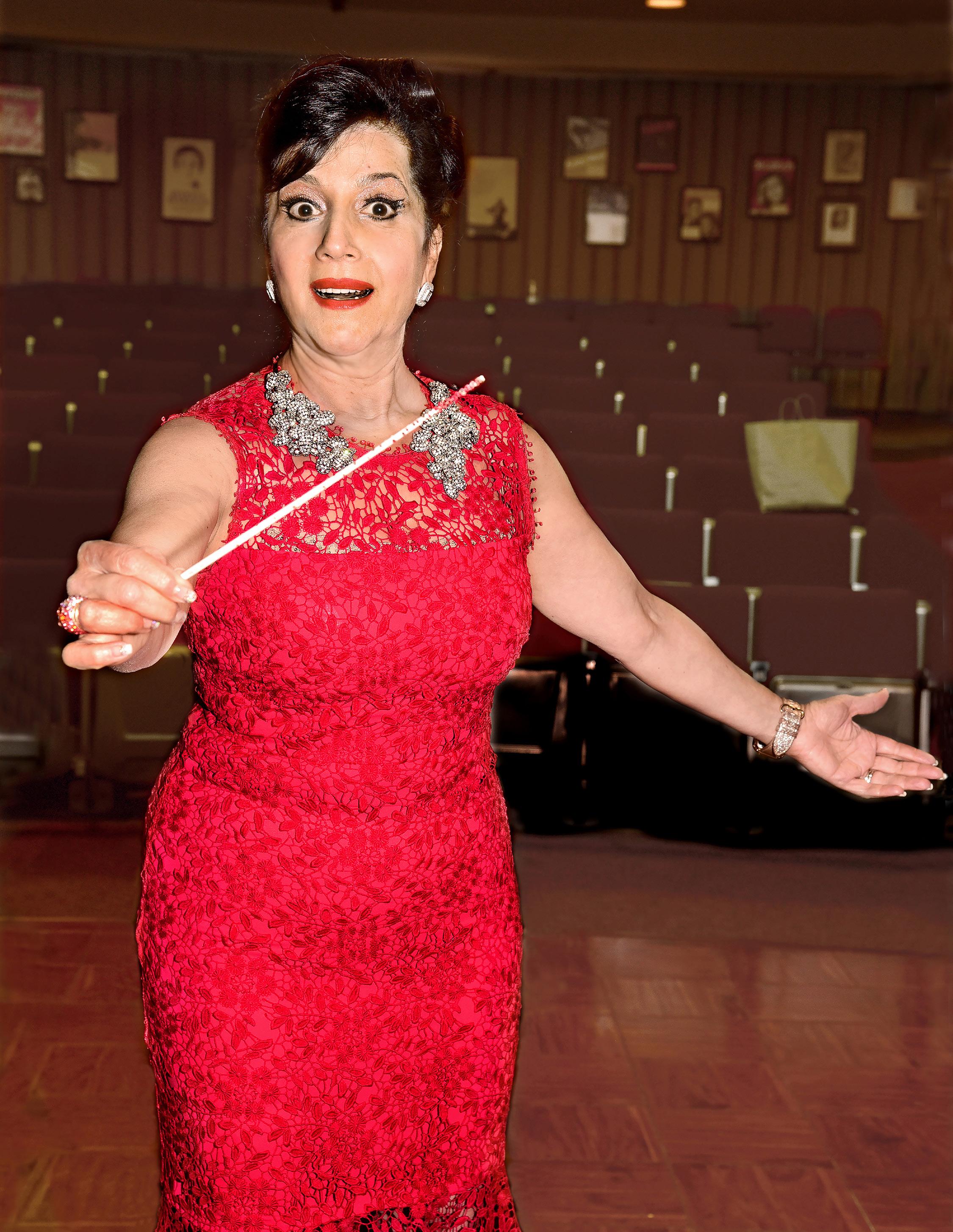 Joanna Nachef is as much a fashion maven as she is a musical pioneer. She will frequently change conductor outfits during a break in a concert, she says.
Joanna Nachef is as much a fashion maven as she is a musical pioneer. She will frequently change conductor outfits during a break in a concert, she says.
Joanna applauds the bass section of her choral class.. Joanna frequently divides the class so she can listen to the various vocal sections. She is a believer in positive feedback and support. Her students are told that she expects “excellence” of then, not perfection.
sense of fashion and is always dressed immaculately, with a little bit of sass.”
Female conductors have to work harder to earn respect and acceptability, Mary Lou “Marya” Basaraba, resident chorus maestra of the Golden State Pops Orchestra, says. The GSPO is a symphony pops orchestra formed in 2002 and is the resident orchestra in San Pedro.


“I believe women are judged much more harshly on their podium presentation than their male counterparts,” Marya says. “The onus is on the women to look great, especially nowadays with so many
televised events.”
With her wardrobe set, Joanna adds sparkly teardrop earrings to complete the look.
Her appreciation for jewelry is understandable since her parent’s own Medawar Fine Jewelers in the Rolling Hills Estates.
“(Colleagues and students) call me Dr. Bling,” Joanna says with a laugh. “Here comes the diva, the maestra. I love glitter. I love sequins. You can tell by my (glittery COVID health) mask. And why not? It’s part of my persona. It brings more brightness to the day.”
“ When I step into the classroom, I give a performance. My motto is ‘life is a performance, not a rehearsal.’ Today I’m going to give my best effort. I believe in presenting and expecting excellence.
Joanna Nachef ”Joanna and her students rehearse Vivaldi’s “Gloria,” which was planned for a December 2021 concert at ECC. The tenor students from left are Christian Jones, Denise Fessenbecker and Nolberto Mesa.
Besides her conducting and singing talents, Joanna is also an accomplished pianist. Her choral class and orchestra performed a holiday concert at ECC Auditorium in December 2021. She is the first female conductor in the Middle East and has always included fashion and decorum into her concerts
1977 - Immigrates from Lebanon to the U.S. Family settles in Palos Verdes. Attends ECC.
1988 - Earns doctorage in music arts from USC.
1989 - Becomes the first female conductor from the Middle East.
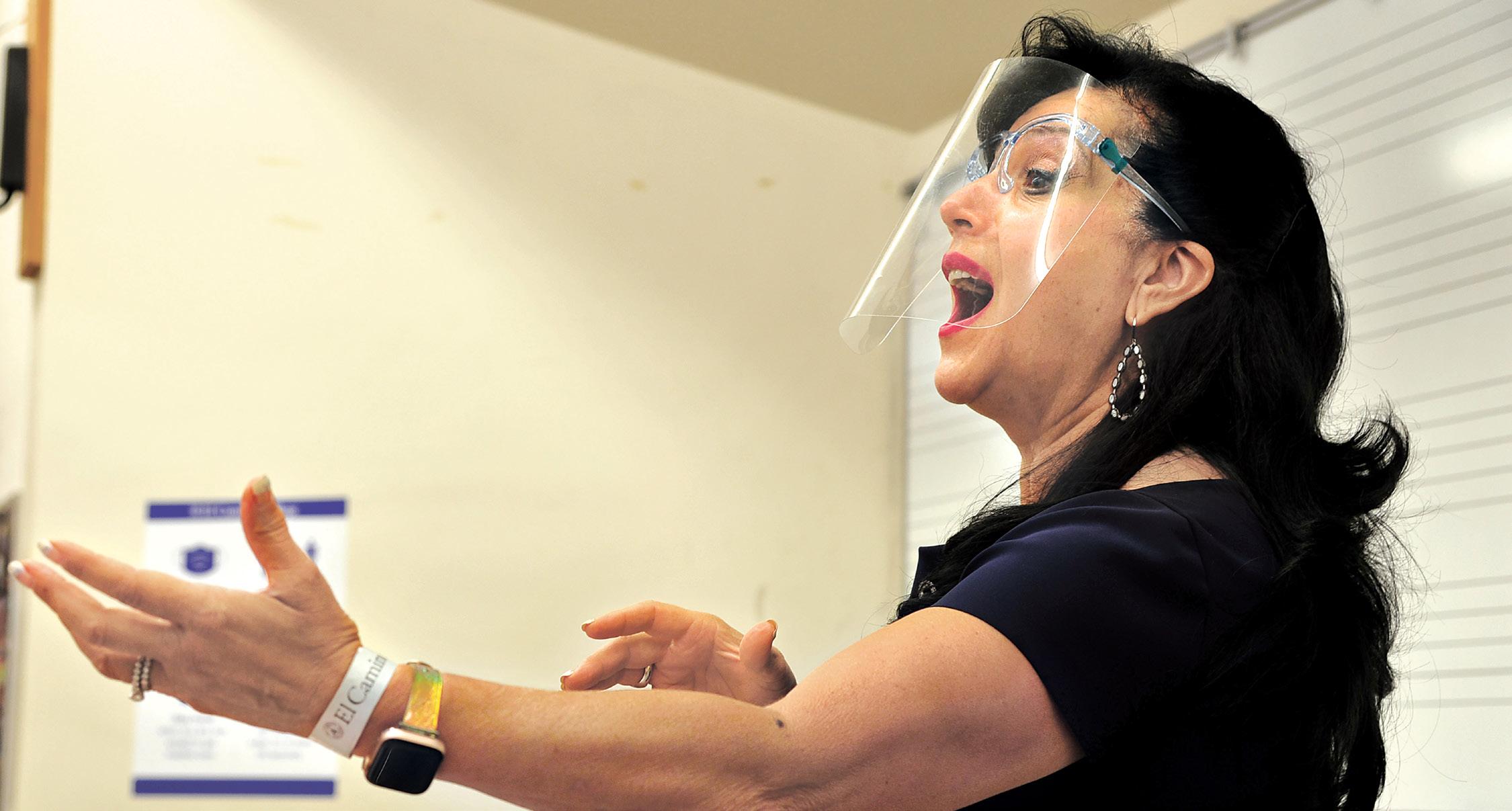
1996 - Named director of choral activites, ECC.
2004 - Helped initiate the program “Global Edu caion Through Technology.
2006-2018 Six times conductor at Carnegie Hall. 2014 - Conducted Lebonese Philharmoc Orch. 2014-2015 - ECC Distinguished Faculty Award.
2017 - Creates her choir, the Joanna Medawar Nachef Singers.
Joanna says it was challenging teaching music virtually during the pandemic closures and that her music students can get the full benefits of learning in a classroom setting.
2018-2019 - Director for the Torrance Pops Or chestra — Joanna & Friends
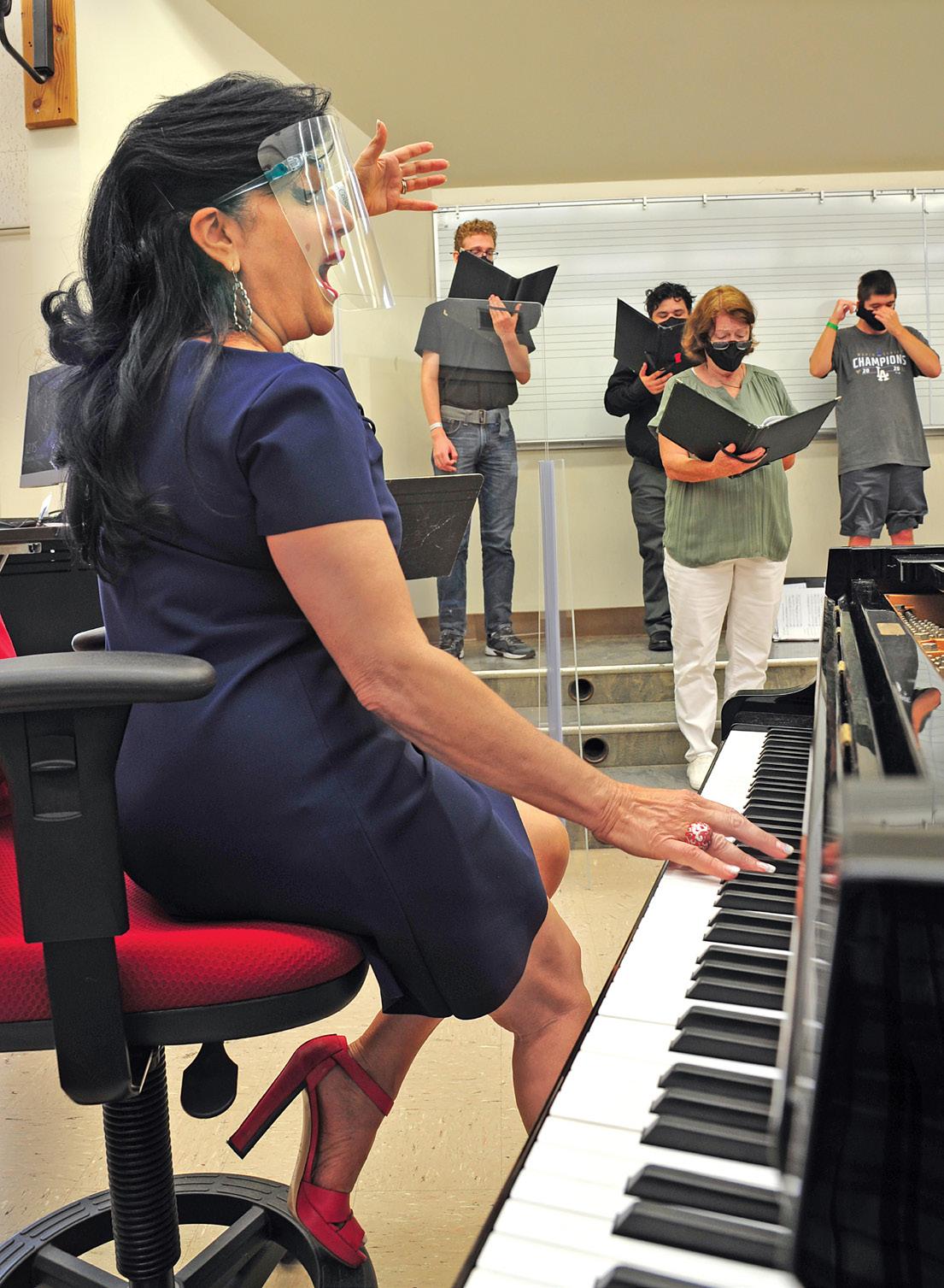
As with everything else, her home life is a juggling act. Joanna has been married to husband Hani for 34 years. They met in Lawndale in 1983, when Joanna was invited to conduct the Arabic choir started by Hani and friends.
The couple have lived in their PV home for 25 years, where they enjoy gardening and cooking.
Hani retired from the corporate world to open two Jersey Mike’s Subs restaurants (as of 2021) in Gardena, starting in 2014.
Joanna and Hani have two adult children: Hannah, an attorney with Booth Law, a Torrance firm specializing in sexual abuse and serious injury cases; and son Timothy, a youth leader at Seacoast Grace Church in Cypress, who is studying to be a minister.
“
At top left, with hundreds of dress shoes to choose from in her wardrobe, Joanna says she matches her attire to her footwear. Her love of shoes is inspired in part by her youth, when she wore ugly boots to correct a foot problem.

At bottom left, Joanna also has a passion for fine jewelry. Her collection of earrings, necklaces, rings and bracelets is partially supplied by her parents' business, Medawar Fine Jewelers in Palos Verdes Estates.

At left, Joanna even color coordinates her conductor balons. of which she has dozens of all makes and models. Every item of dress has been carefully thought out over the decades of stage performances, Joanna says.
included fundraising to help students with air travel and hotel stay. Traditionally, conductors do not engage with the audience before a performance, she says. Joanna, however, diplomatically broke with tradition at Carnegie Hall.
She is a force of nature. Joanna has a great sense of fashion and is always dressed immaculately, with a little bit of sass.
— Rodney Rose, a member of the Joanna Medawar Nachef Singers and a former ECC music student
The in-class learning experience cannot be duplicated online for musicians, Joanna says. Which is why she has returned (early) to in-person instruction for all of her fall 2021 classes.
She calculates that more than 250 of her ECC music students have continued their music education at universities and performance art institutions across the world.
Joanna has led her El Camino students to six concert tours of New York’s Carnegie Hall in the past 15 years. This task has
“I told (the audience) what we are going to do. No boring historic stuff,” she says. “I said, ‘what were you doing at age 5? Guess what I was doing at age 5? I was sucking my thumb. But what was Mozart doing at age 5? He was composing and concertizing.’ And (the audience) connected,” Joanna says with a chuckle.

In May 2010, April 2013 and May 2015, Joanna conducted three historic performances at Carnegie Hall with choirs from Lebanon, Dubai and Los Angeles, she says.
“These students realized that they don’t have to learn each other’s language or culture,” Joanna says. “They stand side by side (when singing), have the same challenges, the same successes. It’s the best form of self-diplomacy.”
Joanna traveled to Lebanon in 2009 to compile Arabic choral music for publication in the United States. That year she also made her conducting debut in her home country at the Al Bustan Summer Festival in Beit Mery.
Her legacy was furthered when she conducted the Lebanese Philharmonic Orchestra in 2014.
One of Joanna’s proudest moments also came in 2014, when she ignited the career of a young Lebanese composer.
Georges Tomb, 22, sought out Joanna to show his work of music compositions.
“He asked if I would do his work here at El Camino and I said, ‘I have a concert in Lebanon in two months,’” Joanna says. “Georges responded, ‘You will do it in Lebanon?’”
Joanna, however, faced resistance from Lebanese music leaders.
“They fought me tooth and nail,” she says. “They did not want to open the door for a young composer to be featured.”
Her program was to conduct Beethoven’s Symphony No. 8 and Mozart’s Vesperae solenness de confessore.
“They said, ‘how would you put somebody young like that in the middle of these masters?’ Joanna says. “I said, ‘where do you think Mozart and Beethoven started? Somebody has to open the door.’”
She convinced her contemporaries to give the unknown composer a chance. Joanna included Georges’ compositions in the concert, highlighted by “Hope,” a romantic piece arranged for the piano and orchestra.
That performance made Georges the youngest Lebanese composer to have his work played by the Lebanese Philharmonic Orchestra.
“Joanna premiered my career, and as every artist needs someone to believe in him at first, she was the one giving me this very first chance in my country, where many wouldn’t have risked it,” Georges says.
Joanna’s last major concert was in 2019 when she took her JMNS troupe to Moscow and St. Petersburg, Russia to present Master Classes. JMNS and Pokroff Chamber Choir received a Department of State Public Diplomacy Grant, she says.

While her journey as ECC choral director is nearing its end, Joanna can’t imagine a life without sharing her music with the
masses.
Joanna says red is her favorite color and that it reflects her desire to create a memorable visual presence for her audience. Red compliments her blue-black hair color in a spectacular fashion, Joanna says. She also requires her students to dress impecably at concert performances.
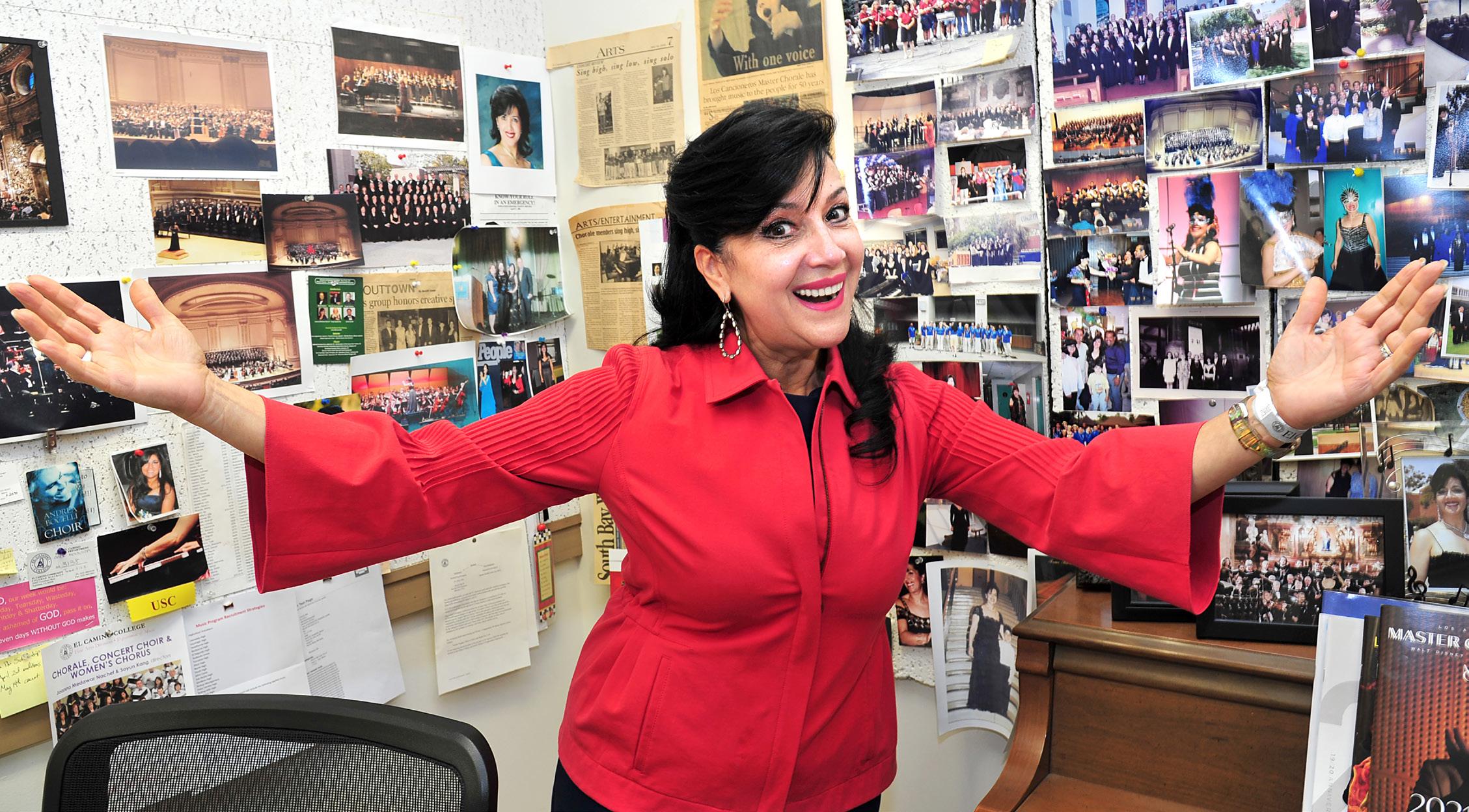
Joanna will even bring extra dress items for those students who have forgotten her concert dress code.
“I really believe my future is not just to do what I’m given the opportunity to do, which is to teach the discipline,” Joanna says. “But continue to live my life and show them that I’m not just a teacher, I am a performer.”
With her office walls adorned with photos and news clippings, Joanna shares the history of her accomplishments. She began as a student at ECC.Wanting to change up your diet and eat some tropical food? Or craving that juicy steak, with some rice and black beans? Or maybe some typical beach place seafood? If any of that applies to you, definitely check out some of these Brazilian places here in the South Bay.
Located on a small street in Redondo Beach, Panelas brings us classic homemade Brazilian plates. Among those plates are the traditional feijoada and the Strogonoff, with choice of steak or chicken. But the most popular plate is the barbecue plate, which comes with the famous picanha, perhaps the main steak cut in Brazil, chicken and sausage. Those are accompanied by rice, black beans, potato salad and the great farofa and vinaigrette. It is open seven days a week, with the focus being lunch time.
Address: 2808 Phelan Lane, Redondo Beach
Phone: 310-214-4143
Hours: Monday-Sunday: 11 a.m. to 7 p.m.
The barbecue plate at Panelas Brazil Cuisine lets you sample steak, chicken and sausage.. It is served with black beans on the side and the Brazilian soda Guarana, a great drink to go with it.
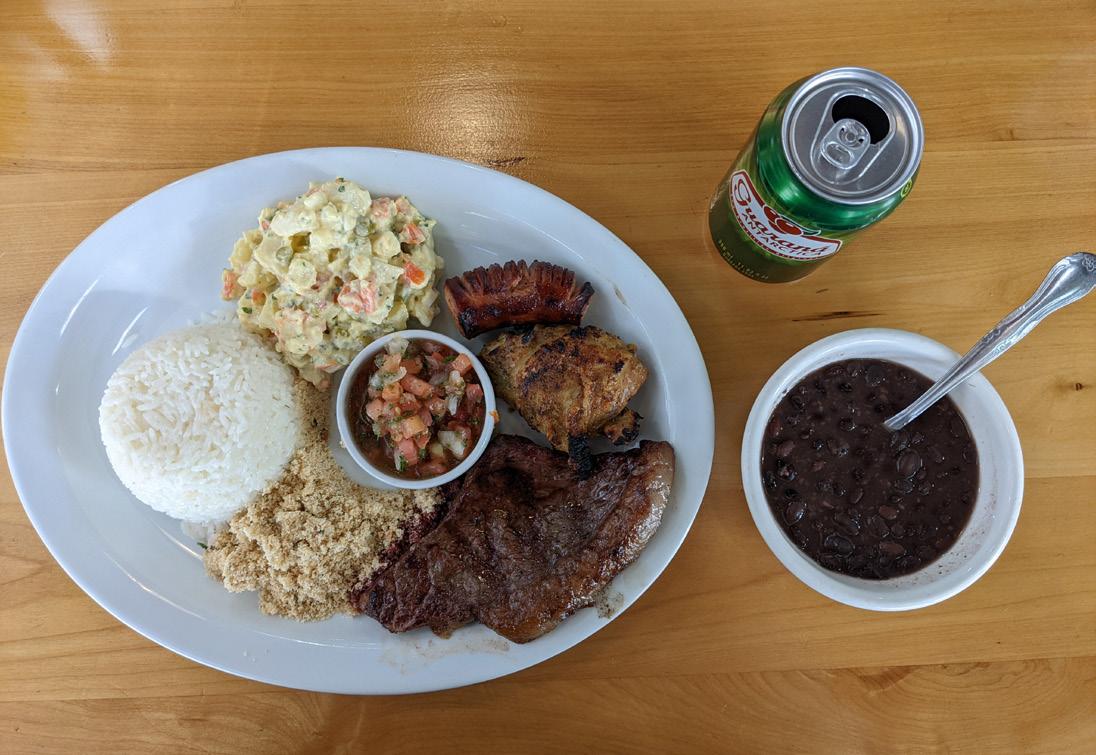
Website: https://www.panelasbrazil.com/
The Berry Acai Bowl at Natureba in Torrance is a delicious and healthy choice. Served with strawberry, banana and granola, it makes for a great energy boost for the day.
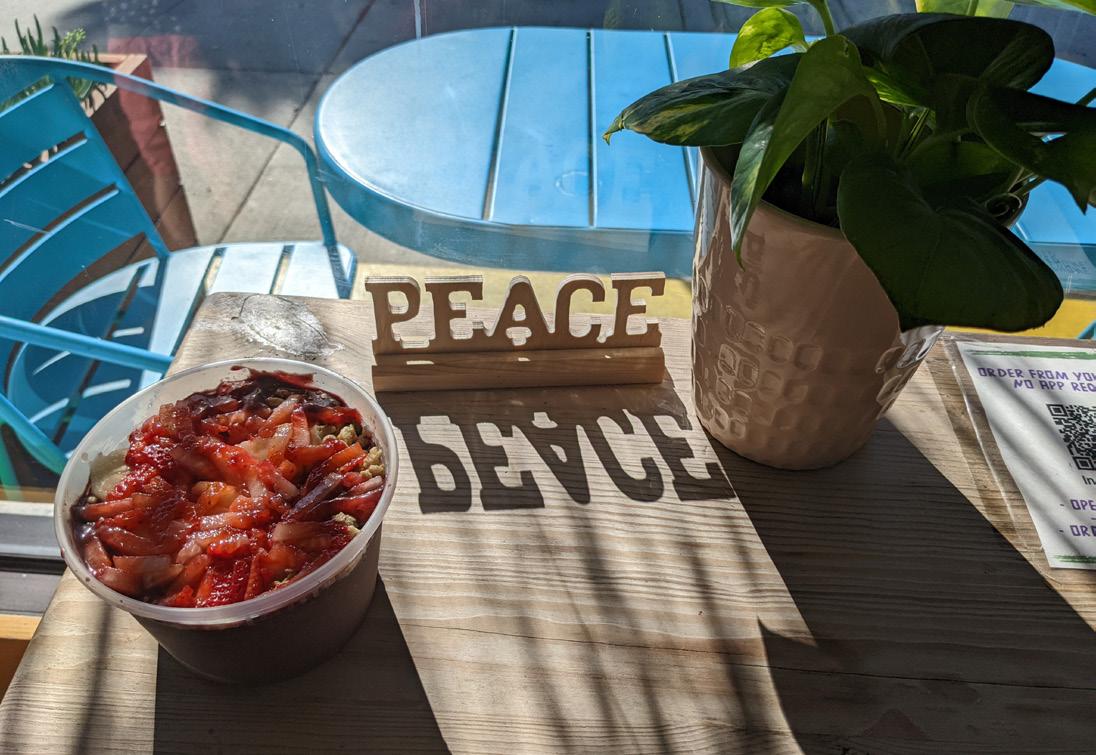
If you are looking for a more tropical choice, then Natureba is the perfect place for you. With a variety of juices and smoothies, it makes a perfect stop after a workout or an early run on the beach. Besides the drinks, the acai bowls are what make the place even better. The typical Amazon fruit is a great choice to eat with some other fruits and granola. Besides being delicious, it is also very healthy.
Address: 2415 Artesia Blvd., Redondo Beach
Phone: 310-597-4517
Hours: Monday-Saturday: 9 a.m. to 5 p.m. Sunday: Closed
Website: https://www.naturebajuicebar.com/
Sylvio's
in front of
atmosphere.
Beach Pier,
Silvio’s style goes back to the same style described for Panelas, but the main difference is the location. Situated right next to the Hermosa Beach Pier, it makes for a great place to hang out with your friends. The drink menu is amazing and the food is even better. A must-have is the Brazilian-style shrimp. Grilled with garlic, butter and lime juice, it makes you feel like you are at Copacabana Beach in Rio de Janeiro.
Address: 20 Pier Ave., Hermosa Beach


Phone: 310-376-6855
Hours: Monday-Friday: 11:30 a.m. to 10 p.m. Saturday: 10 a.m. to 11 p.m. Sunday: 10 a.m. to 9 p.m.
Website: https://silviosbbq.com/
As for some quick appetizers, the Brazilian Plate House is your choice. Serving the amazing coxinha portion, you can’t really go wrong. Coxinha is a small appetizer filled with chicken and a Brazilian cream cheese called catupiry. It also serves main dishes, such as the picanha plate, but the coxinha alone will make your visit worth it.
Address: 4509 Torrance Blvd., Torrance
Phone: 310-370-9077
Hours: Monday-Saturday: 10:30 a.m. to 8:30 p.m. Sunday: 11 am. to 7:30 p.m.
Website: https://www.brazilianplatehouse.com/
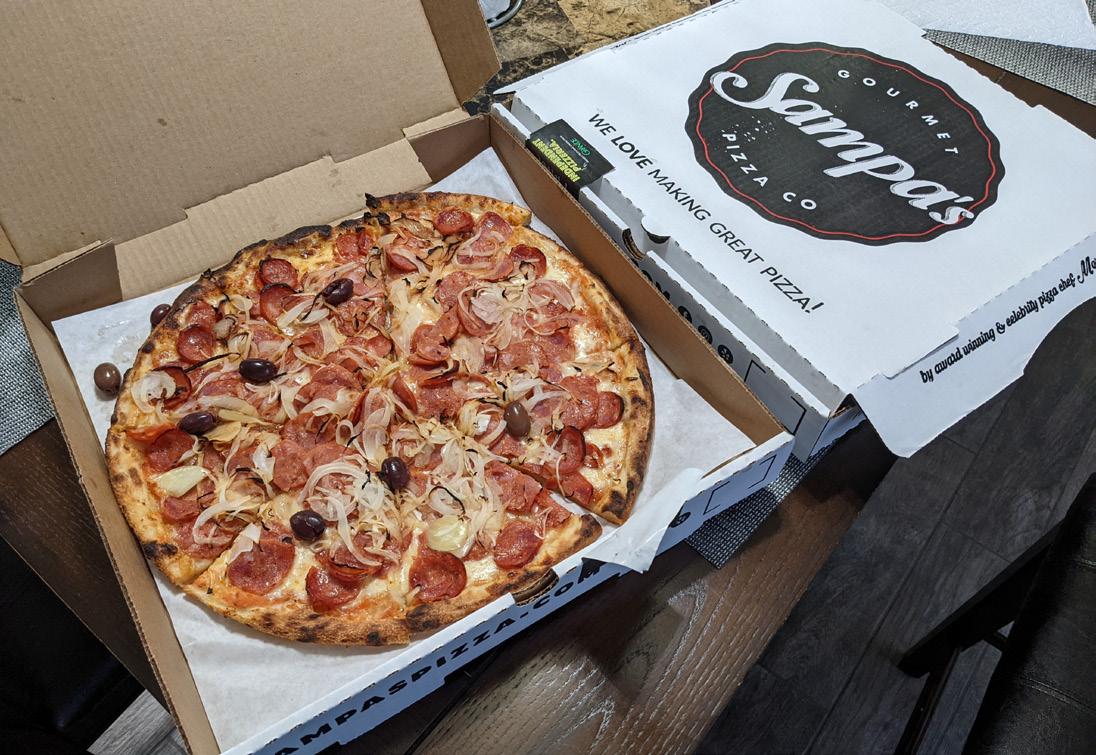
Brazilian-style pizza is something that was missing from this list, but no worries. Sampa’s is the perfect place for that. The menu is filled with the most popular Brazilian toppings and pizzas, including the Sao Paulo and Rio de Janeiro, with the former being chicken, catupiry and corn, and the latter being hearts of palm, catupiry and provolone cheese. Besides those, they do have the one and only Calabresa pizza, which is Portuguese hot sausage, onions and olives, just like if you ordered in Brazil.
Address: 2413 Pacific Coast Hwy. #107, Lomita Phone: 424-263-5750
Hours: Monday-Thursday: 4-9 p.m. Friday-Sunday: 11:30 a.m. to 10 p.m.
Website: https://www.sampaspizza.com/
spmething about death that provides a perspective to the living. I find that ironic. We grieve for the dead even though we will be in the same position one day. Trapped beneath the soil with nothing but the remains of our body to remember our existence.
It was not long ago that I realized how precious life is. A valuable life can be taken away in an instant.
As a Muslim American, I navigate the world through the lessons that shape me and the experiences that define me.
I was only 12 when my grandfather passed away due to Alzheimer’s. My grandmother passed away exactly two years and a month after my grandfather. After their deaths, I had prepared myself for a mental breakdown that never happened. I became a stone, but I found myself keeping a journal to keep track of these events.
Death was a hard topic to write about but as I grew older I took comfort in journaling. I wrote about how my grandfather was my superhero and how my grandmother was my muse. Writing became my specialty as I wrote to cope with the grief. One story I wrote for my high school’s newspaper addressed the Christchurch massacre that occurred in New Zealand.
I never got to see the video of the Christchurch gunman shooting bullets at the innocent Muslims inside the Masjid Al Noor mosque in New Zealand. But I know that the video explicitly showed traumatizing behavior because my mom somehow stumbled upon the video and she couldn’t sleep for weeks.
On March 15, 2019, a gunman walked into the Al Noor mosque in New Zealand with a camera and an ugly motive- to kill. The shooter had filmed the mass homicide from his helmet camera.
That day was a Friday.
Fridays are considered a day of celebration for Muslims. The celebration consists of attending a mosque, listening to a khutbah (Islamic sermon), and praying the Friday prayer.
I don’t recall much of what I did after hearing of the attack. Everything was a blur. I was pissed off to have heard of something
so devastating and ridiculous.
Days later, my high school’s Muslim Students Association in Torrance, decided to host a memorial in honor of all the lives that were lost that day. The memorial was held during lunchtime. Three speeches were given. All heartbreaking but hopeful.
“No religion has ever been about hate. No religion will ever be about hate,” one of the speakers said.
One of my high school friends attended the event with me. She’s not Muslim but she felt she should be there supporting the Muslim community.
“I felt good being there, it was different but I liked it. Most people don’t have the chance to hear these things. I believe if more people join as one, less violence would occur in the world,” she told me afterward.
My sister had offered some wise words to me on the day of the memorial. I asked her what she thought about having the memorial and the importance it carried.
“We wanted to recognize those who were killed such as those who were victims to the fear that other people, as well as the man who killed them, felt,” she answered.
At the time I was confused why she was talking about the gunman’s feelings and why it should be considered important. Now that I’m older, I’ve realized it’s important to consider everyone’s feelings. The gunman was a monster but he was also a human.
That same year, our high school’s MSA and Amnesty International Clubs collaborated to host a memorial for the lives that were lost in the tragedy. We held the memorial at Columbia Park in Torrance. The Cherry Blossom Festival was happening the day we had the memorial and we did get some coverage, however, not as many people showed up so we had a change in scenery.
We set up a table with post-it notes, pens, and pieces of cardboard. So many people came and wrote their condolences on the post-it notes that we barely had any remaining.
They shared their thoughts on the attack, and regardless of
the fact that we had not lost a family member as a result of the shooting, they reminded us to stay strong.
That day was a good day.
My fondest memory is when the Prime Minister of New Zealand, Jacinda Ardern, held a memorial to recognize all the lives that were lost and to lend a shoulder to all the grieving families.
Jacinda inspired me. She gave me a perspective on what a world leader should be.
She paid her respects to the Muslim community even though she had the choice not to. She didn’t have to give a speech that day or attend the memorial, but she did and I am so glad that she did.
I was so happy to see her wearing a headscarf out of respect for the Muslim community. I don’t know why but something about seeing non-Muslims wearing a headscarf or simply trying it out of their own choice makes me proud.
There’s so much negativity behind headscarves and whether or not they are forced upon Muslim women. When a queen wants to wear her crown nothing should prevent her from doing so.
The terrorist attack left a mental imprint on my life.
I learned that there are ways to stop these types of violence from occurring. In response to the Christchurch shooting, Jacinda
had banned all semi-automatic weapons including assault rifles. I admired her for doing that and I believe this should not only be implemented in New Zealand but most countries.
Her response made me believe that change is real.
When I wrote the story about the attack, I was able to provide a helping hand and empathize with the families who, like me, were unable to say their goodbyes.
Being a Muslim American has provided a new scope of living. I have to be cautious at all times and carry pepper spray with me everywhere I go. Even so, I am proud that I am a Muslim. Being the person that I am, I don’t take pride in many things except my religion.
The Christchurch terrorist attack served as a wake-up call and a reminder of how short and inconsistent life is. There will be trials that feel impossible to endure but I know that with every hardship comes ease.
Events like this terrorist attack allow journalists to educate people and gain access to the deceased’s history and lifestyle, giving me the opportunity to educate the public on topics that are not generally discussed and offer emotional support to families who have lost loved ones.

Edgar Castillo is an engineering major at El Camino College. He plays drums for hardcore punk band FUTURA.

Music is the language of the universe, or so they say. Even if it is somehow nonexistent elsewhere in the far reaches of the universe, however far that may be, it is undeniably important to the human way of life here on Earth.
Edgar Castillo, a 32-year-old engineering major at El Camino College, is no exception to this rule. His love for music has molded him into the musician he is today, with a passion he holds so dearly that it is embedded into every bone in his body. .
“It all started when I was like 13 or 14 years old and starting to really get into music. This band called The Casualties had an album called “On the Front Line” that was so different from what I was used to hearing. They were so fast, but still perfectly on time and the drummer stole the show for me,” Edgar says.
A member of punk band FUTURA since its foundation in early 2017, Edgar has retained his role as the drummer, though he does not limit himself to being a “backbone.”
“I play guitar, too, but my main instrument would be drums. I just feel a bigger connection when I am holding my drumsticks and keeping the tempo going as it should be,” Edgar says.
His height, although short in stature, is uplifted by his calm yet cool persona that band members naturally seem to have. Among his many physical traits, what stands out most is the fierce look in his eyes and the art tattooed on his arms.
“I am all self-taught when it comes to playing instruments. I have never had an instructor or taken a music class to learn how to do it,” Edgar says.
Like most aspiring artists though, his inspiration stems from the many experiences he has had on his journey through life so far, but is not limited to just that.
“My inspiration ranges from some dude playing guitar on Venice Beach to many of the great artists I listened to growing up. I try to find inspiration everywhere, so there is not really one particular person or thing I look up to,” Edgar says.
Before the band’s formation, the founding members had been
talking about it for months in late 2016. Once the new year started with Edgar as the last “recruit” to join, the original lineup was born. Consisting of Erika Lares on vocals, Diego Ramirez on bass, Eddie Patino on lead guitar and Edgar on drums, the four were ready to roll.
“My guitarist Eddie came up with the name of the band. He saw it on a tire. The name of the band is FUTURA, and so he said that’s actually not a bad name. Our singer is actually female, too, so we changed it from “futuro” to make it sound more feminine,” Edgar says.
Though they have shared the spotlight together many times while performing, their personal tastes in music differ a lot more than one might think to be possible in a cohesive unit such as theirs.
“We all listen to different kinds of music, and I think that really helps since it makes things more diverse. As a whole, the band’s inspiration comes from hardcore punk, like a lot of Japanese hardcore. Some American bands as well, a lot of mainstream stuff too,” Edgar says.
Despite their differences early on, they decided it was best for them if they got to work right away. Unlike many established bands with managers, the four took a “do it yourself” approach with their ventures. Through the many connections they had, a world of opportunities was at their door. Soon enough, the four got their first gig together and kicked off their musical journey.
“Our first gig was actually in South Central (Los Angeles). It was like a little backyard gig, kind of a low-key thing, but it was cool. At that point I had already been performing for a while with other bands, so I kind of already knew what to expect,” Edgar says.
With over 100 performances to their name, the FUTURA members have quite a staggering amount of experience, which they credit to their dedication of the craft. No matter how many shows they take up, however, Edgar believes some things will never change.
“I have been playing for a while, but I still get nervous. Those
“Do what makes you happy. Be your genuine, true self as long as you do no harm, and you will be happy with your life,”
- Edgar Castillo
nerves never go away because you never know what is going to happen during the show. This last show we played I was on guitar and it was not working, so I was pretty anxious. Luckily it turned out to just be my cable, so we were able to play,” Edgar says.
When asked about words that best describe Edgar as a person, two of his bandmates took center stage and spoke with confidence when touching on his qualities. They consisted of 36-year-old veterinary technician and lead guitarist Eddie, and 30-year-old Erika, who works in logistics and is lead singer.
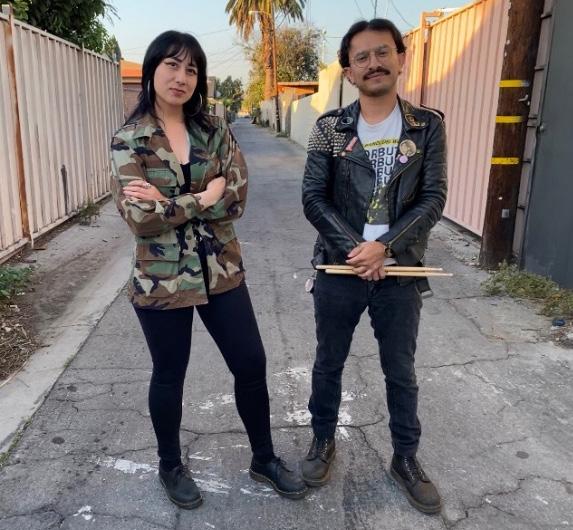
“Apart from being extremely talented, he is one of the most caring guys I know. He always puts others ahead of himself no matter what the situation is, and I do not think there is anything more genuine than that,” Erika says.
Though many positive comments may have felt like there was nothing left to the imagination, Eddie’s words brought an unexpected amount of praise to the table.
“He is honestly one of the best guys I know. A cool person to be around, and him obviously being a great drummer is a plus to the band. His style is not like a traditional drummer, he is one of a kind, so there is no other way to put it,” Eddie says.
Drummer and all, Edgar is still a working adult and a student at El Camino College who has homework, projects and other assignments to turn in. It is a pretty busy lifestyle, but he believes anything can be managed so long as you know how to sort things out and create time slots for activities other than school.
“I try to make sure I have all of my work done beforehand if I
FUTURA lead singer Erika Lares and drummer Edgar Castillo have played over 100 shows, including shows at Chain Reaction in Anaheim, Eli’s in Oakland and they’ve even traveled to perform in Allston, Mass. and Temuco, Chile. The band was formed in 2017 and has multiple EPs and a demo.need to play a show or go to band practice. If I do not get the work done then I stress out and I am not able to enjoy myself or connect with others as much as I would like to, so it really all comes down to planning ahead,” Edgar says.
In the times that the band’s members are overrun with a whirlwind of tasks, however, Edgar believes it is difficult to get things done. From work to their own personal lives, many things can get in the way of a proper performance or practice session.
“We really have to schedule things for all of us to meet up at the same time because we have other stuff to do, so that just adds another obstacle we try to get around,” Edgar says.
Things do not get much different for the four during the creation process when recording songs for their EPs. A difference in free time slots causes quite a stir during these times as well.
“When actually getting down to making music, we have a lockout in downtown L.A. that we pay monthly for by splitting the cash four ways. It is open 24/7 and is used by other bands as well, but just like those bands, we hardly go since we are all pretty busy people,” Edgar says.
With several EPs to the band’s name, many of which can be found on YouTube and Bandcamp, Edgar finds it hard to pick a favorite one, and even harder to pick a personal favorite song he likes to perform in front of a crowd.
“There are so many songs, but if I had to break it down to one I could probably do it. My favorite song is probably ‘Sin Salida’ off our first demo. It talks about being in a state of depression, and eventually the lyrics really matched up with what our homie was going through after we realized the harsh reality,” Edgar says.
Suddenly there is an abrupt pause. Life is not without the hardship of loss, even when the gift of joy and happiness seem to go on without a halt.
“In July of (2020), we got the wonderful opportunity to tour to Chile, but sadly, we lost our bassist Diego just before that. He was so talented, but above everything else, he was just a really nice guy. Nothing will ever replace the great memories we made with him while he was still with us,” Edgar says.
Diego, who was affectionately known by his nickname “Eggo” had been going through depression for a while, ultimately opting out of the tour that would see them travel thousands of miles from home. Despite knowing they would be heading to Chile without their bassist for undisclosed reasons, they never expected the worst to come before then.
“After he passed, we held a benefit event to help his family raise funds. We also had to perform on that day, and it was the hardest thing I had to do. We were just crying nonstop,” Erika says.
Fellow bandmate Eddie also mourned the loss of his friend with a heavy heart and did not hold back on his feelings for their bassist, who he deemed to be incredible and one of a kind.
“It was a hard loss that we will never recover from, and we knew we would have to give it all we had in order to perform without crying,” Eddie says.
Having already set up a temporary arrangement with another bassist Erika knew, the heartbroken band was ready to go. Not knowing how things would turn out, or if they could even perform without a bucket’s worth of tears streaming down their faces, the four took off to South America.
“Thanks to the power of the internet, we were able to network with people all over the world. The tour took place in Temuco, Chile, and it was really cold when we went. I just could not believe how far we were from home. Just thinking about our first shows
we had done locally and comparing it to where we were heading was something special,” Edgar says.
Like one would imagine, no country is an exact copy of another when it comes to the atmosphere and culture, especially if that country is on a whole different continent thousands of miles away.
“It was amazing. It was definitely different. Over there it is not as individualistic as America is, it is a lot more community-based. For example, if we had one beer and there were seven of us, we would split that one beer between everyone. Over here it is more like if you do not have money, well, too bad,” Edgar says.
Many great memories were made of the experience for the newcomers who were well received by the locals in Chile. Through the tragic death of a loved one, they were able to connect with the community that was also going through the same pain, an unfortunate event that brought the two that much closer.
“When we went to play those shows, one of theirs in their community had killed themselves, so we trauma-bonded over that. There were so many people, and we played really well because we wanted to dedicate the show to the ones we lost. It was amazing because they knew the words to our songs, which we did not really expect,” Edgar says.
To Eddie, his favorite moment with Edgar occurred during this tour in Chile that had such an emotional and everlasting impact on him.
“My favorite moment with Edgar was watching ‘Bohemian Rhapsody’ with him on the way to Chile. Since the movie was about performers, and we were obviously going to be performing, we imagined ourselves on that stage and how cool it would be to have the crowd sing along,” Eddie says.
Erika also chimed in with her favorite moment involving Edgar, speaking passionately about the time in which the drummer took the microphone to speak in one of the many rare instances.
“He got up to give a speech about the people we lost, saying that the show was dedicated to them. He assured us that we were all in this together, and it made me so happy because he almost never grabs the microphone, and hearing him say all those nice things was enough to make anyone cry,” Erika says.
Though they have not toured in almost two years, the flame has not died out for Edgar, and it might not ever be the case. With his “live as you please” take on life, there is still plenty of time to make music and have fun while doing so, and never forgetting the experiences that shaped him into his present self.
“Do what makes you happy. Be your genuine, true self as long as you do no harm, and you will be happy with your life. Chase your dreams and never give up no matter what, because the struggle will pay off in the end, and as far as we know, we have one life. Make the most of it with all that you have got,” Edgar says.
Title:
FUTURA 3030
End it All
Spit on the Flag
FUTURA (Demo)
https://futura3030.bandcamp.com/
Released:
2019
2018
2020
2017
 Edgar Castillo overlooks the campus at El Camino College in Torrance, Calif. He is a multi-instrumentalist who has taught himself to play drums and guitar.
Edgar Castillo overlooks the campus at El Camino College in Torrance, Calif. He is a multi-instrumentalist who has taught himself to play drums and guitar.
El Camino College men's volleyball Head Coach Richard "Dick" Blount looks toward winning the state championship. The Warriors ended the season as the No. 4 seed in the Western State Conference. (Greg Fontanilla | Warrior Life)

El Camino College men's volleyball Head Coach Richard "Dick" Blount reacts to a referee call during the March 11, 2022, volleyball match against the Long Beach City College Vikings at ECC. The Warriors upset the No. 2 ranked-Vikings to improve their conference record to 4-1 and 7-4 overall. Dick has been the head coach since 2001. (Gary Kohatsu | Warrior Life)

Carefully watching his players running drills at the new El Camino College volleyball courts, he gives advice to his players, always in a helpful and calm way.
The two most important things in his life are volleyball and his players.
Richard "Dick" Blount, 66, is the head coach for the men’s volleyball team at ECC. He is entering his 21st season.
He has enjoyed a tremendous amount of success with the team, but he insists that his players are the reason for the success.
The way that he cares about them is the main reason for Dick's long success coaching at El Camino. The team has a 66-32 record and has won six state championships in the last six years.
He is also a coach for beach volleyball, but unfortunately for him it has to be outside El Camino, as the College does not have a men’s beach volleyball program.
“I told them that I would coach for free,” Dick says of the possibility of having the program.
Living in Manhattan Beach, where beach volleyball is very popular, Dick was able to coach many stars in his long time coaching.
One thing that Dick enjoys about it is that there are many international players who come play for him. By having different cultures, he is able to learn more about the game, and then adapt his way of coaching.
“I’ve coached players from all over the world, including countries like Canada and Brazil,” Dick says.
But with all of his success, it took a lot of hard work for him to be able to achieve his dream of working with the sport that he loves.
Volleyball only became a team sport for men in 1971, which was the year that Dick graduated from Mira Costa High School. He then went on to play for the El Camino team the next two years.
When remembering his time defending the Warriors as a player he recalls that he was much younger than his competition.
“I was playing against guys that wanted to stay out of the draft, you know, for the Vietnam War,” Dick says. "So there I was a 17 -year-old, playing against guys that were 22, 23.”
During that time, you could stay out of the draft if you had 12 units and grades of B or higher, but the volleyball path, especially at that time, was not very profitable for players.
Fernando Gomes, the current head coach of the professional Brazilian volleyball club, São Cristóvão, says that a volleyball player’s salary in 2021 do not even compare to those of other sports, like soccer or basketball.
“A soccer player at a middle tier club in Europe makes at least 1 million euros a year, while the biggest volleyball stars dream of getting near that,” Fernando says.
So after a couple of years at El Camino, Dick transferred to San Diego State where he majored in business management. He then went on to earn his master degree in physical education at Azusa Pacific University.
Through all that, he still had volleyball on his mind. He wanted to come back to the sport, and he could only do it as a coach.
“I was only 5 feet, 9 inches, and couldn’t jump for my life,” Dick says. “So I knew I had to be a coach.”
His first opportunity came as the head coach of Palos Verdes High School in 1989. He only stayed there a couple of years, as the schools in Palos Verdes merged.
Former Palos Verdes High School basketball coach Wendell Yoshida remembers Dick’s time at the school very well.
“His impact in the program was very clear,” Wendell says. “There was a lot of success in his short time there.”
Wendell continued his work with the Rancho Palos Verdes
"There were guys that lost scholarships at four-year colleges, as their seniors were able to stay an extra year, leaving no room on the roster for new faces."
- Coach Dick Blount
From the sand courts to the state semifinals, coach eyes the state title
schools, just recently retiring as the Athletic Director at Peninsula High School.
As for Dick, he continued to pursue his dreams of becoming a volleyball coach full time, and another opportunity came, as Mira Costa gave him the chance of coming back.
Costa was regarded as one of the best programs in the South Bay and Dick recalls his time there.from 1992 to 1996. He left because of a once-in-a-lifetime opportunity. He was asked to work at the 1996 Summer Olympics in Atlanta, but for the rowing events.
“What would you choose?” Dick says. “Coach volleyball at a high school, or go run the Olympics?”
The glow in his eyes when talking about the Olympics was noticeable. Dick ended up being part of three silver medals and a bronze medal for the United States team in 1996.
“I would have made that choice 100 times over 100,” Dick says. After the Olympics, Dick took a couple of years to focus on his beach volleyball program in Hermosa Beach, but then in 2000, the El Camino job became open.
“They called me saying there was an opening.” Dick says. “So I applied and then got the job.”
Dick still says that it was the best decision of his life.
During his time here, Dick has exceeded expectations. Since 2014, the team has gone to the California Community College Athletics Association Men's Volleyball State Championships every year.

All the success that the program has achieved during these 21 years can be credited to Dick’s outstanding job as head coach, as he's won the South Coast Conference’s Coach of the Year award in 2001, 2011 and 2014, but in his point of view he barely had to do any work.
“It means that the players did it. I would never have won those awards if the players did not perform,” Dick says.
He pulls a file out of his backpack, which has the names of all of his players that had great achievements, on and off the court. It has a list of the recent scholars that the program produced, while also having the name of every player that has won an award while playing for him.
“When the players that I coached in the past come back to me and tell me what they are doing now,” Dick says, as he looks at his team practicing in the court beside him. “I don’t care what it is, as long as they are doing something, that makes me feel like I have done my job.”
Not all players end up transferring and playing at a four-year college after El Camino, but when scouts for some of the Cal States or University of Californias come watch the players in person it adds a little more pressure and motivation to them.
“We do have scouts from universities that come to see us in December, and they (analyze) everything that a player does, on and off the court.” Dick says.
That motivation helped former Warriors outside hitter Cinjun Coe succeed. Cinjun was the 2019 All-Conference Most Valuable Player in his first season at El Camino, after transferring from Illinois Institute of Technology, putting him on notice to the fouryear universities.
In fall 2021, Cinjun transferred to the University of California, Santa Cruz. He entered his senior season and that was possible because of the work he put in playing for Coach Blount.
He won 2021 Athletics Newcomer of the Year at UC Santa Cruz.
That love for his players still makes him lament the two seasons that were cancelled due to the COVID-19 pandemic.
“It sucked for them. There were guys that lost scholarships at four-year colleges, as their seniors were able to stay an extra year, leaving no room on the roster for new faces. We were top two in the state in 2020, so it was very sad for us to see the season end like that,” Dick says.
Former Warriors middle blocker William Lubs was one of those players who had his second and last season cancelled due to COVID-19 and he elected to stay and compete one more season in fall 2021 for El Camino and, especially, Coach Blount.
“It is a joy to play for him,” William says.
With COVID-19 behind them, the team prepared for a new season and had high expectations.
“We (had) 4 kickback players, which are players that played for us before, and came back with a year of eligibility left. They are more experienced, and that (helped) us a lot.”
Along with some returning players, there was an addition to the coaching staff last season, as Kyle Stevenson was added to assist alongside Kurt Peters, assistant coach for 16 years.
The Warriors ended the 2022 season on April 21 as the No. 4 seed in the Western State Conference, with a loss of 3-1 against the No. 1 seed Long Beach City College Vikings at the CCCAA Men's Volleyball State Championship Semifinal held at ECC, and with numerous trips to the semis, the plan for next season is clear "Win state." Dick says.
(Above) El Camino College men's volleyball Head Coach Richard "Dick" Blount signals his approval during the March 11, 2022, volleyball match against the Long Beach College Vikings at ECC. The Warriors upset the No. 2 ranked-Vikings to improve their conference record to 4-1 and 7-4 overall. Coach Blount has been the head coach since 2001.
(Gary Kohatsu | Warrior Life)
(Right) El Camino College men's volleyball Head Coach Richard "Dick" Blount remains stoic as the Warriors erupt with elation after a winning set vs. the Long Beach City College Vikings. The Warriors won the match 3-1 on March 11, 2022, in the ECC gymnasium. (Gary Kohatsu | Warrior Life)
(Opposite) El Camino College men’s volleyball Head Coach Richard “Dick” Blount considers possible team matchups leading to the South Coast Conference playoffs on March 17, 2022, in the campus gymnasium. Players in the background are (L-R) left back Dylan Malit, outside hitter Dylan Garcia and setter Vladimir Kubr. (Gary Kohatsu | Warrior Life)

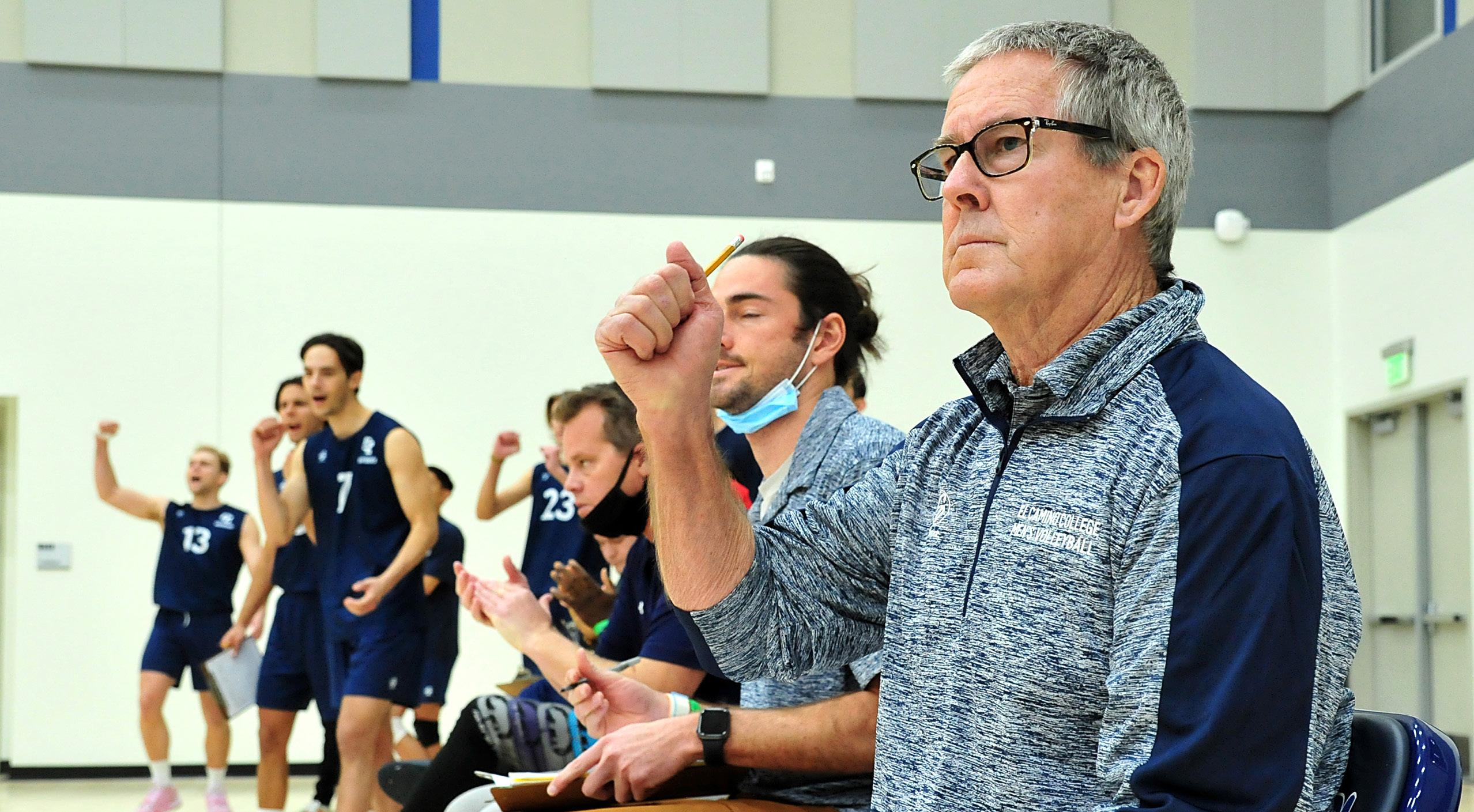

Imet my husband at a mutual friend’s house in Highland Park, California, in 1990. He played guitar in a death metal band that I followed to backyard parties in Hispanic neighborhoods all over Los Angeles and to clubs like the Country Club in Reseda, the Waters Club in San Pedro and a show in Tijuana, Mexico. We dated briefly in 1991 and ‘92, then went our separate ways.
Ten years later, in 2002, we ran into each other at a metal festival I was working in Whittier. We exchanged phone numbers and quickly picked up where we left off. Six months later I moved in with him in Santa Ana.
Through my job at an independent record company and his job at a guitar company we were able to get into countless shows for free. Together we went to local club shows, concerts and even traveled to some festivals in Cleveland; Baltimore; Calgary, Canada; and Leipzig, Germany; for the next eight years.
At this point I was 39 and he was 40. His father had passed away five years prior and we had moved in with his mother in Riverside. We were living rent-free and traveled quite a bit, but we weren’t progressing in life.
We had known each other for nearly half our lives and we had talked about getting married and having kids, yet we didn’t feel ready for the commitment or responsibility. We knew that our window of opportunity was closing. I’d be past my child-bearing age soon, so if we wanted to have a child it was now or never.
One morning in February 2010, I sat up and my head was spinning like never before. It wasn’t a hangover. This was different. I went to a nearby health clinic in Glen Avon, California, and the nurse asked me when I last had a beer. I told her it was around Christmastime and she said not to drink anymore because I was pregnant.
I wasn’t much of a beer drinker, but I was drinking lots of Coke. Fortunately, I was able to get weekly prenatal care at Torrance Memorial Medical Center, which included heart rate monitoring and seeing a nutritionist. For the next seven months I followed a strict nutritional plan and had my son in September 2010. I was 40 years old.
Having a son gave me a great sense of fulfillment, but at the same time it felt like a mistake. I was too old for this. The crying, diaper changes and feedings were 24-hour ordeals. Neither my husband nor I were getting much sleep. I questioned what we had done, but it was too late. We were now responsible for this little life and it was overwhelming.
The next several months were the most challenging. I went back to work on a reduced schedule, but that didn’t last long. Bottles and formula weren’t working. The baby was nursing and only
wanted me. On several occasions the baby had to be brought to me.
I was eventually laid-off from my job, but it was a blessing because my son needed me more than I needed the job.
As my son got older, taking care of him became easier, but I was a full-time mom and that was depressing. I was irritable, angry and emotional for several years. Not months. Years. Not being able to work, go to concerts, travel or ride on the back of our HarleyDavidson motorcycle caused me to feel a tremendous loss of identity, freedom and guilt.
I knew being a mom was going to be hard, but it was beyond comprehension. I couldn’t understand why it was so hard to adjust to my new role.
Little by little I accepted the fact that I was no longer “Elsa” and instead I was “Mom.” Over time I realized I probably had postpartum depression.
It was only after reading an article from the Journal of the American Academy of Physician Assistants that I learned older moms “have a statistically significant increased risk of postpartum depression” due to many factors, including “increased responsibilities and additional burdens of contributing to the family finances.”
In a Metro Parent article, Reproductive Health Psychologist Sara Rosenquist states that stay-at-home moms suffer a loss of “status, income, friends and the life they knew.”
According to a Washington Post article, an estimated one in seven new moms suffer from the more serious postpartum depression and an estimated 50 percent of those cases suffer in silence and never get professional help. I was an older, stay-athome, new mom who didn’t get help and probably should’ve.
When my son was ready to start kindergarten I decided to homeschool him through a hybrid charter in Hawthorne, mostly because I wanted to be involved in deciding what he learned, but also because we were commuting with my husband from Riverside to the South Bay, where he works and my parents live. We needed flexibility to learn on our own time and wanted to stay close by in the event of an emergency.
We’ve met several families with the same need flexibility at my son’s hybrid charter, and though I expected to find mostly younger home-schooling moms, surprisingly, a lot of them are older like me.
My son is now 11 and he’s my sidekick that goes almost everywhere I go.
I still have moments where I struggle with the idea of looking after more than just myself, and though I’m no longer a new mom, I’m still learning.
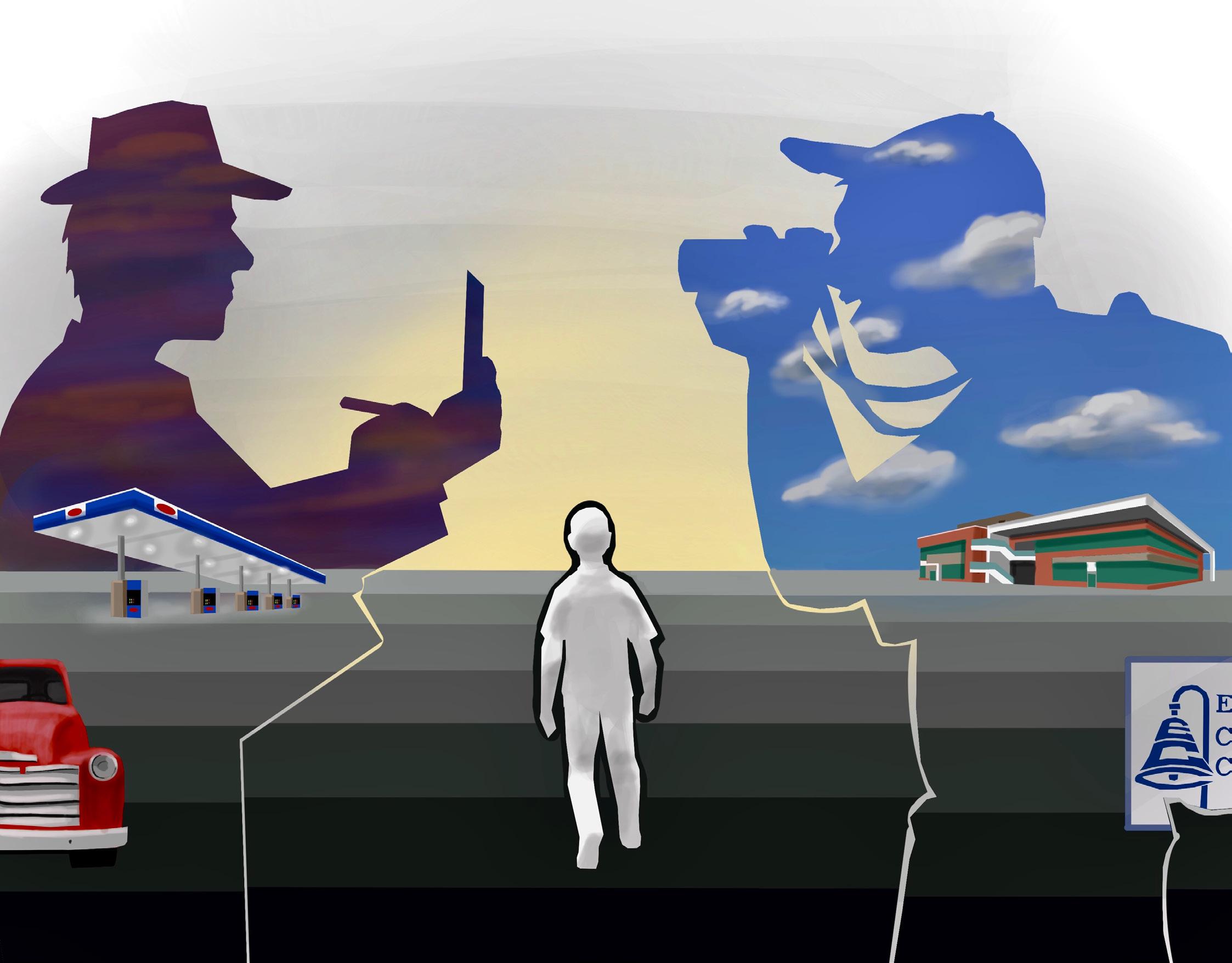
Good guys finish last, the headline read.
Written by Gary Kohatsu Illustrated by Jesse MirandaOn Feb. 4, 1969, armed robbers confronted my father at the World Oil Gas Station in Santa Monica. He worked the graveyard shift as a gas attendant and minutes after clocking in, he faced three suspects who demanded money. Two of the robbers were young adults, while the youngest suspect was my age — 14.
One of the robbers fired his gun, striking my father in the abdomen. He would lie in a pool of blood until help arrived. Police apprehended the suspects.
My dad was rushed to a Santa Monica hospital, where he died on the operating table.
Journalist Vance Pollett wrote that my father toiled at life until his luck ran dry.
“His share of the world’s goods didn’t bulk large and Kohatsu had to work at two jobs to make ends meet,” I recall Vance writing. “Early this morning, he was cut down in a blaze of gunfire.”
The final hours of my father’s life were chronicled in three stories by Pollett, a reporter for the Santa Monica Evening Outlook.
I didn’t know it then, but Vance’s stories would be my beacon in life.
My dad left behind very little: his pickup truck, gardening tools, the transistor radio I gave him the Christmas before, an alarm
clock and the bloody clothing he wore on his last day, which were stuffed in a plastic bag by emergency room nurses.
He had no life insurance.
The gas station hustle was a thankless job, hampered by weird hours, bad pay and dangerous working conditions after sundown. But it was the only job my dad could find that fit his rigid gardening schedule.
He began sleeping in a downstairs bedroom, away from the family. His coming and goings at odd hours would be less distracting, he thought.
On most days, he would crawl into bed before sunrise and crash for a few hours before starting his gardening jobs, which stretched from Hollywood to Long Beach. He repeated this routine Monday to Friday.
My parents discussed quitting the gas station job. But, my father was an eternal optimist. He chose to continue moonlighting.
Everything would be fine, he assured my mother.
We buried my dad at Evergreen Cemetery in Los Angeles. He was 47.
As I look back, I try to make sense of what occurred that early morning. My Uncle Dave told me, “you’re the man of the house now.” He meant well. But I was just a kid who was to start high school that same morning.
I scribbled one of Pollett’s stories on a sheet of notebook paper. Then I kept that handwritten note in my back pocket. I read it now and then. Vance’s words brought me peace — and gave me a sense of purpose — for reasons I couldn’t explain.
In the spring of ‘69, Banning High School in Wilmington offered no student counseling for trauma. Due to my father’s death, I started my sophomore year two weeks late. I was given my list of classes and then turned loose, left to wander the campus in a haze as I searched for my classrooms.
I sought no help. And none was offered.
The 1960s was an era in which grief counseling seemed mostly nonexistent. For all the well-wishers and sympathizers who visited our home in the weeks and months following my dad’s passing, not one person suggested the benefits of bereavement therapy.
We were Christians by faith, but attended no church. Culturally, we were burdened by centuries of people who repressed their emotions.
Being dutiful Sansei children (third-generation) of Japanese American parents, my sister and I said little. After dad’s death, we hid our pain and isolated our emotions.
I observed my mom as she sorted through endless paperwork, sympathy cards, koden (condolence money), answered phone calls, greeted visitors and listened to attorneys.
Mom also suffered, but carried on with her parental duties and responsibilities. She did the only thing she could at that time which was to follow her instincts.
For better or worse, she sheltered us from the world.
My life in the months and years to follow were filled with varying degrees of intense pleasures, demoralizing defeats and missed opportunities. It’s difficult now to determine how much of my life was shaped by childhood trauma.
When my father died, a scholarship fund was set up to pay for our college education. But I squandered that opportunity in favor of working at an endless list of dead-end jobs that would span two decades.
My interest in photography, which was kindled in high school, ultimately gave me direction in life.
In the 1980s, I finally got my life together. I studied journalism and photojournalism at California State University, Long Beach and earned my bachelor’s degree at age 36.
Along the way, I found solace in journaling — maintaining a daily diary. Gradually I sharpened my writing skills through pen pal correspondence, contributing to fanzines and freelance writing for various publications.
In 1989, I was hired by the Gardena Valley News as a photographer and sports writer. In 1991, I became the editor-inchief. My confidence level soared as did my outlook. The GVN is where I would spend more than 30 years of my work life.
I am now 68, semi-retired and have returned to college as a student. For more than 50 years, I have said little about my father’s murder and been reliant on self-therapy.
The Counsellor’s Guide, an online site that highlights the need for personal awareness and self-development, reported there are some virtues to self-therapy.
Self-counseling can “help you take more effective control of everyday situations, and enable you to make continued progress.”
On the same site, author Anna Martin said that self-counseling is not a substitute for in-person therapy for serious psychological problems.
“Deep-seated issues will require help in order to remove them from the unconscious, so it is important to understand and accept that self-counseling may open doors to identifying these problems, but may not be enough to attain resolution,” Martin said. (http:// www.thecounsellorsguide.co.uk/importance-selfcounselling.html)
Today, counseling is accessible through many outlets, including El Camino College’s Mental Health Services.
Like my dad, I think of myself as an optimist. I am what many would call a “good guy.” Conscientious and fair.
As a dedicated journalist like Vance Pollett, I listen to stories and write the narrative. As an editor, however, I can rewrite the headline.
‘Good guys don’t always finish last.’
ECC students have access to the college’s Student Health Services, which includes psychological assistance. Fees for health services are covered during enrollment at the college. The following information is valid as of May 2022 and readers can check the website https://www.elcamino.edu/support/ health-safety/student-health-services/index.aspx for SHS exemptions and changes.
El Camino Student Health Center
Phone: 310-660-3643
Email: ECCStudentHealth@elcamino.edu
Hours: Monday, 8 a.m. to 7 p.m.; Tuesday to Thursday, 8 a.m. to 5 p.m.; Friday, 9 a.m. to 1 p.m. Closed on weekends, holidays and school breaks.
Fees: $22 per fall and spring semesters, and $18 for summer session. No insurance required or co-pay.

“Working at the museum is meaningful because it’s nice to share my culture and not only that but help educate people.”
- Rachel HardieRachel Hardie poses in front of a plant-filled wall at the Del Amo Mall on April 28, 2022, in Torrance, Calif.
You hear her before you see her.
It’s a Wednesday afternoon and Exposition Park in Downtown Los Angeles is bustling with young and old alike. Among the chattering crowd is the low hum of a bass that is getting louder and louder as it nears the parking lot. Pulling up in a white Buick, the chorus of The Backstreet Boys’, “Everybody” is blaring from the speakers.
She gives a wave and laughs through the windshield before putting a mask on. As she approaches, she’s in uniform – a black shirt with the California African American Museum logo on her petite frame. Not only is it work attire, but it serves as an emblem of self-discovery of her own identity and cultural roots.
For Rachel Hardie, 27, a career as a guide at a museum was not something she ever thought she’d be doing. A job that was only supposed to be temporary took her on a journey of finding her own Black identity.
Much of her transformative years can be remembered down a quick drive down 123rd and 135th Street, where she attended Juan de Anza Elementary School, Dana Middle School and later DaVinci Science High School. Around this time, she began to feel out of place among her peers. She started questioning her own identity and self-image in a predominately white school district in her hometown of Hawthorne.
“Yeah, I think I would be a lot more different if I did not work at the museum,” Rachel says. “I had never felt that I was a part of the culture, I guess. But now, working there, I changed a lot more.”
In 2012, Rachel enrolled at El Camino College, and she decided to pursue a history major without really knowing what she wanted to do with the degree. At the same time, the Los Angeles native had started as a docent in a high school program involving museum training and was working her way up the ranks.
“I was watching a religious documentary and it was comparing different moments in history with the Bible and how they coincide, and I thought that was cool. So, I figured I’d go with history because it was interesting, and I thought I could go into teaching since it’s necessary,” Rachel says.
However, a course in African American history at El Camino College solidified a passion for the subject. In all her years of schooling, this was the first time she was learning something beyond the basics.
“You learned a lot. Dr. Daniel Walker used his personal textbook and he studied in Latin America, African history, and Latin America, and always emphasized that African American history is world history, “ Rachel says.
After graduating from El Camino in 2016, Rachel considered transferring to a UC or Cal State to stay close to family. She also wanted to pursue a major in cultural anthropology, but she was comfortable at the museum and the connections she was making. More specifically, she learned more about herself and a culture that she didn’t fully feel a part of yet.
A quick look at her family tree expands from Scandinavian to Native American, with some Irish and Scottish. However, Rachel and her parents condense their ancestry in simple terms.
“In our family, we say, Black, as in descendants of slaves, and thus a little mixed,” Rachel says.
She grew up hearing the term “Oreo” to describe a Black person who “acts white.” Entering her teen years, she started listening to alternative music and getting more into anime. These hobbies helped her find a supportive friend group and a community where she felt like she could be herself. It also turned into a family bonding experience.
“Even though I’m not super into anime, I’ve always watched it because that’s what my family was into. My dad has collected comic books ever since he and his brothers were in middle and High School. So, I grew up watching Batman and all of that, and I wouldn’t be allowed to watch what I wanted like Sailor Moon, Speed Racer, or Dragon Ball Z, unless it was with them,” Rachel says.
These early experiences have helped her develop a passion for continuing to work at a museum whose goal is to collect, interpret, and preserve the art and history of all Black artists and influential figures. She wants people to know that there is so much more than meets the eye when you step out of your comfort zone.
“So many people think that Black people must be into hiphop, must know how to dance, all of that. But when you get to the museum, you see Black artists that focus on sci-fi and Afrofuturism. You meet other Black artists who are also into anime and didn’t think it would take off, but you see guests interact with it and love it,” Rachel says.
After almost a decade at the museum, she no longer feels the need to prove her blackness but now educates others on the subject.
“Working at the museum is meaningful because it’s nice to share my culture and not only that but help educate people. Some people come in and have some misinformed thinking, and it helps to dispel certain stereotypes,” Rachel says.
Marie Jennings, the gallery supervisor, speaks highly of Rachel’s accomplishments and how they contribute to the museum.
“She’s very creative, yet reliable with unique strengths,” Marie
says. “She is pretty creative at coming up with education activities and interpreting our exhibitions to visitors. She is also very reliable and good with some of the more administrative duties of a museum guide.”
Rachel hopes that people begin to understand that blackness is not a monolith by visiting the museum and embracing these differences.
“Everyone’s different, which is a big thing,” Rachel says. “People are often surprised at the events we have, like yoga, and it shouldn’t be that surprising, and that’s why the museum is here to dispel those myths.”
Although the educational aspect is important, the community work that the museum partakes in is a big reason why Rachel loves what she does.
“So, I was involved because my boss planned to retire but didn’t tell us. And I remember, I think, she changed my lunch schedule and said she had a friend coming,” Rachel says. “OK, next thing, you know, Beyonce’s mom walks in, and she called me over, Rachel, meet Miss Tina. I was like, ‘oh!”
She reminisces working with Tina Lawson, mother to singers Beyoncé and Solange Knowles, for her Wearable Art Gala in 2017. The foundation helps underprivileged children in the Los Angeles community.
“I worked with her from the very first day she came to scope the place until the night of,” Rachel says.
However, she jokes about how the opportunity itself came about.
The museum itself is a hub for celebrity sightings. Issa Rae, creator of the HBO series “Insecure,” was also part of the docent program. The museum appears in the show’s second season if you look closely.

Despite the glimpses of the occasional celebrities and commendable community work, it comes with its share of struggles like any other job. Not only did the pandemic cause issues, but with the LA Memorial Coliseum next door, sports fans and tourists have become an issue. She says some show a complete disregard for the museum, which she is disheartening.
“It’s just so disrespectful to the space. I can imagine you would never walk into LACMA and be like, where’s the bathroom? And then walk right out?” Rachel says.
However, it will take more than the occasional rude guest to overshadow the life-changing work the museum has cultivated.
Above: Rachel stands in front of a portrait featuring her favorite artist, Genevieve Gaignard, at the California African American Museum in Los Angeles, Calif., on May 15, 2022.Their last event, Can’t Stop, Won’t Stop, had a large turnout that she hopes will happen for their other programs.
Rachel encourages everyone who wants to broaden their horizons, and learn more than what the typical history book can provide, to visit.
“Come out and support. Even if it’s not what you want to see right now, that’s understandable. But every person that walks through the door is another dollar in funding. The more people that come, the more we know that people care,” Rachel says.
Rachel Hardie sits in front of an art piece by Troy Montes-Miche at the California African American Museum in Los Angeles, Calif., on May 15, 2022.


600 State Drive, Exposition Park, Los Angeles, CA 90037
Closed
Tuesday: Saturday 10 am-5 pm Sunday: 11 am-5 pm
Rachel Hardie looks through the anime section at Barnes and Noble in Torrance, Calif., on April 28, 2022. One of her favorite series is “Paradise Kiss”.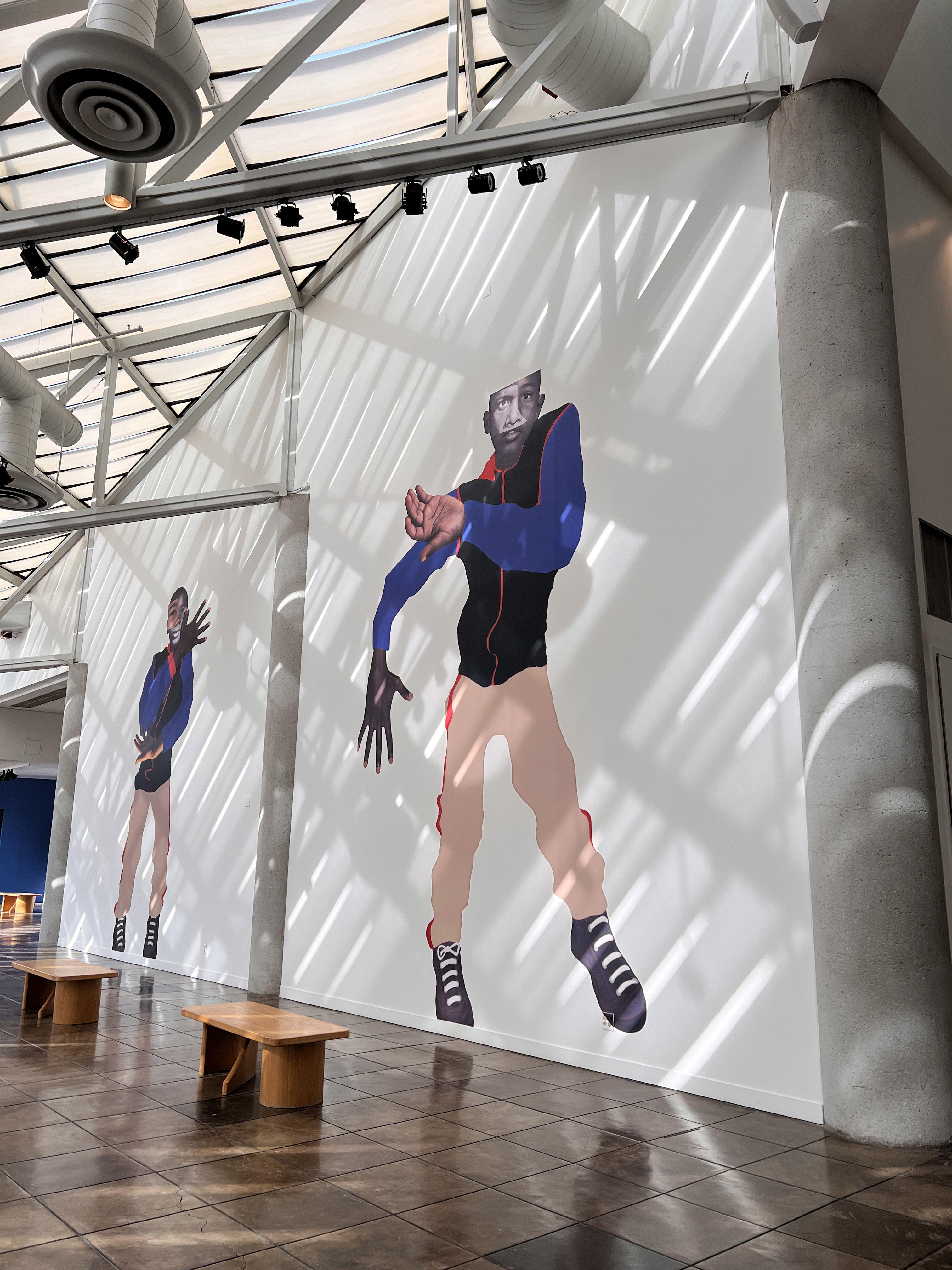 A mural, “Little Man,” by Deborah Roberts, is displayed in the foyer of the California African American Museum in Los Angeles, Calif., on May 15, 2022.
A mural, “Little Man,” by Deborah Roberts, is displayed in the foyer of the California African American Museum in Los Angeles, Calif., on May 15, 2022.
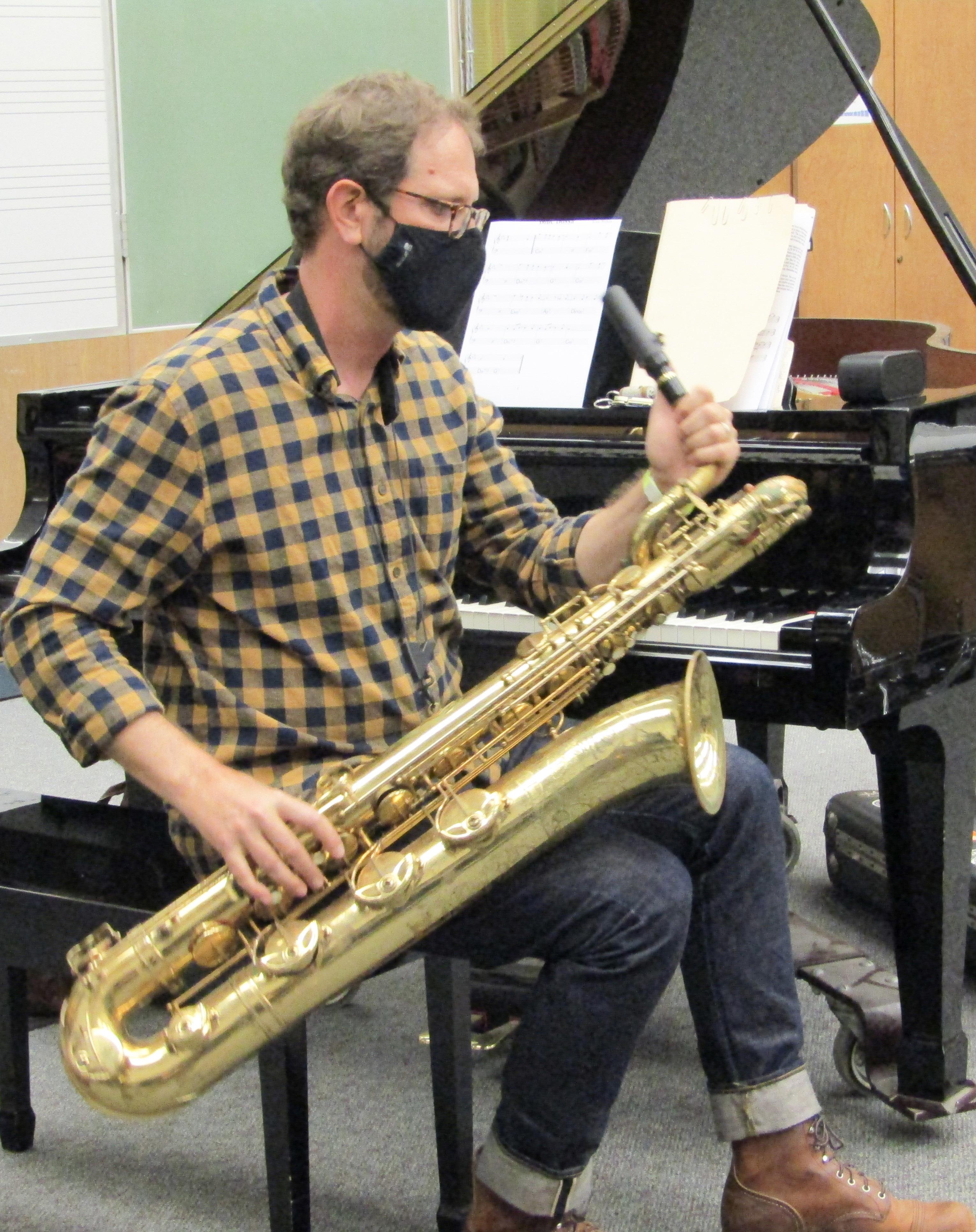 Professor David Moyer prepares to use his saxophone for his jazz improvisation performance classroom on Tuesday, April 19, in Marsee Auditorium at El Camino College.
Professor David Moyer prepares to use his saxophone for his jazz improvisation performance classroom on Tuesday, April 19, in Marsee Auditorium at El Camino College.
 Story and photos by Sharlisa Shabazz
The students blend their unique instruments together while Professor David Moyer joins them on Tuesday, April 19 in the jazz improv perfromance class in Marsee Auditoruim at El Camino College.
Story and photos by Sharlisa Shabazz
The students blend their unique instruments together while Professor David Moyer joins them on Tuesday, April 19 in the jazz improv perfromance class in Marsee Auditoruim at El Camino College.
The Haag Recital Hall in the Fine Arts Department is used to perform in the lower level of El Camino College's Music Building. This hall has various applied music classes, music ensembles and more. The capacity of the hall is 180 seats and it has tiered burgundy and silver seats.
Across from the seated students, the professor and guests sit in the recital hall. The Jazz Improv performers are getting prepared as the students are talking and playing instruments. The Recital Hall has a theatrical light and sound studio, and light booth. A grand piano, drums, microphone and Tyrolean bass violin sit next to the speaker on stage. The band rehearsals for the ECC Concert Jazz band and ECC Jazz ensemble take place in the Marsee Auditorium at the end of the semester.
The music director is a tall, slender man who is dressed in a navy blue button-up shirt with a green diamond shape pattern. David Moyer has a laid-back attitude. He has blue eyes and wears square spectacles with a leopard design. He completes his outfits by wearing dark blue pants, black and gray New Balance sneakers, and a cotton gray flat cap on this specific occasion. He has a ring on his left hand and his tone is assured.
“When I got a teaching call to come and teach at El Camino I was so over the moon about this opportunity..I love the fact that this is such a diverse place. It’s very comfortable for me because this is where I grew up. It feels like home. When I hear about former students really living in their potential, that’s a highlight,” David says.
David, 42, is a musical director and professor at El Camino, who is dedicated to his students and the music program. He goes above and beyond to ensure that they understand what needs to be done in order to progress to the next level. He reaches out to the students and his peers and students say he does an excellent job of promoting growth and music.
David went to the University of California, Los Angeles and University of Southern California. He received his Bachelor of Arts in music performance at UCLA. He also received a Master of Arts and Doctor of Musical Arts in jazz studies at USC.
He lives in Culver City with his wife Andrea Lee and his dog Luna.
It’s a lot of work behind the scenes that people tend to see. I think the big challenges. It’s just time, balance, being able to balance personal life, family life, music outside of teaching with teaching,” David says.
He began his musical career while growing up with his grandparents. When David was younger, he only listened to hip hop and jazz. His father and grandmother had a significant influence on him. David’s grandparents were both musicians and his father adored music. He wasn’t really fond of music. Until he went to Alexander Hamilton High School in Los Angeles, that’s when he joined the Music Academy and basketball was his main emphasis.
“I really fell in love with a great baritone saxophone player named Pepper Adams at an early age and spent a long time studying his music a lot. He started to realize that he’s actually pretty good at this,” he says.
His grandfather was a violinist, while his grandmother was a
pianist. They’d have fun together. His father is a huge music fan who has a record collection, goes on family road trips, prepares mixtapes, selects albums and records them on the set. In primary school, he was always interested in music. David was a fan of lateeighties and early-nineties music, particularly metal and hip-hop.
“I feel very fortunate to have great parents, older brother and grandparents that helped raise me and introduced me to music. I have good memories of my childhood. They were definitely challenging. It wasn’t easy all the time but it was pretty good,” David says.
David embraced his wonderful childhood as great memories, but life isn’t always perfect. Maintaining the passion for music during the pandemic has been extremely hard. David is excited to be on campus after a two year hiatus from teaching online and finally returning to teach in person.
“Before the Pandemic they did some off-campus gigs at the Lighthouse Cafe in Hermosa Beach. It was a lot of fun being able to make music after two years in person over wifi,” David says.
Returning to campus after the shutdown and being able to lead and perform with the band in person has been a thrill for David. Conducting jazz classes, teaching and concerts. He still encourages students.
“One of the biggest challenges is just balancing teaching my own music to practice” is staying motivated everyday. I’m reminded of the difference I’m making in people’s lives”, he says.
Students adore the fact that he educates them more about the history of jazz music, whic can be traced back to African roots and is fused with European influences in New Orleans, which like any other form of American music, has a strong African influence. He’s both supportive and educated, which are ideal characteristics for a learning environment.
“Work hard if someone is doing the same thing you’re doing the same instrument or whatever it is you’re doing and they’re working harder than you, so out work them, you have to work,” David says.
Lemar Gulliary is a former student from El Camino College. Lemar played the trombone and David played the saxophone when they were together in USC’s Thornton Jazz Orchestra and AfroLatin Jazz Ensemble, as well as in bands including John Beasley’s MONK’estra and Aloe Blacc. David received his MA in Jazz studies at USC in 2015.Their most recent collaboration was a horn passage orchestrated by Kamasi Washington for Florence & The Machine’s “High As Hope’’.
“He’s a cool dedicated professional, a great player and talented,” Lemar says.
El Camino College Grammy Award-winning professor David Moyer worked on Jimmy’s Cliff collaboration with Iggy Pop, a prominent punk singer, on his Grammy-winning 2012 album “Rebirth.” David is also a member of DD Horns (David and Danny) with Danny T. Levin with whom he recorded for Twenty One Pilots. He was nominated twice in the same year. DD Horns worked with mainstream artists like Snoop Dogg, Gwen Stefani, Mike Bloom and many more.
Danny and David have over 20 years of playing instruments and
"Hearing about former students that are pursuing their dream and living their potential. I feel like that really is an accomplishment.”
- David Moyer
knowing each other, since they were roommates at UCLA. They met in college in the late '90s where they both received a BA for music performance in 2002. David and Danny performed with the back up artist Baby Stone, daughter of Sly Stone.
“The music market is like a competition with other musicians and horn players strive to approach it as a team effort, as a casting call for a few festivals,” Danny says.
DD Horns has their music available for streaming on Bandcamp. Bandcamp is an online platform that allows musicians and artists to store, distribute and sell their music and merchandise. They were listed on Bandcamp’s monthly curated Best New Jazz in March 2017.
DD Horns has a list on their Bandcamp page. Their accomplishments were best new release of the month, radio station top ten and end of the year list radio played in the same year on KMDH radio station in Oregon, DD Horn’s first record recognition. Best New release of the month. The radio station KMDH in Oregon played in the top ten end of the year list in 2017.
‘‘As a person in music and close friend he’s very committed to his ideals and to doing things the way he does them, his views on music and jazz and how stuff should be done and is passionate about this stuff. He’s hilarious with a sense of humor and seeing eye to eye musically. He’s a good listener and able to read and react with good instinct,” Danny says.
David and Danny have a gift of effortlessly connecting music. They become an unstoppable force when they strive to add distinctive sounds and play with their instruments. DD Horns partnerships, on the other hand, have the potential to sustain instruments well together. They have a natural musical relationship that allows them to make sounds.
Professor David Moyer writing music notes on the whiteboard on Tuesday, April 19 in class in Marsee Auditorium at El Camino College.

“I feel like it's a lot of students have gone on to college and some of the students I taught are now in the professional world. Hearing about former students that are pursuing their dream and living their potential. I feel like that really is an accomplishment,” David says.
For more information on DD Horns, visit https://ddhorns. bandcamp.com/releases.
Profesor David Moyer and students practice during class Tuesday, April 19 at Marsee Auditorium at El Camino College.

 Kori Park, music student, played an alto saxophone and performed the song ‘Voyage" by Kenny Baronhis in the Haag Recitial Hall at El Camino College on Tuesday, April 5.
Kori Park, music student, played an alto saxophone and performed the song ‘Voyage" by Kenny Baronhis in the Haag Recitial Hall at El Camino College on Tuesday, April 5.
Longing for a place of educational prowess and services to satisfy your mind’s hunger? Look no further than these top five libraries that serve the El Camino College community.
Knowledge is power, and the hundreds of millions of students all across the world know this better than anyone else. With bookstores being quite pricey, they don’t compare to the services provided by libraries that are just one membership card away from giving you what you need. This is Warrior Life’s list of the top five libraries in the surrounding areas of El Camino College that are sure to save you lots in both time and money.
It is a library’s duty to serve its community, but Lawndale Library goes above and beyond to ensure every visitor has a great experience. Research assistance is available throughout the day for students who want to succeed on their research papers, but need a guiding light. They provide audiobooks, ebooks, music and even PDF versions of newspaper articles from select papers. You can also book a meeting room to get together with other students for study groups.
Address: 14615 Burin Ave., Lawndale Phone: 310-676-0177
Hours: Tuesday-Wednesday: Noon-8 p.m. Thursday-Saturday: 10 a.m. to 6 p.m. Monday-Sunday: Closed https://lacountylibrary.org/lawndale-library/

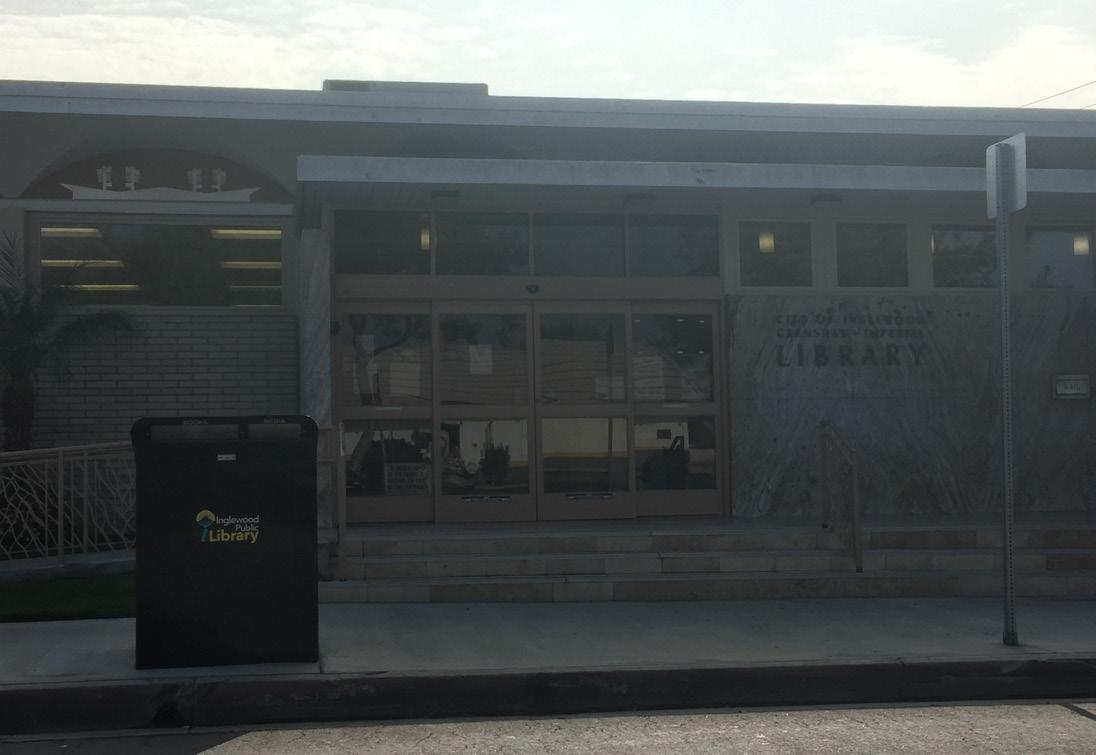
With a wide variety of resources ranging from free programming and classes, this library does not hold back on providing for those looking to move forward in their educational careers. All it takes is an Inglewood Public Library card for you to access the e-resources they provide, which include, but are not limited to, articles and movies. They also offer unique services to teens and children, so bring your siblings too!
Address:11141 Crenshaw Blvd., Inglewood Phone: 310-412-5403
Hours: Monday-Thursday: 11 a.m. to 6 p.m.
Friday: Closed Saturday: 10 a.m. to 6 p.m. Sunday: Closed
Website: https://www.cityofinglewood.org/1400/CrenshawImperial-Branch-Library
Lawndale Library’s hours are varied due to it being a smaller library. It’s located less than two miles from El Camino College. Crenshaw-Imperial Library opens later than most during the week and is closed Fridays and Sundays. It’s located less than four miles from El Camino College.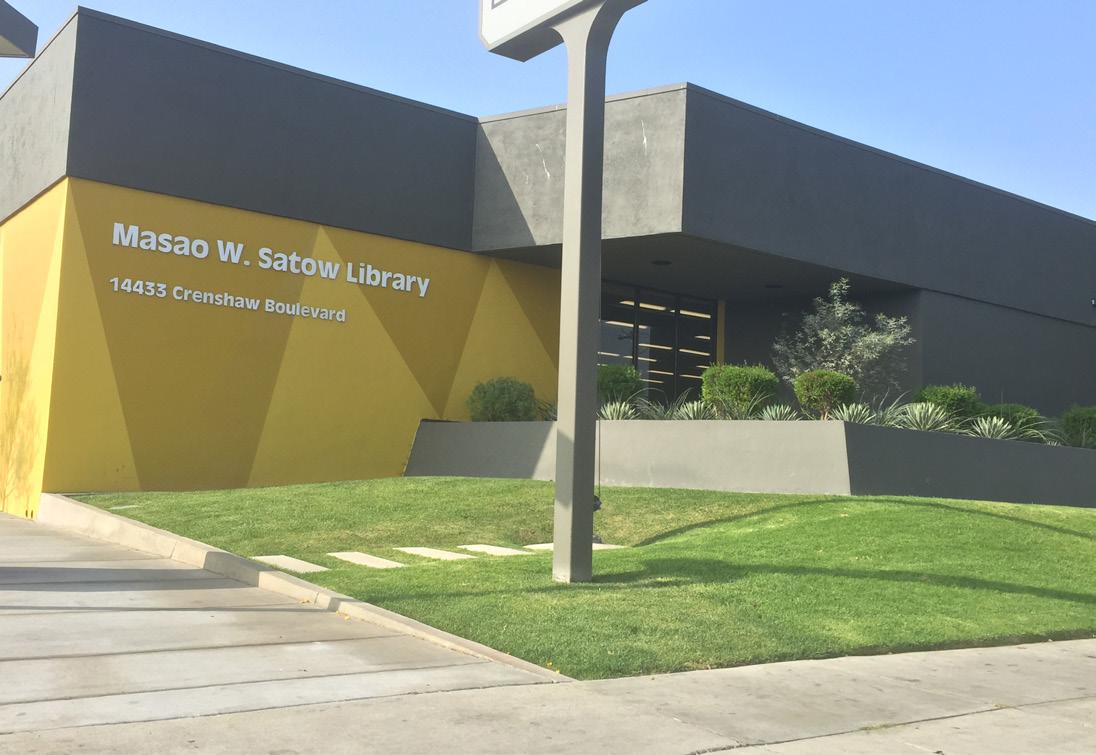
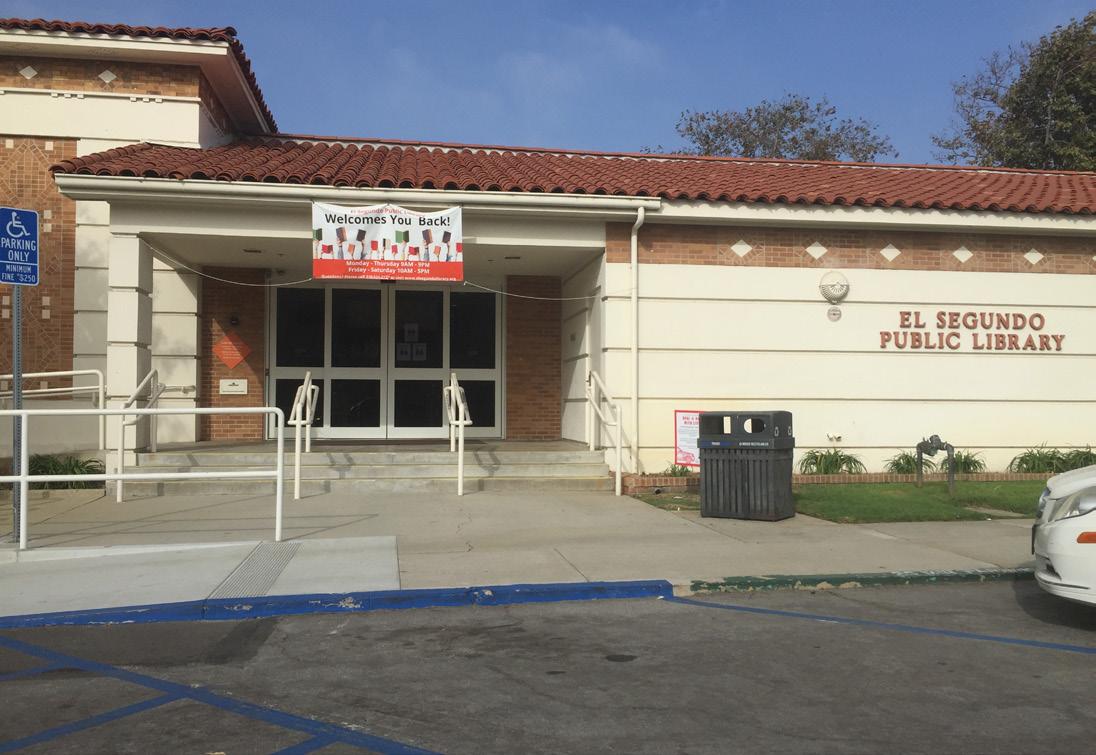
The furthest from El Camino College on the list, it is still very much worth checking out. With more extensive hours than the rest, this makes for a great location for those who have a hard time finding time due to work or any other barriers. They have a great selection of books and even have a page on their website dedicated to suggestions from cardholders for books to acquire. It is also just a walk away from El Segundo Park, a great place to sit down and read.
Address: 111 W. Mariposa Ave., El Segundo Phone: 310-524-2722
Hours: Monday-Thursday: 9 a.m. to 9 p.m. Friday-Saturday: 10 a.m. to 5 p.m. Sunday: Closed
Website: https://library.elsegundo.org/
The closest to El Camino College from the five libraries, this location makes for a great quick stop before or after a class if time is an issue. It provides solid hours for students who are in desperate need of its services or those who could not find what they were looking for in the college library. With many computers ready to go throughout the facility, wait times are almost nonexistent, and tech-savvy employees provide great support to those unfamiliar with certain applications.
Address: 14433 Crenshaw Blvd., Gardena Phone: 310-679-0638
Hours: Monday-Thursday: 10 a.m. to 8 p.m. Friday-Saturday: 10 a.m. to 6 p.m. Sunday: Closed
Website: https://lacountylibrary.org/masao-w-satow-library/
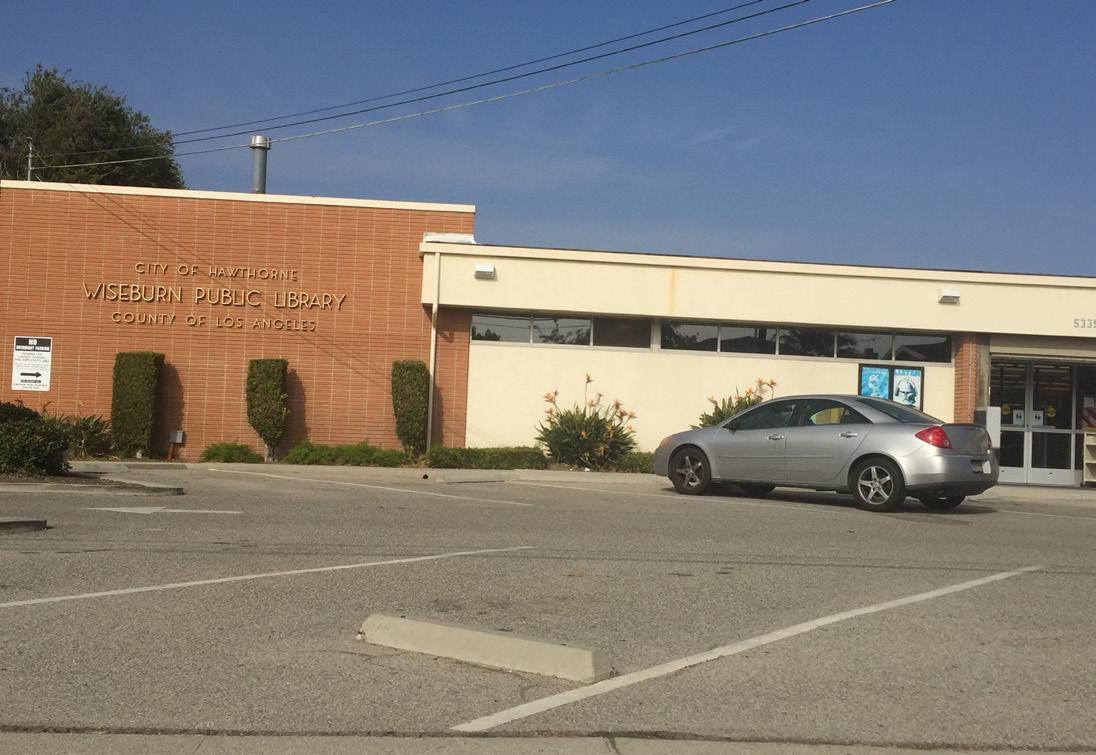
One of the smaller libraries on the list, Wiseburn still holds its own for being a good place to study and do research. It has all the basics of a standard library, but what sets it apart is the availability of the books they have. If you somehow are not able to find one you need, you can immediately reserve it once it is returned. There are also a selection of toys for kids and other activities, so Warriors with young children can fulfill their needs while their kids fulfill theirs.
Address: 5335 W. 135th St., Hawthorne Phone: 310-643-8880
Hours: Tuesday-Wednesday: Noon-8 p.m. Thursday-Saturday: 10 a.m. to 6 p.m. Monday-Sunday: Closed
Website: https://lacountylibrary.org/wiseburn-library/
ElIt was as if I just gained a day of my life back.
By grace of the Earth’s longitudes, the 16-hour flight had nearly no effect on my perception of time. Los Angeles was ahead of the Philippines by 15 hours, after all.

And yet, the telltale sign of my ascent from across the globe made itself known to me by touch. The bellowing air felt crisp against my arm, compared to the clammy humidity in my homeland.
My mom and sister dragged their luggage across the streets from the Los Angeles International Airport, excited and ready to build their lives anew.
And then we sat at a fast food restaurant I had never tried before. The already bland french fries started to lose flavor even more in my mouth.
It fully sinks in how different my life would be from that day
forward – then I cried at In-N-Out.
Back in the Philippines, food would always bring our families together.
Under the mango trees and bougainvilleas that my grandma planted, and on the bamboo tables and chairs that my grandpa created with his bare hands that are well acquainted with carpentry.
No one would dare miss a meal shared with all my aunts, uncles, cousins and even our entire neighborhood, especially when it’s a Despedida for my mom, sister and I’s departure.
“Fatten yourself up there, alright?” my aunt would tell me in Tagalog.
Even through food-related verbal maxims, my family’s reminders to take care of myself when we moved to California
would still find their way to my memories across our family’s 7,000-mile dining table, even four years later.
February 14, around 7 p.m., my dad had just picked me up from a theater rehearsal at my high school in Harbor City.
Grabbing food to eat before heading home was a no-brainer. My sister and I settled next to each other at a Vietnamese restaurant and immediately dug into our Phở to warm ourselves up during the winter day.
Dad sat across from us, snapping a picture and calling us “My dates for today” in his Facebook post. The realization slowly dawns on me that we have never spent time with dad as much as I did the past two years being in the U.S.
My dad came to the U.S. in 2008, a few months before my little sister was born. Like most immigrants’ reasons would be, it was for work, the opportunity to better our lives.
He would visit home again at least every three years. And at the time, I thought those short vacations with him and Skype calls were enough. Yet after 10 years of being apart, my entire family finally get to be together for good.
Such experience taught me how valuable those moments of physically spending time with each other are.
More than anything, I grew aware of the importance of togetherness even more when my grandpa passed away.
It was 2019, barely even a year since we moved to the U.S. and my family already had to fly back home for his funeral.
I was sitting in a history class, chewing bubblegum when dad texted that my grandpa had passed. Making an excuse to my teacher that I’ll just spit the gum out, I really just spent 5 minutes outside, absorbing the message.
On another 16-hour flight, this time on the way back to my hometown, the memories of when Lolo and I saw each other in person came vividly.
Him, sitting in the car that brought us to the airport, putting on his tinted sunglasses when we were bidding goodbyes. Me, my warped reflection from the black glossed lenses, realizing my grandpa did it to hide his impending tears.
Looking down from somewhere atop Olongapo City, more gentrified than I’ve ever seen it despite only being gone for less than a year, the urbanized town bustles beneath as if time waits for no one.
And it was true. Seeing how many changes occurred in my homeland in such a short amount of time made me realize how many things have changed in my life, too. And these changes were necessary as I grow and navigate a new life.
The American Psychological Association describes this acculturation as a “process that involves changes in many aspects of immigrants’ lives, including language, cultural identity, attitudes and values, types of food and music preferred, media use, ethnic pride, ethnic social relations, cultural familiarity and social customs.”
Having experienced it in different ways, I walk forward knowing that there are now two places I can call home.
d resources such as the Asian Mental Health Collective exist to support our communities who have gone through the same.
If an immigrant finds themselves needing immediate help, the Immigrants Rising’s Mental Health Connector provides immigrants and undocumented young people with free psychological support by texting HOME to 741741 or calling 1-800-273-8255.
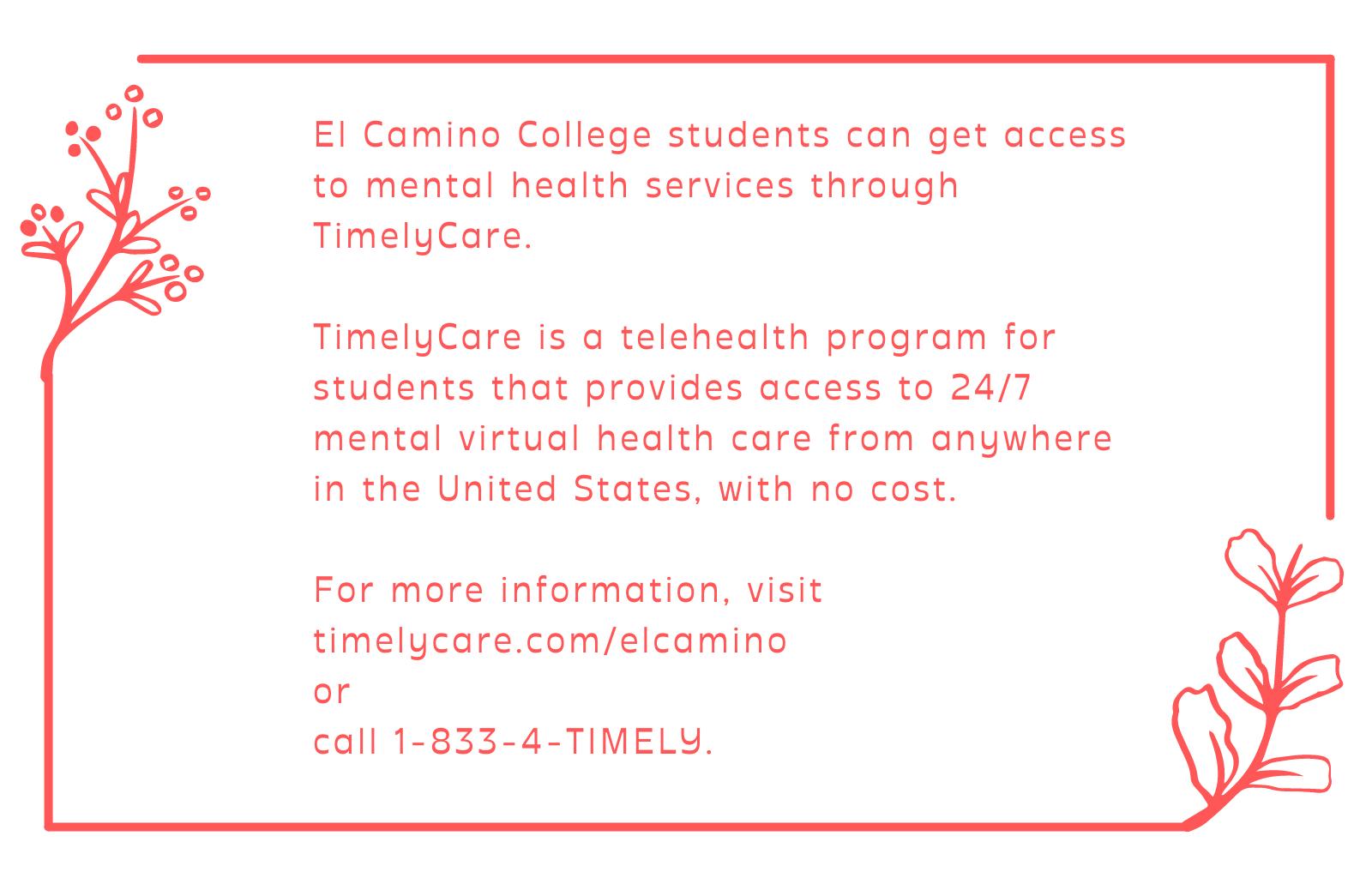
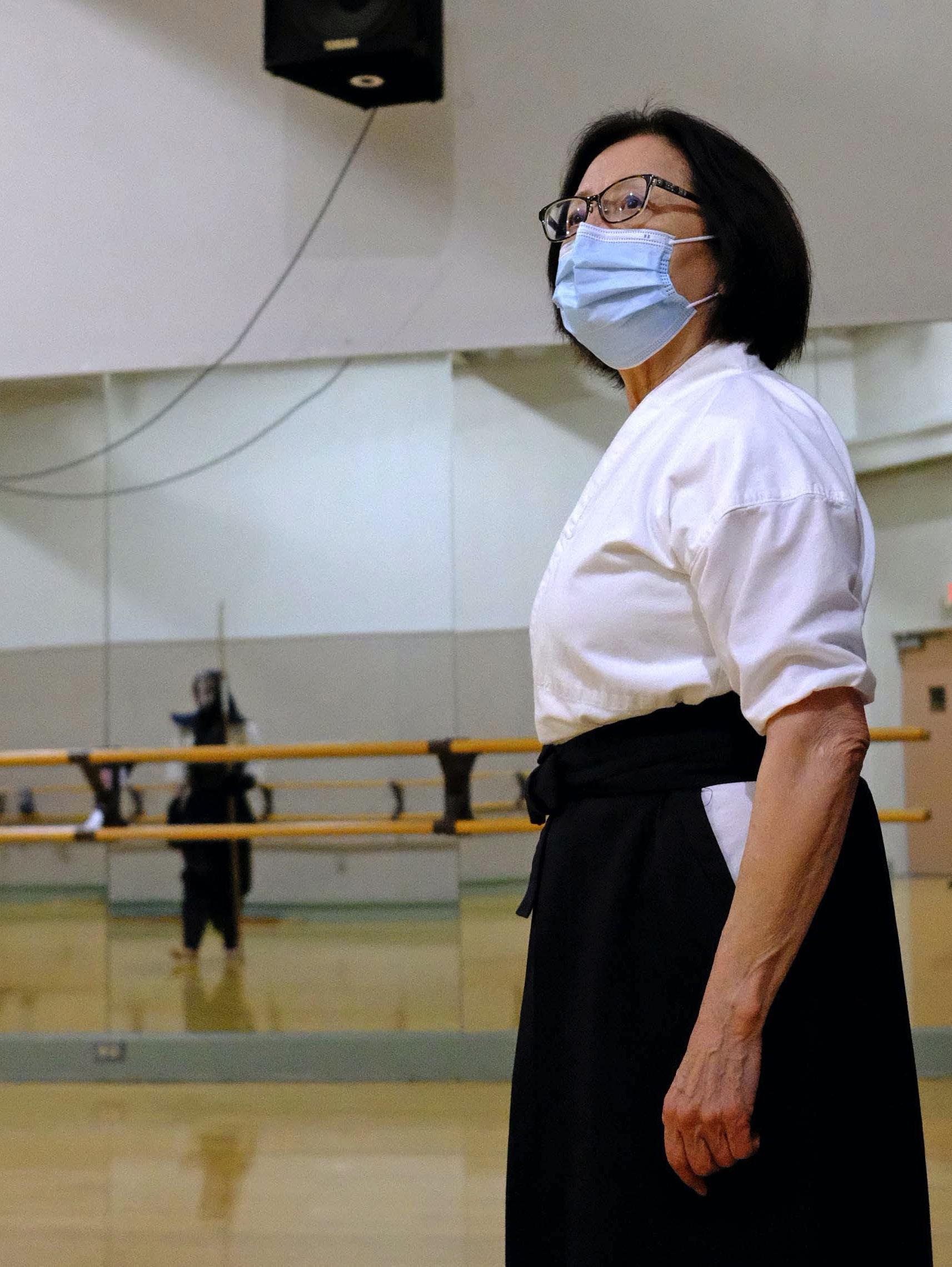
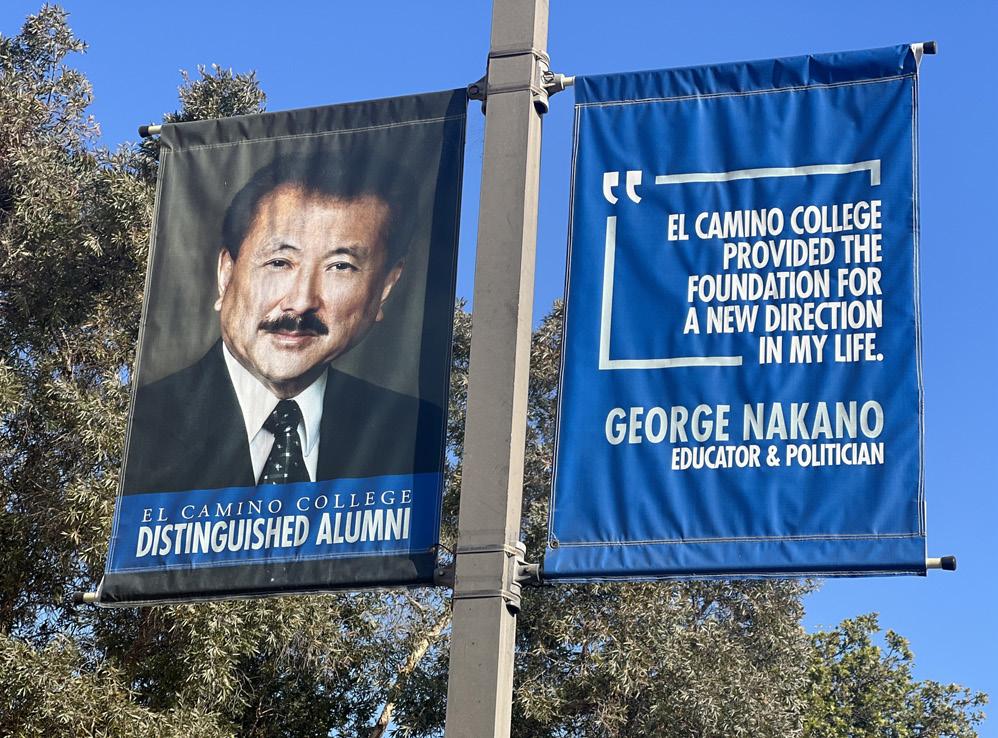
Prior to visiting Japan in 1966, Helen Nakano did not expect her naginata spirit to bloom so quickly; she now owns four dojos and is the sensei of El Camino College's naginata course, which continues to remain as the only college-accredited course in the USA.
Story by Safia Ahmed Photos by Jose Tobar and Safia AhmedHelen Nakkano is an 82 year old businesswoman who has been a resident of Torrance for nearly 55 years. She is a sensei to the Naginata class at El Camino College but due to restrictions, the class has not been able to start back up.
Helen has been practicing naginata since 1966. She was the firstever teacher to start a naginata class in America.
“When I first started naginata there were no teachers so we had to learn from a kendo teacher,” Helen says.
It was unheard of at the time and there were no naginata teachers. She went to Japan with her husband George in 1966. Her husband does kendo and he was part of the US kendo team representing the US in a worldwide tournament that was held in Okinawa.
George is a former California State Assemblyman and was one of the first minority elected for Torrance City Council. He is an El Camino college alumni and served as president on the El Camino College Foundation Board of Directors in 2010.
“I met some naginata teachers that happened to be in Tokyo at another dojo where the kendo people were practicing and they saw me sitting on the sideline taking pictures of the kendo practice and they came over and asked me if I’d like to try naginata. At the time I really didn’t have an interest and I just told them I was going to be taking pictures but they were really persistent,” Helen says.
She was then taken to a dressing room where she dressed up in a white hakama and a white gi. Normally the hakama, the bottom, is usually in a navy blue or black color. Kendo practicers and martial artists use the same hakama.
She developed an interest along with another woman, Nadine Ishitani Hata. They both learned naginata together and started a class with Mori sensei in Los Angeles. Nadine Hata was the vice president of Academic Affairs at El Camino College. Unfortunately, Nadine died in 2005 as a result of cancer. The LA Times reported that Nadine” influenced change not only through her teaching and writing, but also through her work on a state advisory committee to the US Commission on Civil Rights,as chairwoman of the State Historical Resources Commission, and as the only Asian
American on the American Historical Association’s 12-member governing council.”Helen remembers Nadine fondly and the work they had gone through to establish a class at El Camino which remarkably turned out to be the only college accredited naginata course in America.
“Without her, there would not have been naginata at El Camino. I taught in the summer of 1997. It’s as a result of Dr. Nadine Hata. She is the reason I’m able to teach there. She worked really hard to get this class an accredited class ther,” Helen says.
Following their journey to Japan, where they learned more about naginata, they returned to practice with Mori sensei, a famaous naginata sensei in Los Angeles. Helen stated that she has been practicing naginata since 1966.
“[Nadine and I] gradually evolved into becoming the instructor. We’ve had teachers visiting from Japan, annually. And we would teach what we were taught by the teachers from Japan. Probably in late 1966. So by 1970 or 1971, we were teaching, whether we were qualified teachers or not we were teaching what we learned. We were fortunate, we had some excellent teachers that came from Japan that taught us and we also went to Japan to learn so we felt very fortunate,” says Helen.
Naginata is a budo, which is not a combative art; yet, there is a deeper significance to forming a person’s character with naginata. It has a competitive component to it. Kendo, Judo, Sumo, Aikido, Kyudo, Karatedo, etiquette (reigi in Japanese), humility, honor,compassion, and self-discipline are extremely important, Helen says.
Helen tried to focus less on the sporting aspect of naginata and emphasize more on the characterbuilding aspect of naginata.
“I really love the art form, it made me a better person,” Helen says.
She’s had a number of dojo through the years. She currently owns 4 dojos in Southern California. She also runs dojos in Phoenix, Arizona, and Lincoln, Nebraska. Counting her El Camino class as a bonus.
“I was teaching at ECC up until the Spring of 2020. Because of the pandemic we were shut down and we haven’t been able to start
again,” Helen says.
There was no naginata being taught in 1966. In 1974 she was one of the founding members of the US Naginata Federation.
“At that time. I didn’t have a choice really, I would have preferred being a student all these years, it’s wonderful to continue to, to learn, and taking on the responsibility of being a teacher just happened because there were so very few of us doing it,” Helen says.
In order to keep naginata alive, there needed to be teachers. Helen enjoyed taking the role of a teacher and keeping the spirit of naginata alive.
Kevin Saxton, a former member of the Torrance Naginata Club and E student was practicing kendo in Southern California and went to Canada where he first encountered a demonstration of naginata.
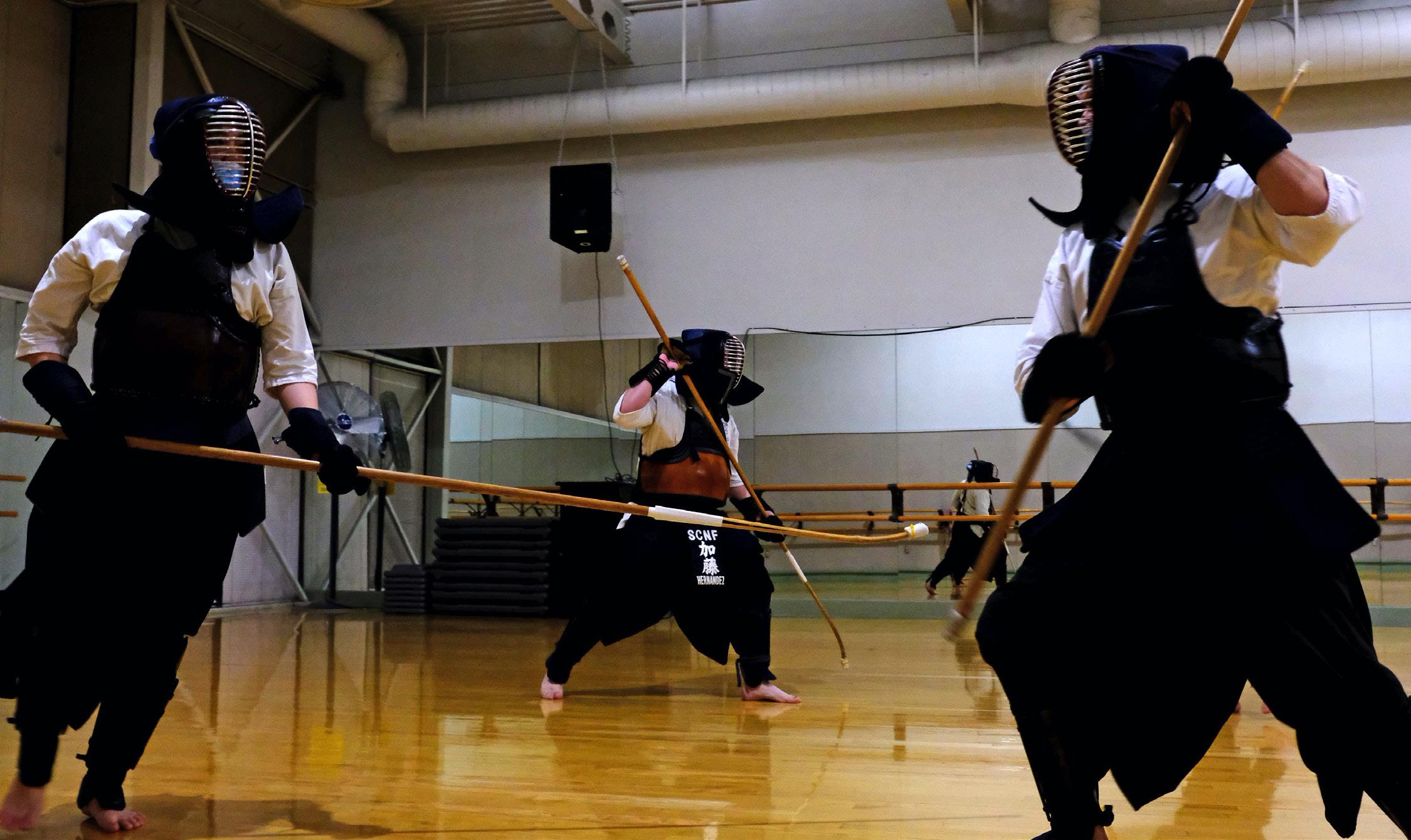
Kevin (51) currently resides in Lakewood, California, and works as an IT administrator for LA country, he is also an instructor for the Irvine dojo.
“The demonstration really interested me,” Kevin says.
Kevin had started naginata in 1990. The thing that piqued his interest was the way naginata can be so grateful.
“The effective use of both sides of your body that with the way that the weapon is used. I felt like by practicing [naginata] it would make my kendo better,” Kevin says.
He had taken a class with a room full of women which he had seen as an equal opportunity.
“Being bigger and stronger is often more of a detriment than a benefit. The most challenging thing would be learning to try to learn to accept that as a man, I can’t move like a woman but I tried to execute the form gracefully,” Kevin says Kevin says the greatest challenge for him was balancing his martial training with the rest of his life.
By learning to use this weapon Kevin has learned how to be graceful, to accept things in life that can’t change, and to deal with challenges in life.
“There’s an old Japanese warrior saying that enlightenment is found at the tip of the sword. And basically what that means is when you find somebody all of the things that we often think are so important in life, being cool, being rich, good looking, all that goes right out the window. When I find somebody, I get to find out who they are in their heart,” Kevin says.
“Practicing with this weapon, helped me become a better man. a better father, a better employee a better citizen,” Kevin says.
Kevin describes Helen as a patient and insightful person who is demanding of character.
“She looks for the best in you. I know that the good qualities of good qualities of a leader are by your own actions and your own
Members of the Torrance Naginata Club perform ji-geiko, a free sparring practice at the Torrance Cultural Arts Center on Thursday, Oct. 21. (Jose Tobar | Warrior Life)"There's an old Japanese warrior saying that enlightenment is found at the tip of the sword. When I find somebody, I get to find out who they are in their heart."
- Kevin Saxton former student and naginata club member
demeanor that you inspire those below you and around you to be better. And she definitely has that quality,” Kevin says.
Kevin has tried to emulate Helen’s qualities as a teacher such as being patient, understanding, and demanding of his students. Through emulating her qualities he has noticed how that has improved his career as a teacher and when he was the US coach for the world team.
“Nakano sensei exudes wisdom and confidence and an air of respect. So I think that by taking her class, a student who maybe has never picked up a weapon, would never have to face really faced something and confront something, it can be quite fearful to face another person with a weapon,” Kevin says.
Having such a tool and being provided with an environment in which to practice it securely and with direction are things that Kevin believes will benefit someone with competence for the rest of their life.
“It’s kind of a wonderful experience to see people being able to improve in this beautiful art, some very elegant and powerful art form,” Helen says.
The greatest challenge Helen faced was the lack of teachers. Helen mentioned that there are so many different levels of students.
“You have a total beginner and then somebody that is more an intermediate student. Then you have your more advanced students and it’s trying to keep all of them engaged on the floor at the same time, “ Helen says.
Helen faced an obstacle being the only instructor for a naginata course. However, she took that as an opportunity to teach all levels and keep them interested and spirited with the art.

Helen says that practicing naginata at the dojo was tough for new students because they were trying to learn all of the basic
movements, including footwork, not only how to use their naginata, but also how to read, move their feet, and move their bodies with a weapon.
“I would continue and encourage them, I didn’t want to see them get discouraged. I try to keep the beginner students focused,” Helen says.
Juan Hernandez (49) is a software engineer who works for Raytheon, an aerospace company, and lives in Long Beach where he has been studying naginata since 2006. He heard about naginata through a newspaper article in the Long Beach paper, PressTelegram.
“There was a big article in the sports section and they were doing a training session at Long beach state so I read about it and thought the martial arts was really interesting,” Juan says.
He serves as the assistant instructor in the class and carries the role of a sensei to the class. However, respect is given to the higher rank regardless of the term they are addressed with.
“It’s incumbent upon us to know what the hierarchy is. Helen is the head instructor so we got to give her respect in her rank,” Juan says.
When lining up, the sequence is ordered from the highest to the lowest rank.
“It’s a Japanese thing where it’s expected for individuals to know the pecking order. When we’re lining up it’s expected to know the highest rank goes on the left then it files down to the lowest rank down,” Juan says.
“The thing this martial arts really emphasizes is respect. Selfrespect for yourself and respect for others,” Juan says.
Helen says naginata has high regard for fellow practitioners. Particularly when performing on stage Helen had done her best
Two Naginataka, or naginata practitioners, Grace Wu, left and Tony Smith, right, practice their katas, a series of exercises performed in sequence used to perfect their martial arts techniques at the Torrance Cultural Arts Center on Thursday, Oct. 21. (Jose Tobar | Warrior Life)to practice naginata amid the pandemic. She learned how to hold classes virtually through zoom. She would practice alone in her backyard and the students would practice in their yards or homes.
“Because the weapon is such a long weapon it would be difficult to move the weapon inside of the house unless you have very tall ceilings. But I have a student or two that was able to actually do it inside, which was wonderful. I held class once a week on Thursdays, just as we would here normally at the Torrance dojo and it went quite well,” Helen says.
Helen describes the two elements of naginata. The atarashi (new) naginata is one example. The naginata is fashioned of oak coal and has a bamboo tip. The blade is constructed of two bamboo strips bound together by a leather pano. It stands roughly 7 feet 4 inches tall. It is a weapon that can be wielded with both hands.
The students started practicing in Torrance in midApril of this year as the pandemic began to fade. Helen had three students when they opened. After a few weeks followed the numbers increased.
Helen is unable to teach her class at ECC at the time. She taught her last class in the Spring of 2020.
The dean informed her that she would most likely not be able to teach next term.
“I really miss teaching at El Camino College because I love the excitement and the enthusiasm with the new students that beginner students when they start taking my class there. And I’m hoping I can continue teaching despite my age. I’m still physically able to do most moves,” Helen says.
Helen says that her greatest concern about the pandemic is personal safety. When she was with family they would sit in the backyard and would keep their distance as a means to prevent exposing anyone.
“We didn’t want to get it and we didn’t want to spread it.,” Helen
says.
All of her family members were vaccinated as soon as the vaccine was released. Even in the dojo, the vast majority of them have been vaccinated.
“We’ve come to the point where everyone in the dojo is going to have to be vaccinated in order to practice,” Helen says.
Helen adds that another challenge practicing the ancient combat in the pandemic was the disadvantage of using voices. When practicing naginata a key element is Kiai or Chi which is the act of using their voices to yell the name of the cut they are practicing.

The only person allowed to shout was the instructor, other than that no one else was permitted to yell.
“We all want to go back to normalcy again but I don’t know when that’s going to be possible. But I feel the feelings of my students of wanting to get together wanting to be able to practice this beautiful art together and continue to learn,” Helen says.
The students inspire Helen to continue practicing the art of naginata. Although it is difficult for beginner students to learn from
"It's very difficult to sometimes explain the feelings that go into doing this art form. But it's very powerful."
- Helen NakanoMembers of the Torrance Naginata Club lined up in the dojo with Helen in the center on Thursday, Oct 21 at the Torrance Cultural Arts Center. (Jose Tobar | Warrior Life)
scratch, the more competitive they become the more enthusiasm and joy grows within them.
“It’s very difficult to sometimes explain the feelings that go into doing this art form. But it’s very powerful,” Helen says.
Helen is a member of an international organization. They used to gather every year, but due to the pandemic, they haven’t been able to do so. The most recent encounter took place in Germany in 2019, at the world championship.
“I’ve seen how Naginata has grown in all these years,” Helen says.
The International Naginata Federation started back in 1990. Helen has been involved since the beginning of the International Naginata Federation.
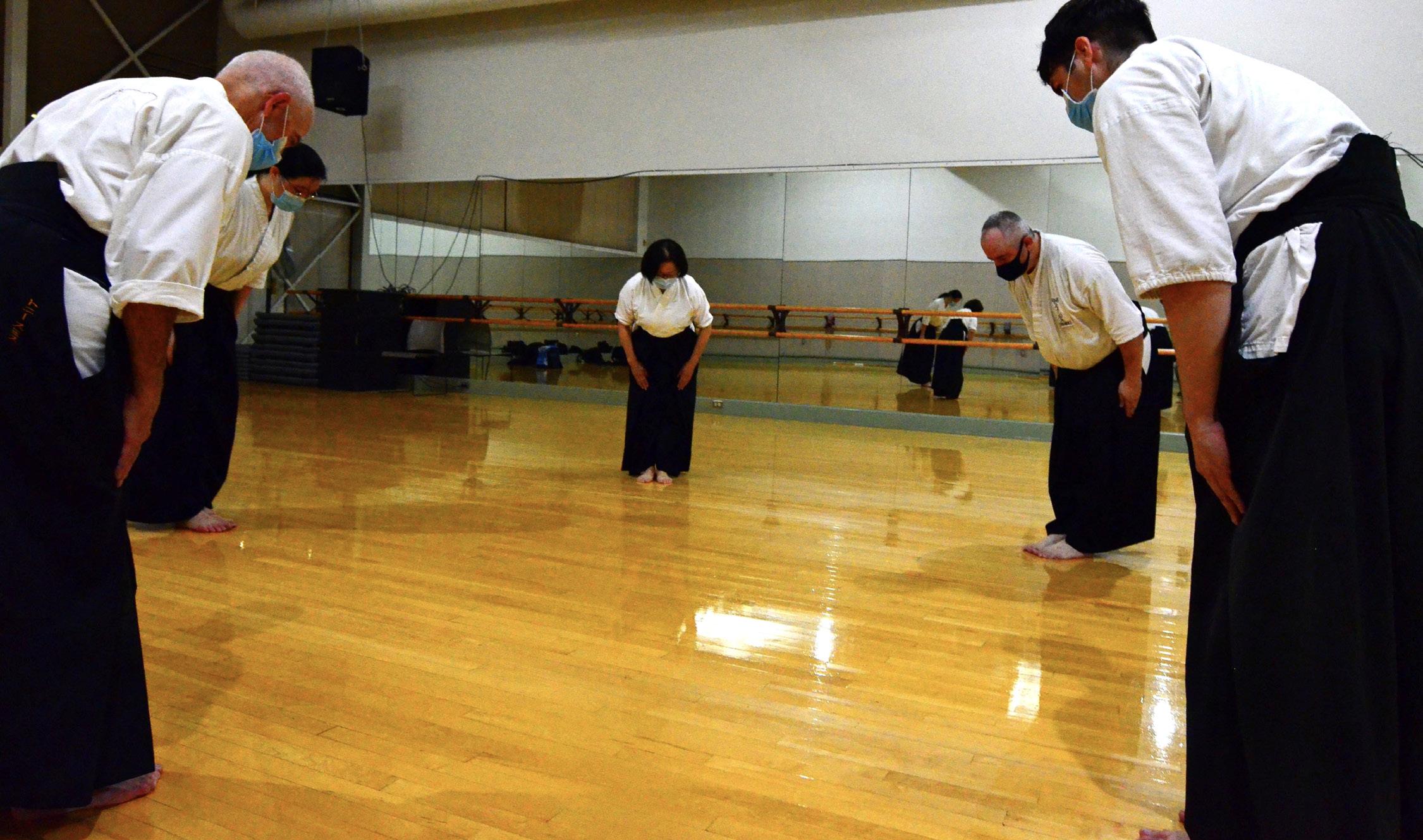
“The next championship for the world is supposed to be in the United States in 2023. But because of the pandemic, we’re not sure if that is going to happen,” Helen says.
Helen and her husband George were awarded the Rising Sun, Gold Rays with Rosette medal from the Emperor of Japan himself. Helen had gone to Japan to accept her award.
“We’re so honored to have been recognized to receive the award. George had received his award when he turned 70 and then I received mine when I turned 70, as well,” Helen says.
Helen says if she was unable to teach she would miss it. It has become part of her life now, something she has been doing for more than a number of decades.
“I feel blessed that I’m able to physically go out on the floor and continue teaching I have not come to the point yet for I felt like I could not teach,” Helen says.
Helen has taught students internationally. She mentioned that she’s had students outside of ECC contact her.
“I have started naginata schools in Lincoln, Nebraska and then in Phoenix, Arizona, and actually in Tallahassee, Florida. So I’ve flown to different states personally, to teach by invitation,” Helen says.
Helen has taught naginata in South America. She has been to Italy to teach by invitation. Despite her teaching experience in other countries, Helen preferred to stay in California. “Torrance is my home. I’ve lived in Torrance, California since 1965 part of that was in Manhattan Beach. But when I teach in other countries or in other states, it’s by invitation usually, and I will go in and teach a seminar,” Helen says.
Helen discussed how there is a common assumption among people that instructors who teach naginata or kendo are paid, but they are not. When she travels to a different country she travels at her own expense.
“I am not paid to teach. I do not take any payment for teach ing. The only place I am paid to teach is at El Camino but when I teach in other counties or other states or here in California, I do not charge a fee for teaching. I teach because I love the art, I love it and I want to spread it,” Helen says.
Helen enjoys going out for lunches and attending family gather ings in her free time. She does not consider naginata a hobby rather she considers it an art form. She is very fortunate that a majority of her students are now teaching in their own dojos. She feels very gratified that they’ll carry on after her.
“I would like to continue doing what I’m doing and hopefully we’re able to get through this pandemic and I can continue teach ing. I really miss getting together and being together in a dojo together and practicing without masks. I hope sometime in the near future we're able to do that again,” Helen says.
As the class session ends just past 9:30 p.m. at the Torrance Cultural Arts Center where Helen Nakano teaches a Japanese art of self-defense known as Naginata, Nakano and her students bow towards each other as a sign of respect. (Jose Tobar | Warrior Life)
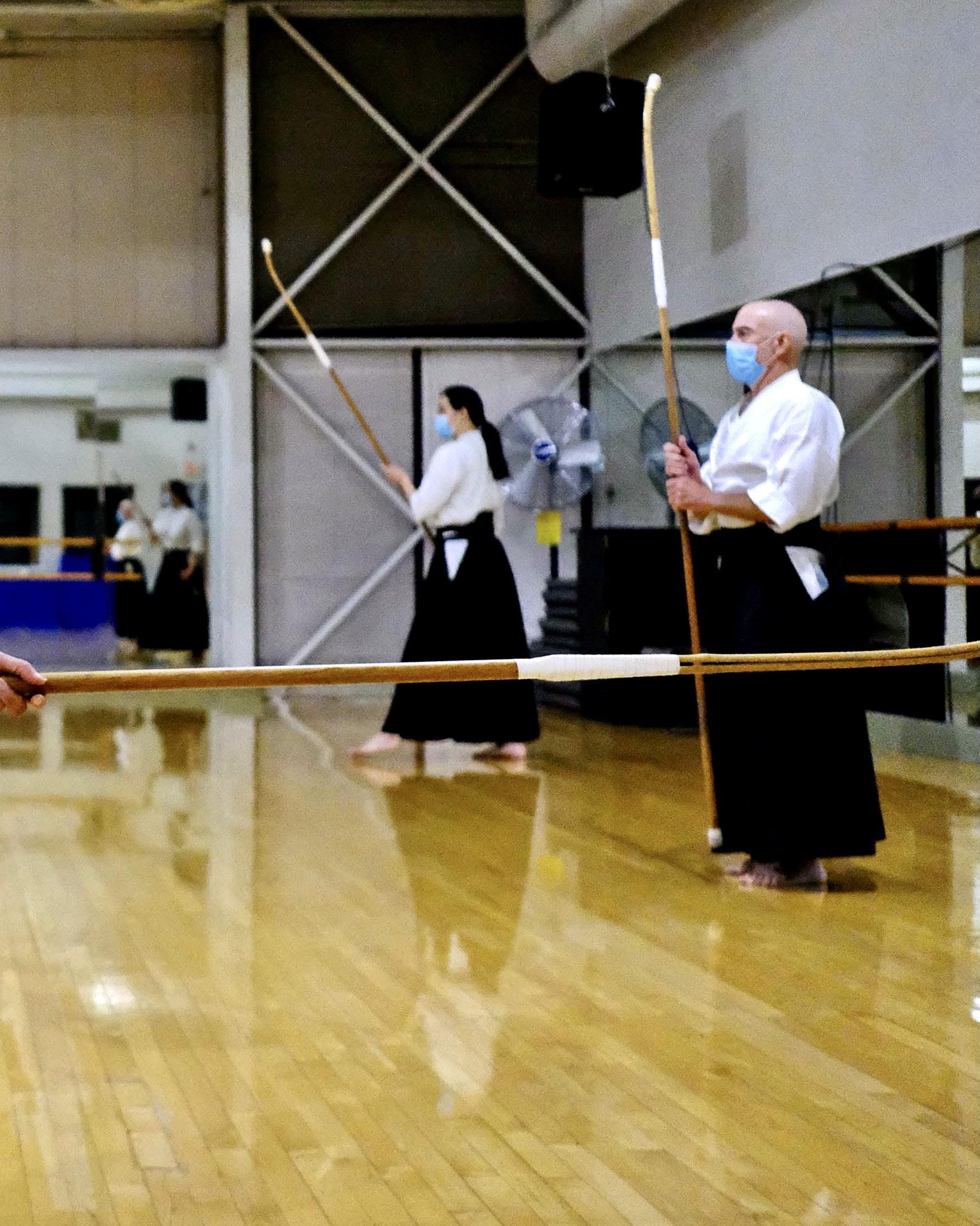
Chicken wings might be America’s favorite finger food.
Wings go well with beer or root beer, is a crowd magnet at birthday parties and tailgate parties, will also appeal to all political parties, can come in a variety of flavors and dipping sauces, and is politically correct served bone-in or boneless. Here are five independent eateries near El Camino College that will satisfy your wings cravings and have you flying back for more.
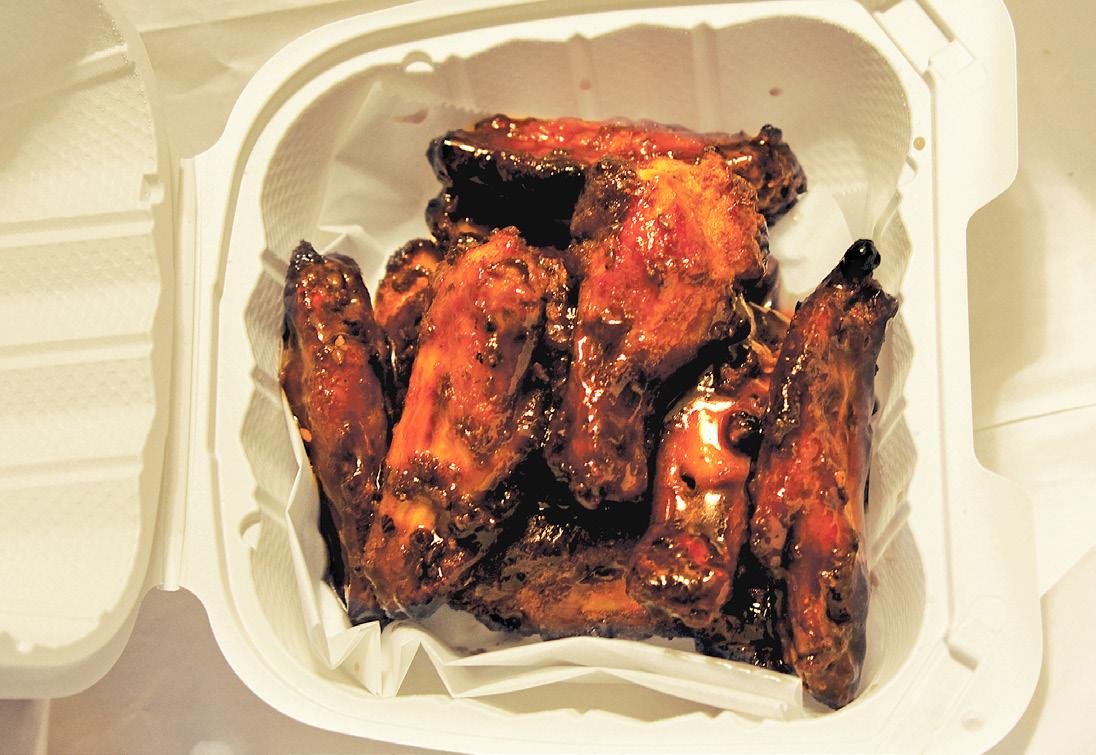
This single-owner pizzeria is known for its New York-style pizza pies. But for the adventurous, Gigi’s also dishes out meatball sliders, torpedoes, antipasto salad, cheese garlic bread, giant chocolate chip cookies and — chicken wings.
Eight flavorful wings are prepared with your choice of Frank’s buffalo sauce, hot buffalo, barbecue, garlic parmesan, teriyaki, Korean sauce or mango habanero, and served with ranch or bleu cheese dressing. Eight pieces for $8.99.
Address: 16006 Crenshaw Blvd., Gardena Phone: 310-327-0355
Hours: Monday-Saturday: 10 a.m. to 8:45 p.m. Sunday: Closed
Gigi’s might be known for its Italian food, but don’t discount its variety of chicken wings offerings, such as the teriyaki seasoning as shown. The wings provide a tasty alternative to Gigi’s Italian dishes.

Website: https://www.gigispizzagardena.com/
No messing around, this is a serious chicken wings restaurant. At the top of its heat list are flavors Wing Ferno and Walking Dead. Home of the Nashville chicken wings, with wings prepared in 15 different flavors. This restaurant also serves chicken sandwiches, tenders, an assortment of fries, onion rings, salad and tater tots.
You want beer? They serve beer — draft, domestic and imported. Inferno has good indoor ambiance and two TVs that place it in the sports bar category. Only two locations for now: Gardena and Orange. Everything is on the steeper side in price (six wings, fries and a soda cost $13, with tax), but it doesn’t seem to discourage the stream of customers.
Wing Ferno has it all: 15 flavors of chicken wings (including garlic parmesan flavor), side orders, soda and beer and the sports bar ambiance that favors in-person dining of large groups. Parking is convenient and food can be ordered through Postmates, Grub Hub, Door Dash and Uber Eats.
Address: 2221 Redondo Beach Blvd., Gardena Phone: 310-817-4456
Hours: Sunday-Thursday: 11 a.m. to 9 p.m. Friday-Saturday: 11 a.m. to 10 p.m.
Website: https://www.wingferno.com/
Lemon pepper wings is one of 12 flavors Fyrebird offers on its take-out menu. A wings lunch with fries will cost around $6. El Camino students can get a 20% discount with college ID.

Hot, made-to-order wings can be eaten on the run or in the outdoor patio. Do you like hot? Fyrebird’s wings are measured on a heat scale. Cali heat is at the top of the list and earns a rating of six chili peppers. Seven flavors of heat are balanced by heatless offerings, such as lemon pepper and barbecue wings.
Fyrebird also serves tenders, chicken sandwiches, sliders and fries.
Three wings and fries will set you back $5.50 and tax. EC students get a 20% discount with college ID.
Address: 5717 Crenshaw Blvd., Gardena Phone: 424-269-1943.
Hours: Tuesday-Sunday: 11:30 a.m. to 7 p.m. Monday: Closed
Website: https://www.fyrebirdchicken.com/
A longstanding and popular Japanese restaurant in Gardena’s Tozai Plaza. Furaibo has drawn people from around Los Angeles, as indicated on several customer-review websites. This place is known for its teba-saki chicken wings, which can be ordered a la carte or with a meal. An order of seven wings will cost a bit more than $8, plus tax.
The wings are not necessarily a visual delight, but the customers rave about the next-level flavor. There are four ranges of spiciness from sweet to extra spicy. Indoor seating is limited and takeout orders are an option. The restaurant closes from 2-5 p.m. daily.

Address: 1741 Redondo Beach Blvd., Gardena Phone: 310-329-9441
Furaibo is known for its teba-saki wings, which are chicken wings generally marinated in a mix of soy sauce, ginger, garlic and sake (Japanese rice wine). Wings can be ordered a la carte or with a meal. The restaurant has limited indoor dining and is closed between 2 and 5 p.m.
Hours: Monday-Friday: 11:30 a.m. to 2 p.m., 5-11 p.m. Saturday: 5-11 p.m. Sunday: 5-10 p.m.
Website: http://www.furaibous.com/
Newly-opened in 2021, Mom’s Touch specializes in everything chicken, from tenders and sandwiches, to wings. Customers can top off their meals with four side offerings, including fries and coleslaw.

There are six levels of heat for the wings: Mom’s original, fuego, cheesy onion, soy garlic, apple zing and sweet chili. Mom’s claim is that the restaurant only uses the freshest ingredients and prepares the food “just like mom.”
Four original wings cost a bit more than $7, including tax. The Gardena restaurant was the first to open, with Long Beach now open and City of Industry coming in the near future.
Mom’s Touch is the new kid on the block, opening in mid-2021. The restaurant specializes in chicken meals and boasts that it uses only the freshest ingredients - hence the name. Indoor dining area is limited and parking is shared with other eateries and stores in the same complex.
Address: 1400 W. Redondo Beach Blvd., Suite 120 Gardena Phone: 310-400-7305
Hours: Open daily: 11 a.m. to 9 p.m.
Website: http://www.momstouchusa.com
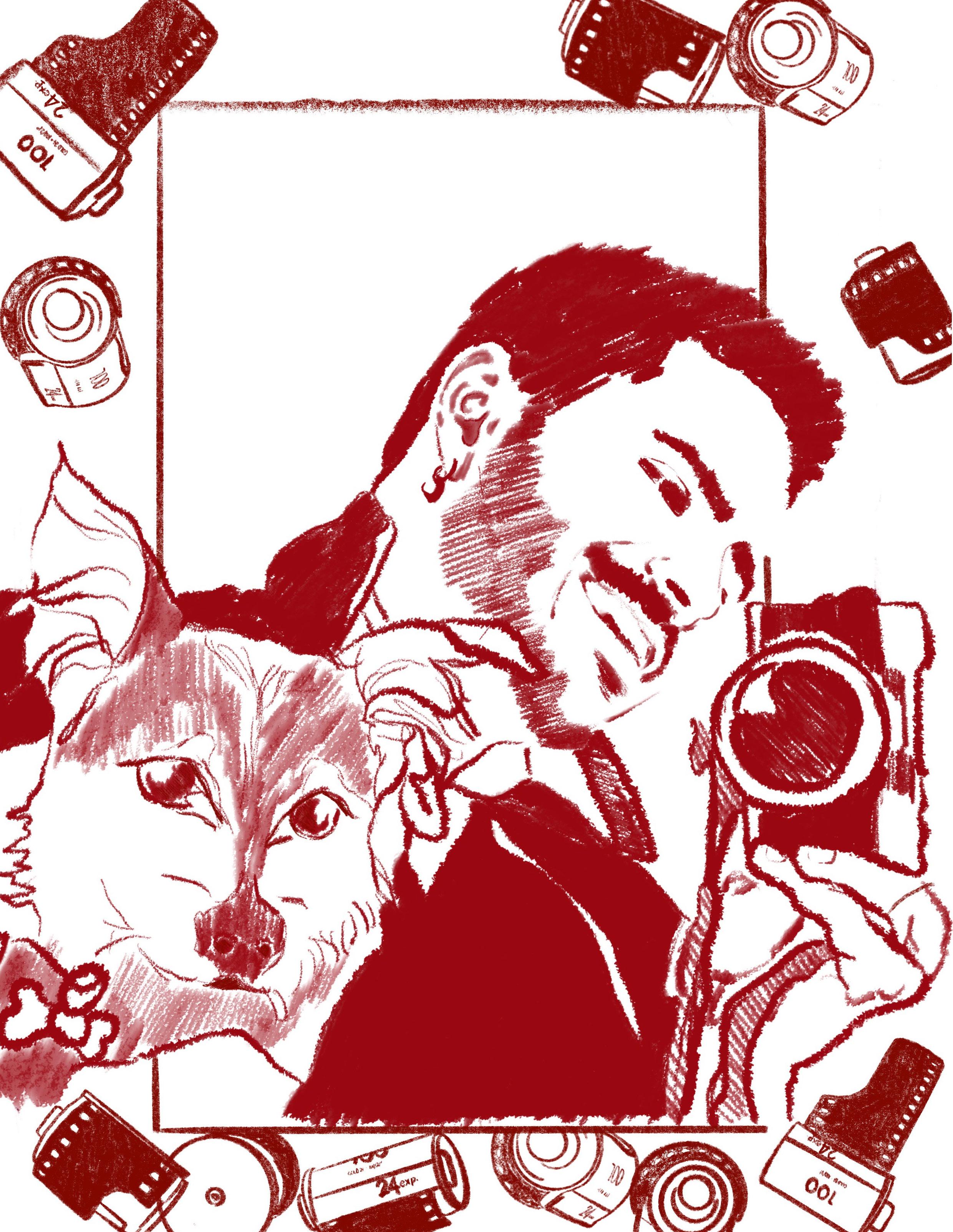
The first months of COVID-19 were really hard for me. I had no idea how long it was gonna be for, if it was even as deadly as people said, and if that meant I’d be out of a job forever.
I had been previously working for Spectrum doing door-to-door sales in South Central, California. In short, I was basically the guy that no one wants to talk to. As hard and thankless as my job was, it was somewhat rewarding because at least I could make some decent money that people my age wouldn’t really be making. COVID changed all that.
I was fearing for my life. Things got worse at work as my job forced us to continue knocking and didn’t provide us with any personal protective equipment. I had people who would spit on me and even had guns pointed at me because they, understandably, didn’t want me to be there.
Since I had no way to tell if people were sick or not and I couldn’t tell the people to put a mask on at their own house, my job was pointless and frankly not worth it. The services eventually became free to residents of California during the first couple of months of the pandemic, so not only did I not get any sales, but I was basically forced to work for free.
This may sound like a rant, but because of the experiences I had endured working as a door-to-door sales representative at Spectrum, I realized that enough was enough. I began applying for jobs I knew I could do, jobs I had studied for. I desperately wanted to work in film again and since some of my family works in visual effects, I figured that would be my best bet.
I saw some openings for MoCap Vaults, Rouge MoCap and other studios that focus on motion capture. I may not have had all the experience, nonetheless, I showed them that I was willing to work and learn, so I applied myself and sent in my resume. But nothing came back.
I had contemplated going back to school and finishing my associate degree in film for a couple of months prior. I had seen photos of friends and former classmates graduating on Instagram and realized that this was a once-in-a-lifetime opportunity. No more would Ivan Zermeno feel unaccomplished or wonder “what if I had continued my schooling?”
But it wasn’t immediate. The situation with Spectrum had really messed me up and I needed some time to gather myself mentally and physically, since I wasn’t eating nor sleeping. I went from a job that would set
irrational goals, like selling a phone service that mostly no one had heard of on the spot, to not having to worry at all. So in reality I had felt like a huge weight had been lifted off my shoulders.
I decided to hide away in my grandmother’s garage and just began to work out again, similarly to how a prisoner serves his sentence or how a caterpillar cocoons himself away, until I was ready to take on the world. But after a while of being locked away, I felt that I needed to go out. I didn’t want to alienate myself and become unfamiliar to everyday life, as many others did throughout the quarantine.
Additionally I got into film photography. I found it soothing and it helped ease my mind. It captures a moment, as if beauty had become forever frozen to the time around it, even though some of my pictures weren’t all that great. I wasn’t really good at it, technically.
I started to search for photography classes and found myself enrolling at El Camino College in spring 2020, since I had heard great things about the photography courses provided here at ECC. Seeing that it was part of the journalism requirements and that it went hand-inhand with film I decided I’d take it up.
Eventually I found myself taking more and more classes and really felt like I was somebody again. I quickly put together a resume and a portfolio with all my pictures and years of working in film for jobs and schools to look at, but suddenly I got a phone call.
It was a miracle. A buddy of mine told me that a studio he knew of had an opening and that because of unemployment, people would have rather collected checks than go back to work. People weren’t even applying. Needless to say, I was very hesitant to apply because I had just started school again, but it’s been over a year I'm in the company now and I can’t tell you how much my life has changed.
This job has opened so many doors for me, as I get to go on shoots for video games and movies alike, and I’ve gotten to meet so many new people.
I finally got a job I wanted, where I can feel like myself and be good at it, and it’s all because of COVID.
Yes, these past two years have been some of the most difficult times I’ve ever faced, as I lost loved ones, had no money at times and was almost driven mad, but I wouldn’t be where I am today if not for this once-in-alifetime opportunity to come back to school and get the career I wanted.
Growing up in the South Bay, there was no shortage of fabric stores you could count on to take care of all your communion, quinceañera, prom and other dress-making needs. Lennox Boulevard, Market Street in Inglewood and Gardena Boulevard were some of the places you would go to for the perfect fabric and accessories for your special occasion.
Those places are mostly gone now, but with a little effort you will find them. For anyone wanting to support family-owned businesses and willing to drive a bit further out, here are Warrior Life’s top five picks for fabric stores within 15 miles of El Camino College.
Opened in 1989, SAS Fabrics is a large family business with a huge selection of fabrics and also trims, yarn and accessories. The inside has a warehouse-like feel that invites you to rummage freely aisle after aisle.
Address: 13500 Hawthorne Blvd., Hawthorne Phone: 310-978-8985
Hours: Tuesday-Saturday: 10 a.m. to 6 p.m. Sunday-Monday: Closed
Website: https://www.sasfabricscalifornia.com/
A wide variety of denim is available for $5.99 per yard at SAS Fabrics in Hawthorne. SAS Fabrics is the largest family-owned fabric store in the South Bay.
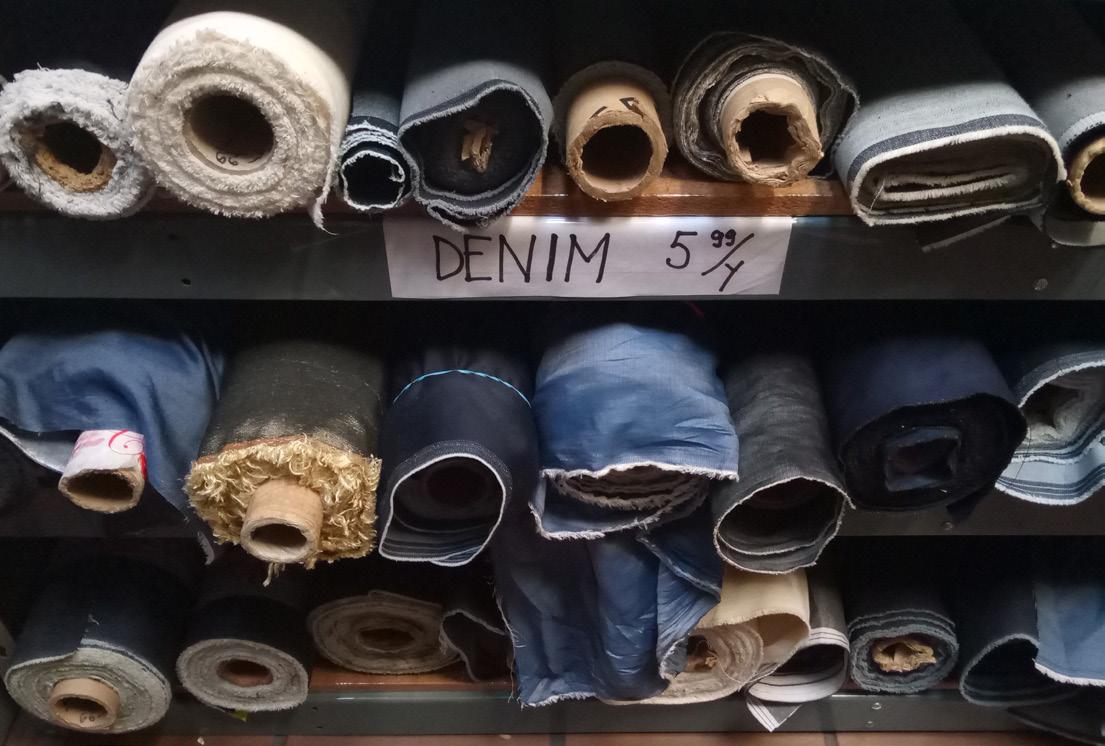
Traditional, festive and brightly-colored Polynesian fabrics are the specialty of Islands Fabric in Carson. Most prints are available for $5 to $10 per yard.

Islands Fabric is a small store packed with aisles and walls of vibrant Hawaiian, Samoan, Tongan and other island fabrics. Small sections of clothing, sarongs, flags, accessories and pro sports fabrics are also available.
Address: 638 E. 219th St., Carson
Phone: 310-518-0600
Hours: Monday-Friday: 10 a.m. to 6 p.m. Saturday: 9 a.m. to 5 p.m. Sunday: Closed
Website: https://alensfabric.com/
A wide selection of cotton fabrics is available for $9.99 per yard at Fabric Barn in Long Beach. Fabric Barn is the largest family-owned crafting store in Long Beach.

Opened in 1980, Fabric Barn is a large arts and crafts store with a small, but well-stocked, section of fabric in the very back of the store. Pre-packaged cuts of fabric and a variety of party favors and decorations are available up front.
Address: 3111 E. Anaheim St., Long Beach
Phone: 562-719-2881
Hours: Sunday: 9 a.m. to 4 p.m. Monday-Saturday: 9 a.m. to 5 p.m.
Website: https://fabricbarninc.com/fabric.aspx
Originally opened in Leimert Park in 1987, Africa by the Yard is a small home furnishings shop run by owner Faadil Asadullah. The shop features a wall of authentic fabrics imported from Niger, Nigeria, Ghana and other West African nations.
Address: 416 E. Manchester Blvd., Inglewood Phone: 323-291-1517
Hours: Tuesday: Noon-8 p.m. Wednesday: 10 a.m. to 8 p.m. Thursday: Noon-8 p.m. Friday-Saturday: 10 a.m. to 8 p.m. Sunday-Monday: Closed
More than just a fabric store, Africa by the Yard in Inglewood is a little cultural treasure. A nice selection of rich African fabrics is available for your traditional dress needs.

Fabrics used for quinceañeras, party dresses and evening gowns are available in a variety of colors at Chic Fabric Remnants in Long Beach. Cotton print fabric and accessories are also available.
Chic Fabric Remnants is a small neighborhood shop packed with rolls of silk, lace, tulle and all your fancy dress needs. The shop is run by owner Sylvia Garcia, whose customers greet her by name as they arrive to pick up their alterations.
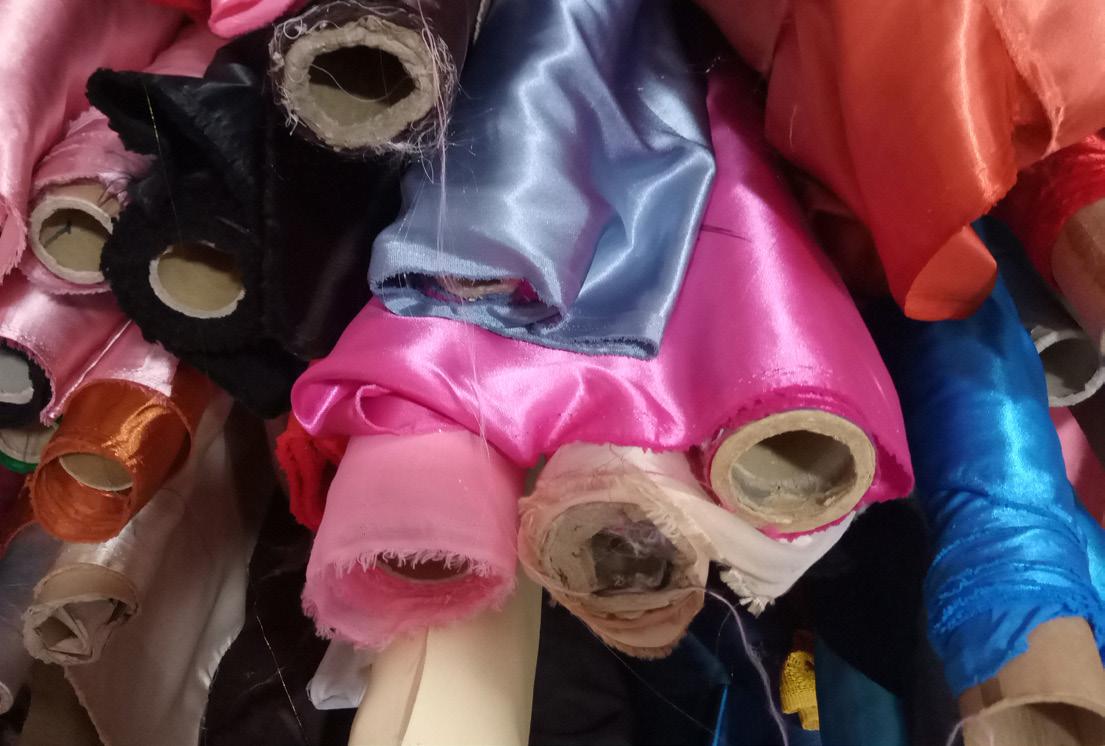
Address: 1704 E. Anaheim St., Long Beach
Phone: 562-591-3572
Hours: Monday-Friday: 10 a.m. to 4:30 p.m. Saturday: 10 a.m. to 4 p.m. Sunday: Closed
Coach Marco Trejo (left) debriefs with Joey Abudy about the sparring match he just finished at Sweet Science Boxing & MMA Gym in Hawthorne, Calif. on Thursday, April 7, 2022. Trejo grew up in Hawthorne, graduated from Hawthorne High School and attended El Camino Community College. (Kim McGill | Warrior Life)

As people walk into Sweet Science gym they hear the pounding of gloves being hit onto heavy bags and boxing mitts which creates a loud “boom!” It’s like a mini-explosion that’s accompanied by the yelling and grunting noises each fighter makes when they throw punches.
Once inside the gym the smell of sweat hangs in the air. Everyone is working at an intense pace. There’s always a handful of fighters hitting the heavy bags to the right followed by others doing strength and conditioning. Next to the ring is Marco Trejo, the owner of the gym, with one of his best fighters, getting ready to spar.
Marco, now in his early 40s, founded Sweet Science Boxing gym in Hawthorne in 2009 at the age of 29. In a room full of chiseled physiques, honed through training, Marco stands all but 5 feet, 8 inches, compactly built with broad shoulders and little potbelly that seems to protrude a little more each time he's seen.
In 1999, Marco was a fresh-faced El Camino College student. What makes the connection all the more interesting is, he’s still an El Camino college student. Just one class shy (math 80) of getting his Associate Degree.
Life has taken him in and out of school, while struggling to find his place in the world, he’s managed to carve out a niche for himself through boxing. All while keeping an optimistic outlook and still hoping to one day graduate from El Camino and finish what he started. This is his journey.
Marco has been a boxing fan as far back as he can remember. He has fond memories of watching Mike Tyson and Julio Cesar Chavez fights on pay-per-view in the early '80s. His father loved boxing. That love was passed down to a son who had no idea how much he would impact the sport in his future.
Boxing is in Marco’s blood. His father never boxed himself and Marco was more of a baseball player, but Marco’s grandfather, Francisco Trejo, was a professional boxer in the late '20s and early '30s. The legend says, Francisco Trejo would find his way to San Francisco a few times a year to fight under the name “Frankie Night.”
He had over a dozen professional matches, but there’s no known history on his success or failures. What is known, is that his grandfather never acknowledged Marco’s father as his son and abandoned the family to raise another family, but this was during Mexico in the early '50s and that is a story for another time. At twelve years old, Marco saw his first professional boxing match at Cesar’s Palace in Las Vegas. It was Oscar De La Hoya fighting for his first title against Rafael Ruelas. That same night Jimmy Garcia was killed in an earlier boxing match. It was traumatic and historic.
“That moment, I’ll never forget. I learned that boxing is not a
game to be played, it is serious business,” Marco says.
While attending Hawthorne, Marco played football and baseball. Marco was not the best athlete in the country, but he was good enough to grab the attention of a few colleges that were scouting him at the time. He even yearned to get into boxing, but his parents were reluctant to get him into a boxing gym for obvious reasons
“I could have gone a lot further with sports, maybe even pro, but I was too busy partying, smoking weed, drinking and just being an idiot,” Marco says.
During a time of grunge music, gangster rap, baggy pants, and youthful rebellion and Marco was in full participation After graduating from Hawthorne, Marco attended El Camino College. He decided not to play baseball or football because, quite frankly, he was “high all the time.”
“I had no focus, no direction, not a care in the world to better myself, to learn anything, I was lost. But, I did like illegal street racing, way before Fast and Furious was even a thing,” Marco says.
Marco started to find some direction, while still smoking marijuana. Marco and his friend who’s an El Camino student came up with a wild idea to create a car magazine, documenting the illegal street racing scene in Southern California.
Thus “Street Racing Magazine” was born. Since both Marco and his fellow friend were both street racers and students at El Camino, what better way to learn the ins and outs of magazine writing then to major in journalism.
“The magazine only lasted 3 issues and I spent a lot of money totally chasing a pipe dream,” Marco says.
Back then credit card companies had promotional tents in the quad at El Camino and offered students their first credit cards. Somehow Marco was approved for an amount large enough to fund his wild magazine idea.
“I was getting high, street racing and someone gave me money. The idea to start a magazine when I had no idea what I was doing was the perfect storm of stupidity and fun. Let’s just say I spent a lot of money and never paid it back,” Marco says laughing. “But I learned more in creating this idea from thin air, than I ever did sitting in any journalism class. Now it might be just me, but I tend to leap before I look. Also, I was just never the classroom type of guy,” Marco says.
At this point Marco had failed his journalism class and was flunking in everything else. The magazine was dead and higher education was not in the cards. Two years later, at age 23, Marco was able to take his experience from starting his magazine as he was hired by another magazine start-up based in Atlanta, Georgia.
“I may have failed at being a publishing mogul, but I learned enough about starting a business and creating content that I
impressed the owners of this publishing company. So they hired me. The job included a lot of travel,” says Marco.
It was an opportunity for Marco to continue following his passions in the automotive world and to see other parts of the country. While working in Atlanta, and living in a small city, Covington, just outside of the ATL, Marco would drive by a gym with the sign USA Boxing. Being the former athlete that he was, and loving boxing, it made sense to take a look.

With few acitvities outside of work, it was the perfect opprotunity to do something different. Walking into the gym he was greeted by Reggie Tousaint, the owner of the gym. Reggie claimed he was on the USA Karate team a few years back.
“I had no reason to question him, he was a great guy. I think he was in a few karate movies back in the day too. Either way, he wa teaching boxing and his gym was down the street from work, so I signed up,” Marco says.
Immediately Marco took to boxing like a fish to water. In less then 3 months of being in the boxing gym, Marco had his first official amateur competition.
“I didn’t win but it was a close fight. We boxed at 170lbs, which when I think about it now, is huge. The guys at my gym that are 170 are absolute monsters. I was young enough and dumb enough at the time to survive and surprisingly did well in my fight.
“I remember being so excited about my match, I emailed my family back to tell them I was on my way to being the next Oscar De La Hoya,” Marco says.
Obviously, Marco never became the next Oscar but this experience awoke his passion for boxing and sport like nothing ever before.
“I caught the boxing bug, a lot of people do, but it’s in my blood so it makes sense to me now. I never knew my grandfather was a pro boxer until I was in my early 30’s after we had started meeting his side of the family. The movements, the competition, the challenge and routine were all natural and enjoyable to me. I’ve been in a boxing gym ever since,” Marco says.
Soon after his work experience in Atlanta had ended, Marco was back in Southern California and immedietely got himself into a boxing gym. He went to a gym called Broadway Boxing gym
Marco Trejo, (center), founder of Sweet Science Boxing and MMA, trains Joey Abudy in one of the gym’s two rings in Hawthorne, Calif. on April 7, 2022. “He is one of best amateur boxers in the country,” Trejo says of Abudy. “In two weeks, he will be in Cleveland to try out for the U.S. national team,” Trejo adds. (Kim McGill | Warrior Life)known to carry an old school boxing environment and culture. Ken Norton, who fought Muhammad Ali trained there. His trainer Bill Slayton founded the gym.
His next trainer at Broadway was a man by the name of Jesse Barnnet. Jesse was janitor at UCLA for most of his adult life, but prior to that Jesse was a light heavyweight contender. He had fought for the world title 3 times, but lost each time. He had one of the best jabs in his division.
Jesse had fought on ABC Worldwide of Sports in the late '70s and early '80s, with Howard Cosell commentating. Marco says he learned a lot from Jesse. They trained together almost everyday for 2 years.
Although Broadway Boxing was a great gym, the neighrborhood was just too dangerous to be at every day and night, so Marco ventured to Torrance where a new gym had opened up called L.A. Boxing.
It was more of a commercial and franchise location. It didn’t have the grit and serious boxing environment of a Broadway boxing gym, but the atmosphere was friendly, the trainers were fun.
He made friends with three other fighters, and they would always ask Marco to train them along with countless others. Marco and the three other fighters all thought the gym (LA Boxing) wasn’t that good and came up with the idea of owning their own gym. One was a UFC fighter, the other was a trainer, another a firefighter. “I don’t even think I was ever a real boxer, but people started asking me tips, to show them how to punch. I had never thought about training people, but here I was, doing just that. I guess that’s when the seed to become a trainer and maybe one day open a gym was planted,” Marco says.
While working a full-time job, Marco had been saving his money. When he came back to LA from Atlanta, he got in touch with his former magazine partner. They ended up started a online retail business selling car parts. A business still in operation to this day says Marco.
“We made a good bit of money and I did that for 5 years. While I was still boxing every day after work, I realized, I love boxing. So I sold my share of the company to my partner, and along with those funds and my savings I decided to start my own boxing gym,” Marco says.
Marco along with some of his friends he met at LA Boxing, invested their money into getting a gym together. They would all be partners.
“The biggest mistake I made in doing so, was having partners. We all put in some cash, but it was really me leading the charge, to find a location, come up with a logo and build the gym,” Marco says. “That’s the thing about partners, someone always does more. It’s not fair and that’s when tension builds, but I saw this as an opportunity. I knew that each partner was busy with other projects, or full time jobs, or family responsility, that eventually that could not commit to being a full-time gym owner.”
It became apparent to Marco that he was doing more than anyone else to fund, operate and maintain the gym. Each partner had an excuse for spending less time in the newly founded Sweet Science Boxing & MMA. As Marco predicted and patiently awaited, each partner left.
“It wasn’t much money each person put in, so it wasn’t a huge loss to them, especially if they were chasing bigger money. I knew the potential of the gym, I knew it could grow, so I stuck it out. I kept putting money into it, when it needed it and I put in the hours
to teach classes and train people when we needed it,” Marco says.
Sweet Science Boxing & MMA was formed in 2009, with Marco taking over as sole owner around 2012. In hindsight Marco believes the hardest part about owning the gym were his partners. He says they held him back from accomplishing everything he wanted for Sweet Science.
“When the time was right, all the partners were gone and it was just me and I was ready. I think if I had gone at it alone, I wouldn’t have learned so many lessons that prepared me to be in charge. The universe tends to know when you are ready,” Marco says.
Being the sole owner of a business may have been easier for Marco, but he was still dealing with some drug problems, alchohalism and overall immaturity. Marco had challenges he had to evercome and fight through in order preserve his gym.
Marco also had to pay rent when there were some months when there wasn’t enough money to cover the rent. So, again, he reached into his pockets, worked during the day and did whatever was needed to keep his gym afloat.
Noticing their son's passion, hard work and commitment towards fighting for his boxing gym, Marco’s parents, who were retired at the time, offered their help. Marco’s mom ran a kitchen at a private high school for 20 years and his father was an aerospace machinist with his own manufacturing shop that he ran for 30 years.
“My parents are some of the smartest people I knew, even though I was a total dick growing up, they always had my back and when they saw me struggling, they offered help. It was one of the best moments of my life. My mom was helping run the books, collecting payments from all the members and my dad was working with the trainers, making sure they taught the student well. I would come in and teach, which is what I did best,” Marco says.
This period lasted for a few years, from around 2013-2015. In 2015 Marco’s father, Marco Sr. was diagnosed with colon cancer and died only 3 months after.
“Having my mom and dad in the gym with me, working together was the best. I’ll never forget how much fun we had. We worked well together. I even got to take my dad to many professional fights and we got to corner and train professional boxers together. He became my best friend. It was difficult losing him,” Marco says
Since Marco’s parents were helping him to manage the gym while he was still working full time, after his father’s passing, he decided to get into the gym full time and devote all his efforts to running a successful gym.
“You have a tendency to take on more responsibility as you get older and losing my dad really cemented that for me. My mom loved being at the gym too, it became a family thing and I had to be there with her. After all, I started it, they just lifted me up when I needed it. I had to be there,” Marco says.
After Marco Sr. passed, Marco and his mother built the gym into a well oiled machine. Students were learning, gym memberships were being paid.
“We made some more changes as time went on, but it really grew. My dad would secretly tell my mom the gym was a gold mine, and he was right. We still had issues with finding the right help, creating the right energy and postive atmosphere for training boxers, but that all came with time,” Marco says.
Everything was going great for a few years and then COVID-19 hit. The gym had to be shut down for 3 months, and when it did open it was a limited capacity. The fruits of labor had stopped coming in. But like many great business owners, Marco had to find a way to make money.
Coaches and boxers gather at Sweet Science Boxing & MMA Gym in Hawthorne, Calif. on Thursday, April 7, 2022. (Kim McGill | Warrior Life)
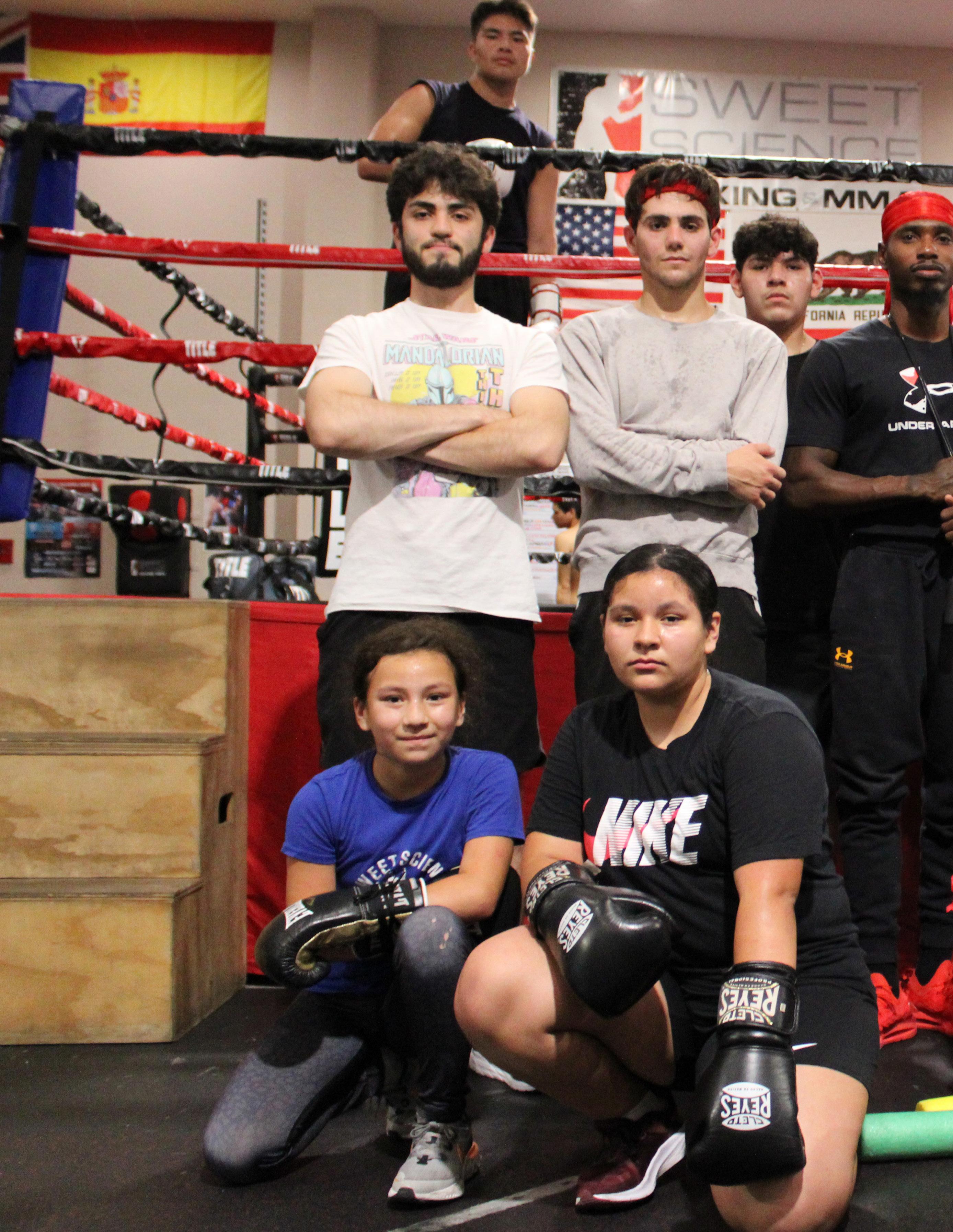

The pandemic continued, businesses were shut down, but the bills, rent and every other expense kept coming.
“As a small-business owner, I have my opinion on the pandemic,” Marco says. “I had to cover the windows, keep the lights off and train people in secrecy and just be creative to keep our business going. I know a few other gyms that closed permanently cause of COVID, I wasn’t going to be one of them,” Marco says.
Having saved money during the profitable months off the business leading to the pandemic, Marco made two moves that helped generate revenue while his business was in limbo. One, he converted his parking space into an outdoor training area. He fenced off a large space, dropped some artificial turf on the asphalt and added a few pieces of training equipment.
“The city came to shut us down one day. They said the only way we could stay open is if we could train outside, so that’s what we did. I purchased chain-link fence and fence post from the old Sears at the Del Amo Mall that was closing and erected a fence within a week,” Marco says.
The second thing Marco did was liquidate equipment.
“I realized a lot of gyms, boxing gyms in particular went out of business, so I went hunting for boxing equipment on the cheap. I found two boxing gyms that were in a bad position and were selling thousands of dollars of equipment for about a quarter the value. I bought as much as I could and then flipped it for double the profit. Everyone wanted to train at home, so it was a great time to sell equipment,” Marco says.
These decisions not only helped Marco and his gym to survive but to thrive while others were failing. As the gym grew during the pandemic, Marco also noticed a number of buildings becoming vacant all throughout Hawthorne. With the idea of constantly growing, he scouted a few locations. The location at the time was in use from 2012 to 2021 and even with the parking lot converted Sweet Science Boxing & MMA was out of space, there was no room to grow.
“I found a building that had been empty for over 15 years. It was rented just before COVID to be converted to a restaurant but because of the lockdown all construction on it stopped. During the lockdown it was taken over by homeless and the tenant (restaurant owner) had terminated his lease. I knew I was going to get this building,” Marco says.
After a few months of negtiations, Marco found a new home for Sweet Science that took them from 3000 sq ft to approximately 9,500 sq ft.
“I signed a 10-year-lease and locked in a good rate, so I am not planning on going anywhere, and we can continue to grow in this building while knowing what to expect. At our other location the landlord kept raising rent and we couldn’t expand the building, so it was time to move on,” Marco says.
One of the biggest things that steered Sweet Science into noteriety was Marco’s willingness to learn and be open. If he didn’t know anything he’d ask or he always watched how people who were successful did things. He’s also always open to trying new and different things that would benefit the gym.
Coach Jamal Abdullah is a multi-time world champion coach and trainer at Sweet Science. He joined Sweet Science just a couple years ago and a big reason why he chose Sweet Science is one, because Marco wanted him to join and two, he respects Marco as an owner, trainer and person.
“Marco is a guy who doesn’t have a chip on his shoulder. Some coaches feel like other people and coaches are trying to step on
their toes but not him. He’s always trying to do what’s best for the gym,” Jamal says.
After COVID Marco’s mom had since re-retired, but she still comes to the new location to clean, or organize equipment and clothing in their store front. He found a supportive partner, Nikki Nunez, who was a manager at another gym. She trained at Sweet Science one day and they hit it off.
Nikki also shares Marco’s passion for martial arts, boxing and business. She helps run the front desk and teaches classes. They also have a 2-year-old son, that is sometimes seen running through the gym punching every bag he goes by.
Currently, Sweet Science Boxing gym is one of the biggest boxing gyms in Los Angeles County, if not the biggest. Raul Morales is the owner of a notarized boxing gym called CM Boxing Stables in Alhambra. Similar to Marco he had to endure and fight through hardships owning a boxing gym entails.
“Our first year we were losing money, we had maybe 20 fighters at the time. It’s really hard being an owner because there’s no money in boxing. Our gym started getting more popular due to my brother being a professional fighter signed with Golden Boy and he marketed the gym a lot. Good coaches and being able to communicate with the fighters and parents is what makes a good boxing,” Raul says.
It’s not easy creating a successful boxing gym. Jessica Rene Rico is the current owner of Grampas Boxing gym in Westminister, a top boxing gym in California. She’s been the owner for 11 years and had to overcome the trials and tribulations of owning a boxing gym.
“It's not easy work. It takes discipline and grit. You have to sacrifice other areas of your life and cater to running a successful gym. You need good judgement to make difficult decisions. Not a lot of people have the patience or the wisdom to run a boxing gym. Also, finding the right people for your team who add to the gym and not just take from it is very tough,” Jessica says.
“ At times I wanted to quit, even sell the gym. I felt like taking off and starting over somewhere else. Los Angeles is so expensive, but my family is here and I just can’t quit, I have to finish what I started. When I was a teenager, or even my early 20s, I never finished anything. Once I found boxing and the opprotunity to start the gym, I really found someting that inspired me, that made it easy to get up in the morning. There was never enough time in the day to get work done. Even when I was partying, drinking or smoking too much, I just loved boxing, coaching, competing and everything else about it,” Marco says.
Boxing has taken Marco around the world. His fighters have competed in Israel, Russia, Pakistan, and all over the United States. He says he still wants to finish El Camino and finally graduate. He’s since switched his major to anthropology.
“When I was in school, I thought I wanted to study business, or journalism. I wanted neither, it’s just what was expected. I went back a few years ago in my late 30s and I switched my major to Anthro because I loved the class when I took it as an elective, and guess what? I aced every class, because I was interested. Probably cause I didn’t smoke weed anymore and had a better attention span too, but point is, got to do what you love. Find what you love and be great at it especially if you can earn money. If you're great at it and it doesn’t earn money, then get a job and do what you love on the side. Not every student is a great entrepreneur and vice versa. Every road is different, you just have to keep driving,” Marco says.
Dance instructor Tamara Kemp expresses her joy in resuming dance teaching after a two-year hiatus due to mandated COVID-19 closures.

 Former El Camino College dance student Tamara “Miss Tammy” Kemp returned to classroom teaching of children ages 2 to 13. Her first class, tap and ballet, took place on April 2, 2022, at Freeman Park in Gardena. She has been a dance instructor for the city of Gardena since 2001.
Former El Camino College dance student Tamara “Miss Tammy” Kemp returned to classroom teaching of children ages 2 to 13. Her first class, tap and ballet, took place on April 2, 2022, at Freeman Park in Gardena. She has been a dance instructor for the city of Gardena since 2001.
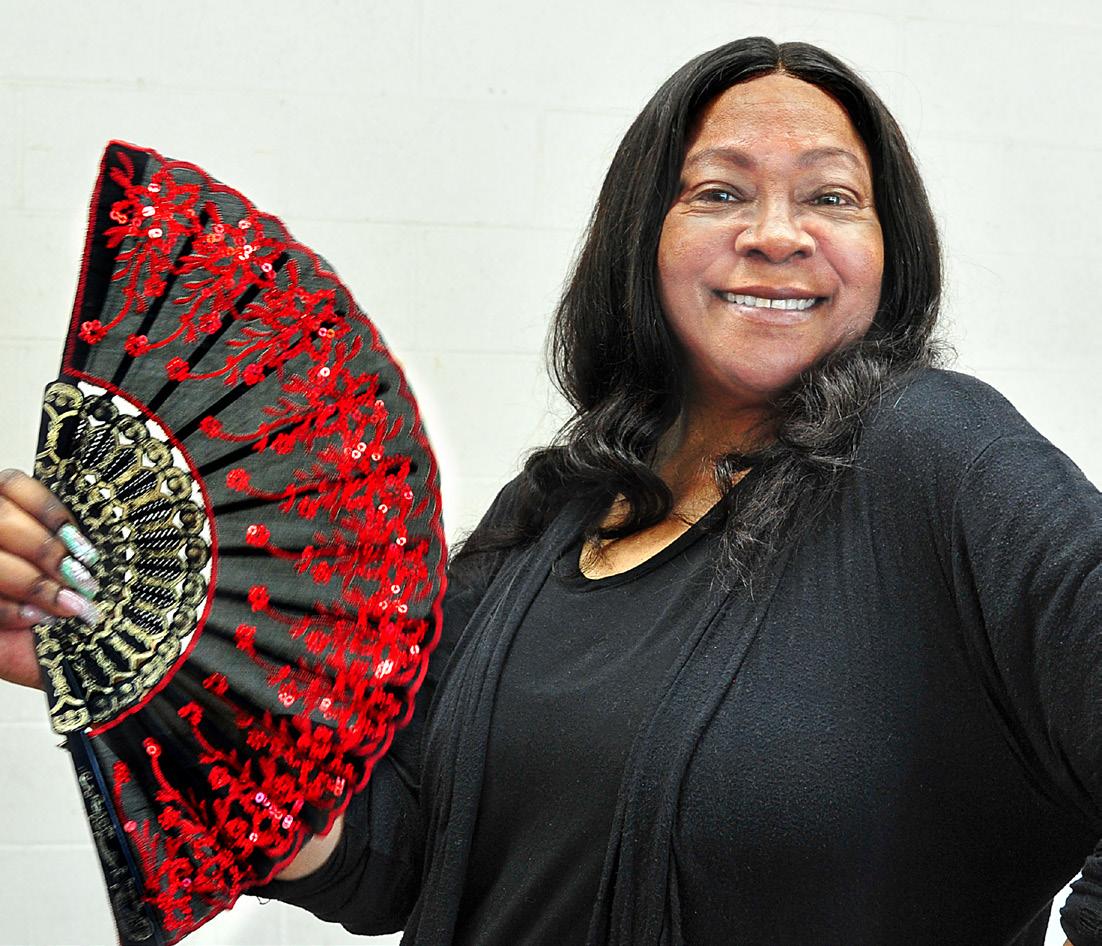 Story and photos by Gary Kohatsu
Story and photos by Gary Kohatsu
It’s a suffocating April morning in 2022. Ten little girls dressed in pink or black leotards sit obediently on a cement floor painted burnt-orange, inside a recreation room that measures 25-feet by 60-feet.
Circulation is aided by a portable air ventilator as temperatures outside soar to 100 degrees.
“Good morning, I am Miss Tammy,” the teacher says to parents and tots.
Today is the second Saturday dance class in the city of Gardena since COVID-19 shut down the program two years ago.
Nobody has looked forward to in-person teaching again more than the teacher herself.
Tamara Kemp, affectionately known as “Miss Tammy,” sits cross-legged facing her Dance One (tap and ballet) students. She is dressed in black — from the cloth face mask and hoodie top, to her stretchy yoga pants and short boots. A purple cap is pulled over her black, shoulder-length hair.

Tamara’s sparkling gray eyes (thanks to contact lenses) sweep the room. Her effervescent smile is on generous display.
Tamara Kemp leads her tap-ballet Saturday dance class through stretching exercises on April 2, 2022. This was her first class back from the Covid-19 virus shutdown.
Tamara taught her first youth dance class in 2001.
“Miss Tammy” as she is affectionatley known as by her dance students, began her dance studies as a 4-year-old youth in the city of Inglewood.“I want each of you to give your name, your age and your favorite princess,” Tamara says.
Her dance students, age 2 to 5, respond with shyness.
“My name is Presley… five. I like Ariel,” the first child says just above a whisper.
“My name is Jayleen… (she holds up four fingers)... my favorite is Belle,” the next child, with long, black braids, says.
One by one, the other tots share their answers.
“Jasmine is my favorite.” “I like Moana.” “I like Ariel,” they say.
Tamara, with mock concern, asks: “Doesn’t anybody like Cinderella?”
In a matter of seconds comes a wave of raised hands and little voices: “I do, I do, I like her.” “I like Cinderella.” “Me too, I like Cinderella.”
Tamara claps her hands and laughs.
“That’s wonderful,” she says. “Did I miss anybody?”
Winning the trust of young students is second nature to this 63-year-old Inglewood-based teacher, who began her own dance studies at age 4 in an Art Linkletter tap class.

Tamara’s diverse dance training includes ballet, jazz, hip-hop and contemporary dance — besides tap, her favorite form.
She has parlayed this training into a successful professional dance career that has spanned the early 1980s to the new millennium. Tamara has performed with the Lon Fontaine Dance Co., Don Cornelius’ “Soul Train,” and “The Japan — Soul Train Connection,” among others.
Her last regular dance stint was as an El Camino College student in the early 2000s.
Dancing has been a wonderful experience, she says, but teaching dance is her calling. Her philosophy also includes the benefits of a college degree.
“My intent was to always teach children,” Tamara says. “When you are a dance teacher, your objective is to create dancers. But in recent years, my goal has been more about teaching confidence and instructing them to believe they can do or accomplish anything.”
Since 2001, Tamara has been the principle community dance teacher of children for the city of Gardena’s Recreation Department.
She oversees about 60 students (age 2 to 13) in three levels of dance, from tap and ballet to hip-hop and cheerleading.

Stephany Santin, who became director of Gardena’s Recreation and Human Services in 2019, quickly learned of Tamara’s stellar reputation.
“We did a survey in 2019 and many parents indicated how much they liked her classes and how they wanted her to teach even more classes,” Stephany said. ”(Tamara’s dance program was) one of the most requested classes when we started reopening and bringing back sports and (fitness) classes.”
Tamara says a few of her students have even found commercial success.
“One of my dancers is in a Jennifer Lopez video,”
Tamara says. “Another student is doing commercials, action and voice-overs. And I saw two twin boys in a Target (store) commercial.”
Tamara has recently registered her On Your Toes dance company as a non-profit business to pursue grant funding and is getting help from friends to market and reach audiences through social media platforms, as well as revamping her website, she says.
“Dancing and education gives you two fueling stations,” Tamara says. “They can take you anywhere. Dance can open horizons to see bigger things.”
Tamara says that learning dance should start at age 2.
“They (2 year olds) can be stubborn and that’s an age to break them (of bad tendencies),” Tamara says.
Danielle Brown, a clinical associate professor at the USC Suzanne Dworak-Peck School of Social Work, says that teaching youngsters at age 2 might be a subjective matter. She does agree that children willing to accept dance training early in their lives will discover its benefits.
“(Formal dance training) like organized sports for children is a way to develop teamwork, skill building, self-regulation and builds a sense of community in the class,” Danielle says.
Tamara says that the discipline leanred through formal dance insruction can help prepare a person for competition..
In 2003, Tamara earned her associate degree in physical education at El Camino College (there was no dance degree at the time). From 1999 to 2001, she performed with Qui Geometer, an ECC dance-theater ensemble created and directed by teacher Bernice Boseman.
“It was tough. I came in as an established dancer,” Tamara says.
“They had their student choreographers and it was kinda like a clique. So you had to break into the clique. After an audition, they would pick or not pick you for the dances they were presenting.”
Tamara is considering taking additional classes at ECC to change her AA degree from physical education to dance.

Daniel Berney, ECC professor of dance, says dance was classified under the physical education umbrella at one time. Dance has since been placed in the Fine Arts division.
“Dance was more activity based when it was part of physical education,” Daniel says. “Now (dance) is performance-based and to get a dance degree requires additional classes, such as music and dance history.”
Daniel says returning students can take independent study.
“We go to (the student’s) teaching or performing environment,” Daniel says. “Then we develop a series of assignments that they undertake which is based on their specific environment and then we observe them, monitor (their progress) and (if successful) give them those extra units of continuing education.”
Youngsters mimick teacher Tamara Kemp as they learn various ballet techniques on their first day of tap-ballet class at Freeman Park in Gardena. Tamara learned tap and ballet as a 4-year-old child growing up in Inglewood. Among her credits, Tamara was a dancer for “Soul Train” TV dance show.“
Tamara’s dance program was one of the most requested classes when we started reopening and bringing back for sports and classes.
”
— Stephany Santin, city of Gardena
Tamara was born the second oldest of four children (two boys and two girls) to Thomas and Yvonne Kemp. Thomas has roots in Oklahoma, while Yvonne’s parents migrated to LA from Louisiana.
The Kemp family settled in a middle-class north Gardena neighborhood in the 1950s.
When Tamara was 4, she was enrolled in an Inglewood dance class.
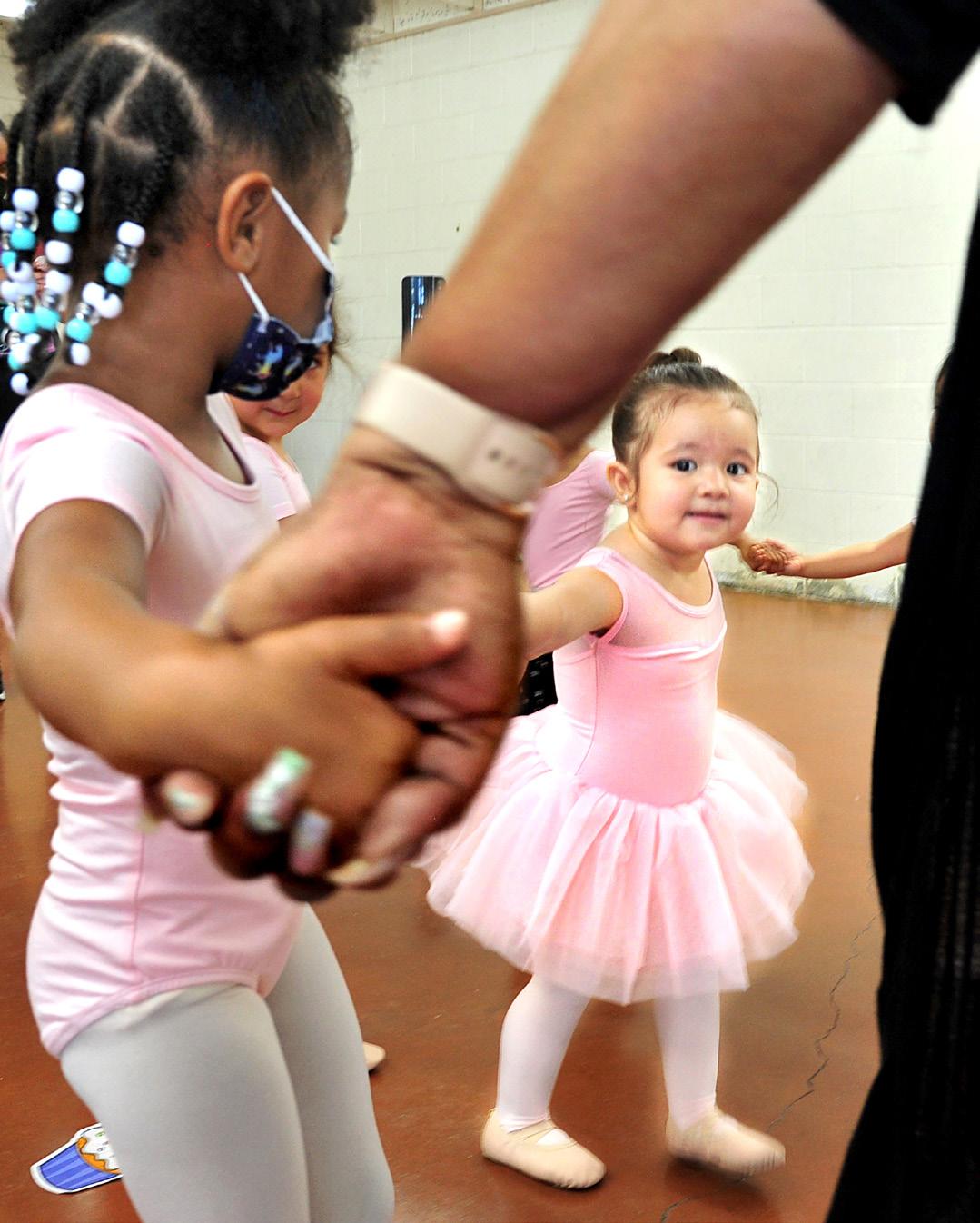
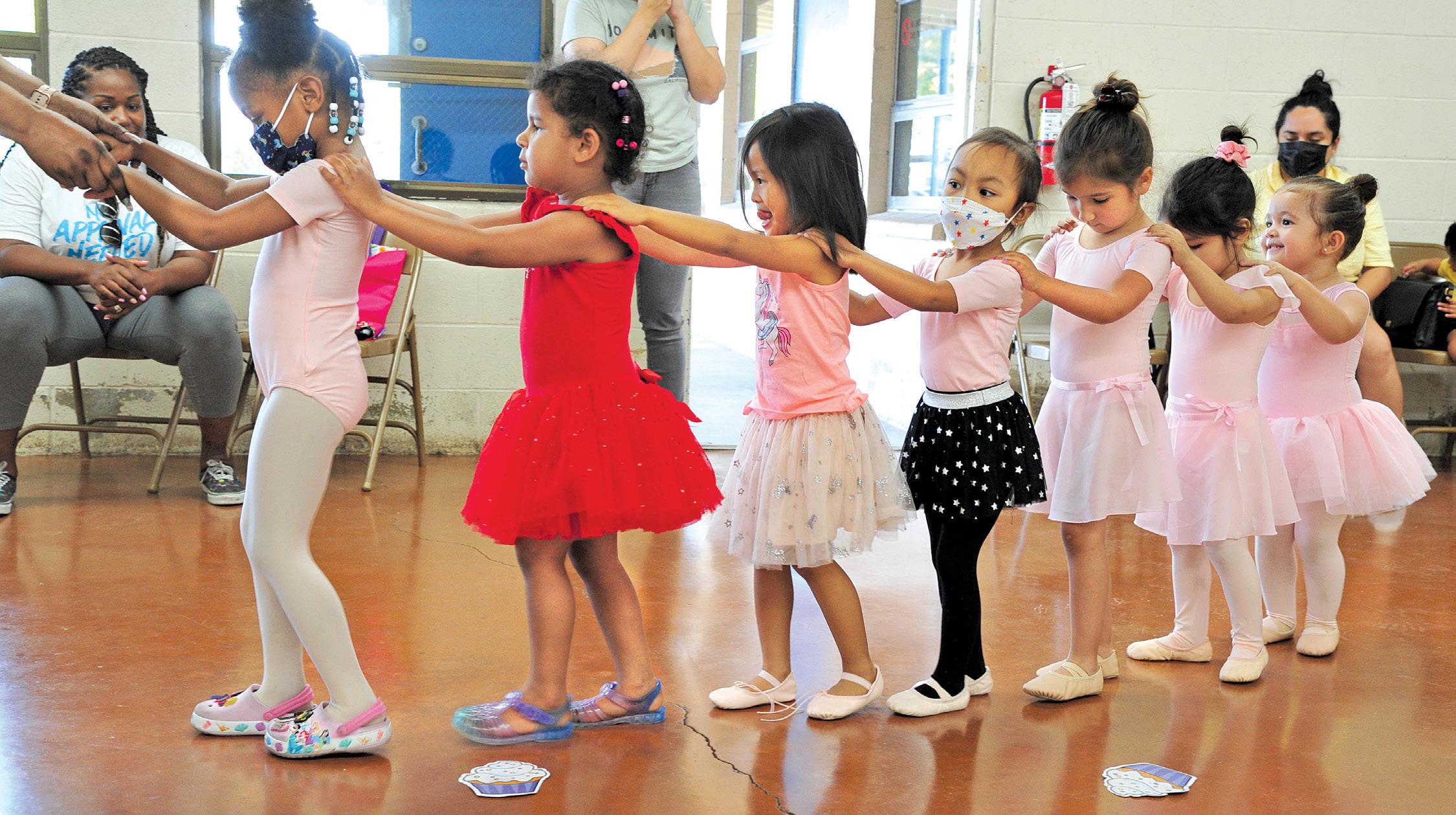
“My parents didn’t want me to play with my brothers, who climbed trees and fences and played basketball,” Tamara says. “So, my mom picked dance and I hated it. I hated stockings, I hated the leotards, the frou-frou costumes with all the sequins, the gloves, and didn’t like anything on my head.”
But she learned to love dance before the lessons ended.
Among her early teachers and mentors was the renowned dance teacher Al Gilbert, who was sometimes called the Pied Piper of Dance for his work with children. Gilbert also taught dance to celebrities, such as Melissa Gilbert and Sally Struthers, the children of Michael Landon, Jean Stapleton and Cher, and a young Michael Jackson of the Jackson Five.
He released a popular dance-instruction series in 1971, under his Stepping Tones record label.
“His music is so fabulous,” Tamara says. “His (instructional) records were in stages; one would graduate you from one record to the next, to the performance. Some parts of my class I teach with his records.”
As with some dance students in the ‘60s and ‘70s, Tamara says she thought dance would be her career ticket. She graduated from Gardena High School in 1976, then bypassed college for the bright stage of professional dancing.
“Way back (in the ‘70s), we used to think, ‘who needs school?
Dance students connect via the choo-choo train line parade around the dance room. Children as young as 2 take part in Tamara Kemp’s Dance One class, which consists of tap and ballet. Tamara has more than 10 dance classes and each class will perform at various Gardena community events.My intent was to always teach children. When you are a dance teacher, your objective is to create dancers. But in recent years, my goal has been more about teaching confidence and instructing them to believe they can do or accomplish anything.
— Tamara KempI’ll just dance,’ as if that was enough,” Tamara says with a laugh.”
Her first break as an entertainer came on April 11, 1978, when she performed with a dance company at the wedding of actor Glynn Turman and Aretha Franklin, the queen of soul music.
In 1984, Tamara was selected as a dancer to join Don Cornelius’ “Soul Train,” which was also syndicated in Japan as “The Japan— Soul Train Connection.” She and other company dancers were sent to Tokyo as performers and ambassadors.
She spent five years teaching English and conversational English and dancing in Japanese commercials.
One of the areas where she and other “Soul Train” dancers spent ample time was in Roppongi, a district of Tokyo known for its nightlife, bars and late-night clubs.
“In the late ‘80s, early ‘90s [the Japanese kids] looked like us, dressed like us, had afros and danced like us,” Tamara says. “They were on top of it. It was like another world.”
She adapted quickly to Japanese culture as a product of Gardena, where she had Japanese-American friends.
“I had the edge over the other [Soul Train] dancers,” Tamara says with a laugh. “They didn’t even know how to use chopsticks. I tried to teach them.”
She returned to the states in the early ‘90s, to attend her brother’s wedding, she says.
Tamara herself has never married, but has been with her life partner, Jerry Oliver, for 28 years.
“I never had kids,” she says. “Back then I was dancing and by the time I got back from Japan, well, I don’t know. (My career) took longer to get going than it should have.”
She considers her dance students as her children.
After studying at ECC, Tamara found employment in the
aerospace industry, she says.
“I had been working in the aerospace industry (for 10 years), Raytheon and Boeing,” she says. “In those industries, you need a degree to move up. They said I needed more than just an AA degree. So, just when I applied for (entrance at a university), I got laid off.”
Undeterred, she moved on to study business science at the University of Redlands, where she earned her bachelor of arts degree in 2012. She obtained her master’s degree, also from Redlands, in 2014.
Today she divides her work days as a part-time senior project coordinator at American Honda Motor Co. in Torrance and for a non-profit group, Black Women for Wellness, in LA’s Leimert Park.
Working two jobs, plus teaching has been daunting.
“It’s a load,” she says. “I’m evaluating my situation and will make any adjustments in the summer.”
For now the thrill of returning to classroom teaching overshadows any physical exhaustion.
Tamara concludes her Saturday dance class by distributing refrigerated Capri Sun fruit juice to refresh her young dancers.
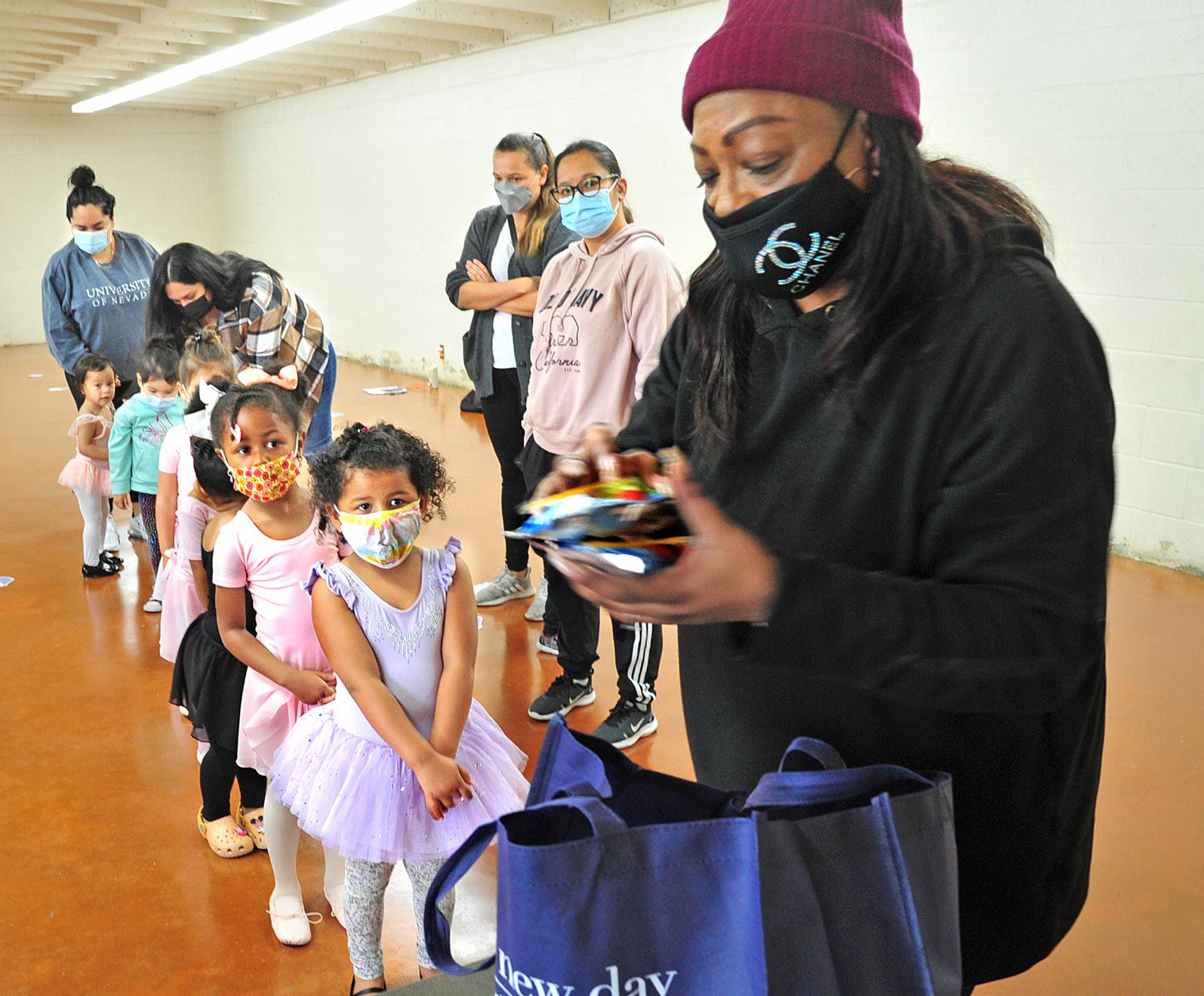
She then spends time conversing with parents, some who have returned with their child for another season of lessons.
“I can tell when somebody walks into the room if they’ve had dance before,” Tamara says. “Just by the way they enter. It changes your posture, your attitude and you become a different person once you’ve taken dance.”
Students line up for drinks at the end of Tamara’s dance classes. Miss Tammy teaches three levels of dance and believes 2 is the ideal age for kids to start dance lessons. She studied dance at ECC, where she earned an associate’s degree in physical education.Doughnuts and coffee are the staple of many American breakfasts. People get a rush of sugar and caffeine before they rush to work or school. The beauty of satisfying your doughnut fix is that a person will never go hungry. There are reportedly 1,500 independent doughnut shops in Los Angeles and here are five close to El Camino College.

Just because White Cup Donuts, a hole-in-the-wall doughnut shop, is located next to Memorial Hospital of Gardena is no reason to dismiss this local fixture. This independent shop features a wide variety of fresh baked doughnuts, breakfast meal offerings, sandwiches, and hot and cold drinks. White Cup also has a menu item called a “cronut” (a marriage between a croissant and a doughnut). The doughnuts in this shop are light, airy, not greasy and very delicious. Two French crullers cost a modest $2.10.
Address: 1149 W. Redondo Beach Blvd., Gardena Phone: 310-327-9277
Hours: Monday-Friday, 4:30 a.m. to 8 p.m. Saturday-Sunday: 5 a.m. to 8 p.m
Rainbow Donuts is a tried-and-true Gardena favorite that has been around for decades and is a popular pick up for the work office, fans have said. There is a wide variety of doughnuts, from maple bars to cake doughnuts, and from Bavarian cream to cinnamon buns. Rainbow also serves breakfast sandwiches, lunch subs, burgers, smoothies, different coffees and cold, bottled drinks. As expected from a 24-hour shop, doughnuts are baked fresh all day. Rainbow’s doughnuts are soft, puffy, sweet and yummy. A chocolate bar and raspberry cost $2.50.
Address: 1242 W. Redondo Beach Blvd., Gardena Phone: 310-719-1625
Hours: 24 hours, 7 days a week.
Donut Master is very close to El Camino College and is tucked into a small storefront in a shopping center next to a Ralphs supermarket. Selection of doughnut types will depend on the time of day, as they close shop at 5 p.m. most days. The doughnuts were tasty and enjoyable overall. Cost for two doughnuts (sprinkled and a raspberry) was $3.10. Donut Master has a breakfast menu and offers many hot and cold drinks. There is an online Donut Master menu, but it's currently being updated.
Address: 2207 W. Redondo Beach Blvd., (No. 3626) Gardena Phone: 310-365-0132
Hours: Monday-Saturday, 4 a.m. to 5 p.m. Sunday from 4 a.m. to 1 p.m.
A hole-in-the-wall shop that would have gone unnoticed but for a recommendation. U.S. Best has a drive-thru option which is novel. The sampled doughnuts (Bavarian cream and raspberry) were excellent— light, soft, ample fillings and reasonably priced, $3. U.S. Best (unusual name?) is the kind of mom-and-pop business that is becoming extinct. Too bad this is not a 24-hour doughnut shop.
Address: 15040 Prairie Ave., Hawthorne
Phone: 310-675-1018
Hours: Monday-Friday, 4 a.m. to 6 p.m. Saturday, 4 a.m. to 5 p.m. Sunday, 5 a.m. to 2 p.m.
Yum Yum Donuts is a 24-hour shop that resides in a previous Winchell’s Donut House on Prairie Avenue near Redondo Beach Blvd., in Torrance. There is a wide variety of doughnut choices on the menu, as well as bagels, muffins and croissants. The coffee and drinks menu is beyond vast (more than a 100 options), plus they serve breakfast and deli sandwiches for those who prefer a meal on the go. A standard glazed doughnut and a glazed twist cost $3.88. The doughnuts were tasty and satisfying. I was treated fine by the server, but noticed that many of the rating dings come from poor service.
Address: 17210 Prairie Ave., Torrance
Phone: 310-371-8114
Hours: 24 hours, 7 days a week
U.S. Best Donuts serves fresh, fluffy and delicious doughnuts every day. Independent shops are still prominent in many neighborhoods.Assistant Coach Ken Talanoa is entering his 21st season as the defensive line coach at El Camino College. Ken has played professional football for the Denver Broncos and Washington Redskins.

If you’ve ever read Linda Ellis’ poem "The Dash," you may recognize the poem’s theme of living your life to the fullest. Ellis uses the dash to signify the bridge between life and death.
When someone looks at a tombstone, they often see the birth and death date of that person. In fact, what people don’t pay attention to is the dash in between those dates. However, life isn’t always sunshine and rainbows.
Human beings are guaranteed to be challenged in life, which may not be pleasant. It is about what you do during the dark times in your life, and how you respond to it.
Some people lead themselves down the wrong road. Some of them choose to learn from those dark days and emerge from the shadows with newfound knowledge, experience, and wisdom to inspire others in a positive way. The dash signifies the life of that person, and how they lived it.
Within the El Camino College Warriors football program, there is a man on the coaching staff who focuses on living life to the fullest and inspiring young men in a positive way, and has been doing so for 20 years. This man exemplifies the dash.
At an imposing 6 feet, 5 inches, his physique may be seen as intimidating. However, he is anything but intimidating. Hiding within his 6-foot-5 inch frame is a warm-hearted man with nothing but good intentions, who comes equipped with life experience.
His name is Kenneth Talanoa, or better known as Ken or K.T., who will be heading into his 21st season in the fall as the defensive line coach. An alumnus of El Camino, Ken also played for the Warriors on the defensive line under the legendary coach John Featherstone during the 1991 and ’92 seasons.
In 2014, Ken was inducted into the El Camino College Athletic Hall of Fame. Additionally, he is part of El Camino’s 1990’s AllDecade team that includes Steve Sarkisian, who played quarterback and went on to coach football collegiately, and in the NFL.
At El Segundo High School, Ken was a star defensive end, and signed a letter of intent to play football at University of Hawaii. He later moved back to California, and played for the Warriors. After
his playing days at El Camino, Ken played at Arizona State on a scholarship, and then professionally for nine seasons in the Arena Football League for the San Jose Sabercats, Arizona Rattlers, and New York Dragons. Additionally, he spent three seasons in the NFL for the Denver Broncos and the then-Washington Redskins, now the Washington Commanders.
During his professional playing days, in the off-season, he would workout at El Camino to lift weights. In addition, Ken attended El Camino practices to pass on knowledge he obtained at the professional level to the players who were playing for Coach Featherstone at the time. Ken’s coaching career launched at El Camino after coming back to bring knowledge back to his roots.
If there is anyone Ken has looked up to over the years and molded his coaching style after, it’s John Featherstone. Featherstone or better known as “Feather,” was Ken’s coach in the early ‘90s, and was well-known for conveying positive lifelong messages that transcended the game of football and instilled self-improvement in his players, on and off the field.
The late Coach Featherstone was not the only man in Ken’s life who played a crucial role. His father was also influential in his upbringing. His father, Aiulu Talanoa was a police officer for the Inglewood Police Department and a Vietnam War veteran, serving in the Army as a paratrooper in 173rd Airborne Brigade.
In June 1991, Ken and his family got together for a barbecue at his grandfather’s house to celebrate the signing of his brother’s professional baseball contract. What seemed to be a joyous celebration, ended in tragedy. Aiulu had been sitting on a chair on the porch when he died from a brain aneurysm. Ken’s brother administered CPR when their father was discovered outside the front door, but the attempt was unsuccessful. Aiulu Talanoa was 47-years old. At the time of his father’s passing, Ken was starting out at the University of Hawaii as a studentathlete to play football.
Ken’s father provided his son with advice that has been useful for the coach in his life and in his job.
“Adapt, improvise, and overcome. Whether it be in sports or
He returned to his roots to give football players opportunities for success
“Me being a Polynesian, I understand the concept of planting more trees because I can’t eat all the fruit. We have to grow trees for the future,”
- Assistant Coach Ken Talanoa
your children. We’re tough people. You will get through this if you stick to the course and believe in yourself,” Ken said about his father. “We never quit. I don’t know how to spell quit. Talanoa and quit don’t go in the same sentence.”
For Ken, football is more than just learning X’s and O’s. He returned to his roots at El Camino to not only coach the game he loves, but serve as a mentor to, and make a lifelong impact on the young men that come into the football program in order to give back to the community, building a foundation the same way Featherstone molded his team of young men for 31 years.
In the game of football, he also makes sure that his team of young men prepare during the week by making the defense accountable, and staying in shape. In order to ensure success down the road, he preaches the message of his players staying proactive by obtaining
an education, taking part in team activities, and be part of the community.
Ken’s love of the game of football has kept him at El Camino, heading into his 21st year, and continues to inspire the studentathletes in the football program.
Since his playing days at El Camino, Ken has been the embodiment of a Warrior both on the football field as a player, and on the sideline as a coach. Of Samoan descent, Ken was born into the Polynesian culture with ancestry and history of fearsome and brave warriors, a cultural value that he continues to uphold on and off the field.
“Me being a Polynesian, I understand the concept of planting more trees because I can’t eat all the fruit. We have to grow trees for the future,” Ken said about developing success for his players
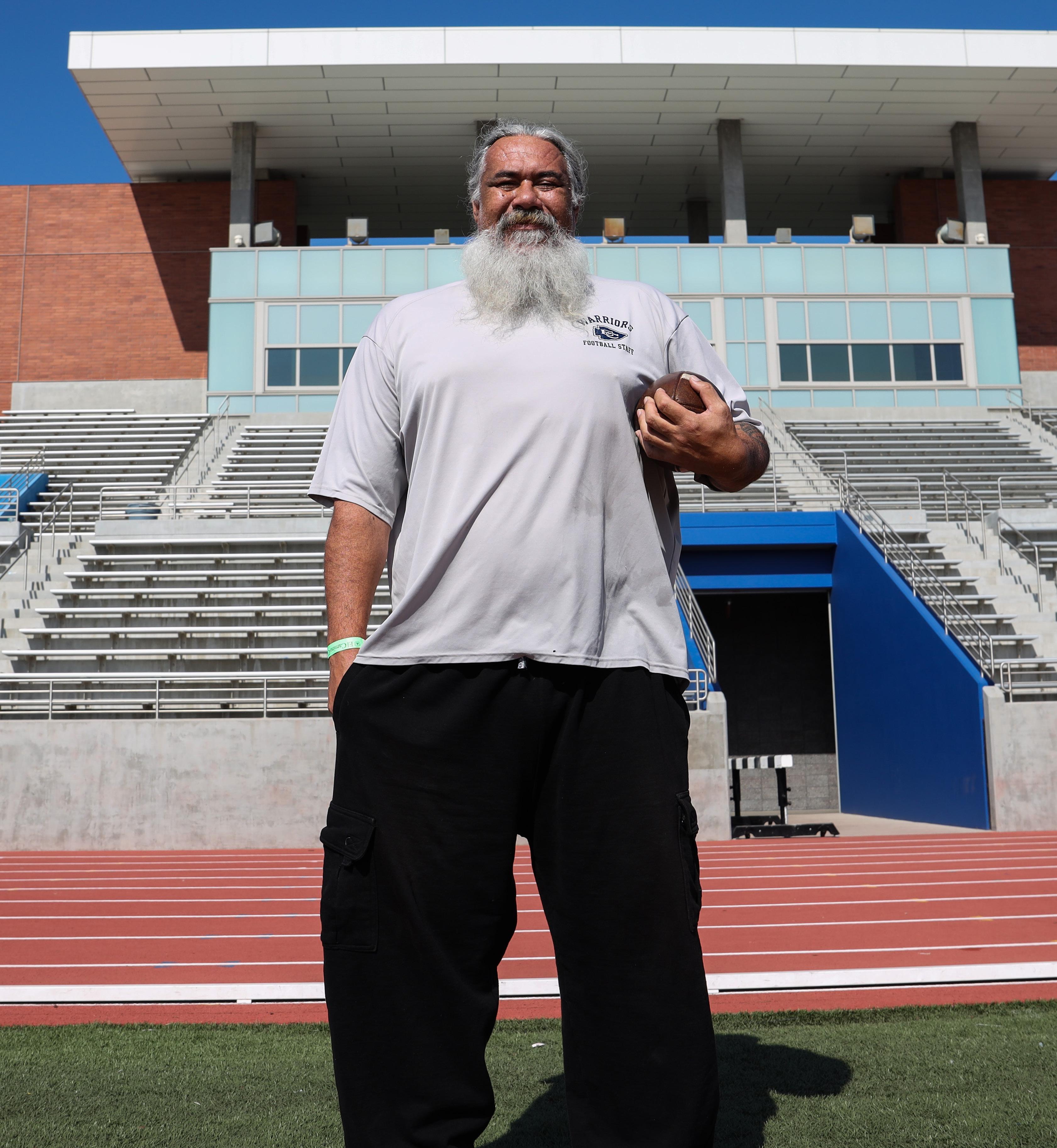 Assistant Coach Ken Talanoa is entering his 21st season as the defensive line coach at El Camino College. Ken has played professional football for the Denver Broncos and Washington Redskins.
Assistant Coach Ken Talanoa is entering his 21st season as the defensive line coach at El Camino College. Ken has played professional football for the Denver Broncos and Washington Redskins.
and for future generations.
He also understands that windows of opportunity will close if his team of young men do not take advantage of opportunities presented to them. The longtime coach is also aware some of the young men he comes across on a yearly basis don’t take the necessary steps to grow into successful human beings.
“Some players don't want that. Instead, they want instant gratification. Players want it right now but don’t want to go through the process or take the time. If you start something, you have to finish no matter what the outcome is,” Ken says.
Growing up, Ken took after his parents and grandparents, who worked very hard. In his youth, Ken and his brothers also followed in their footsteps, staying physically active, and taking action to achieve a task or goal.
“Everything is technology-based nowadays. A lot of these guys are always on their phones and don’t want to do to the physical activity that are required to get things done. I’ve been at El Camino long enough to know that,” Ken says.
On the other hand, he recognizes players who understand the process of achieving a goal, take the time to go through the process in order to be successful, which is what he preaches on and off the field.
These are some of the tools that he wants his players to learn not only on the field, but off the field, because he believes that “if you are going to quit on the field with your brothers, you are probably going to quit in life when things get hard.”
Gifford Lindheim, who succeeded John Featherstone as head coach of the Warrior football program, has been with the team since 2016. Ken has continued to work as an assistant coach in the
Lindheim-era.
“Coach Talanoa is a legend at El Camino. He played here, went on to be successful at the 4 year level and professionally. As long as I can remember, he has been a fixture of the staff and the community. It’s a testament to not only the coach he is, but also the man he is,” Coach Lindheim says of Ken.
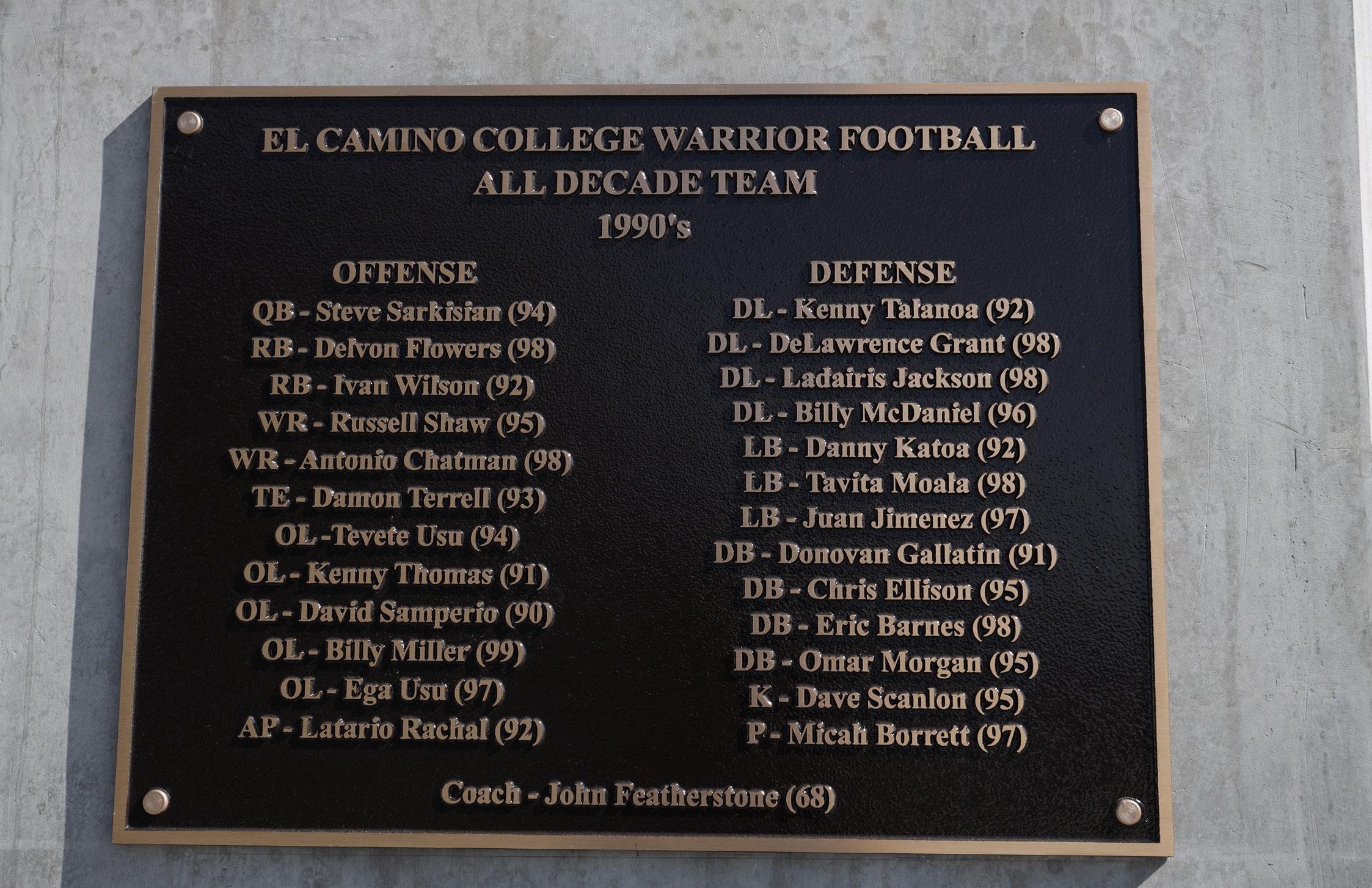
He describes Ken as passionate in all areas of life: in coaching, his family, the El Camino football program, and passion for the community, adding that he has been a pillar of success at El Camino, and an embodiment of a Warrior.
“Warriors are prideful, tough, committed, and hard working,” Gifford says, commenting on Talanoa’s impact.
Ken’s life outside of football includes spending quality time at family functions. Among his family members, there is another Talanoa who was a standout athlete for El Camino.
Shiloh Talanoa is Kenneth’s cousin. Shiloh played softball for the Warriors in 1998 and 2000, and was named All-South Coast Conference 2nd Team her freshman year. In 2000, she was selected for All-South Coast Conference 1st Team, and All-State 1st Team. In June, she is being inducted into the ECC Athletic Hall of Fame.
Like Featherstone and his father before him, Ken continues to offer lifelong lessons and advice to his players on and off the football field.
"I’m just trying to give back to the players, because that's how I was raised by my family and by coach John Featherstone,” Ken says. “If it wasn’t for him, none of this would be possible. He is the reason I am where I am today.”
*Jonte Williams contributed to this story.Assistant Coach Ken Talanoa was named to the El Camino College All Decade team in 1990. In 2014, he was inducted into the ECC Athletic Hall of Fame.
